- Yacht Sales
- Destinations
- Monaco Grand Prix
- About Ahoy Club
- Meet The Team

The Anatomy of a Yacht | Superyacht Terminology
Whether cruising with family and friends or enjoying an adventurous sailing trip, yachts can offer everything you need for the perfect holiday. Before stepping board, it can be useful to familarise yourself with the parts of a yacht to understand the language and terminology used by the crew onboard, and to appreciate how these impressive vessels work. From the keel to the sails, it's important to understand the anatomy of any vessel before setting out on a chartering journey.
The Parts of a Yacht - An Overview
Understanding the parts of a yacht not only improves your sailing experience but will also increase your appreciation of these powerful vessels. A standard yacht has several key parts, including a stern, hull, and bow. The stern, or aft, refers to the back the yacht, sometimes accompanied by a swim platform. On the other end of the vessel, the bow refers to the front of the yacht. The part of the yacht that floats in the water is referred to as the hull. Most traditional yachts have one hull, however catamarans are typically ‘multi-hull' having two points of contact with the sea.
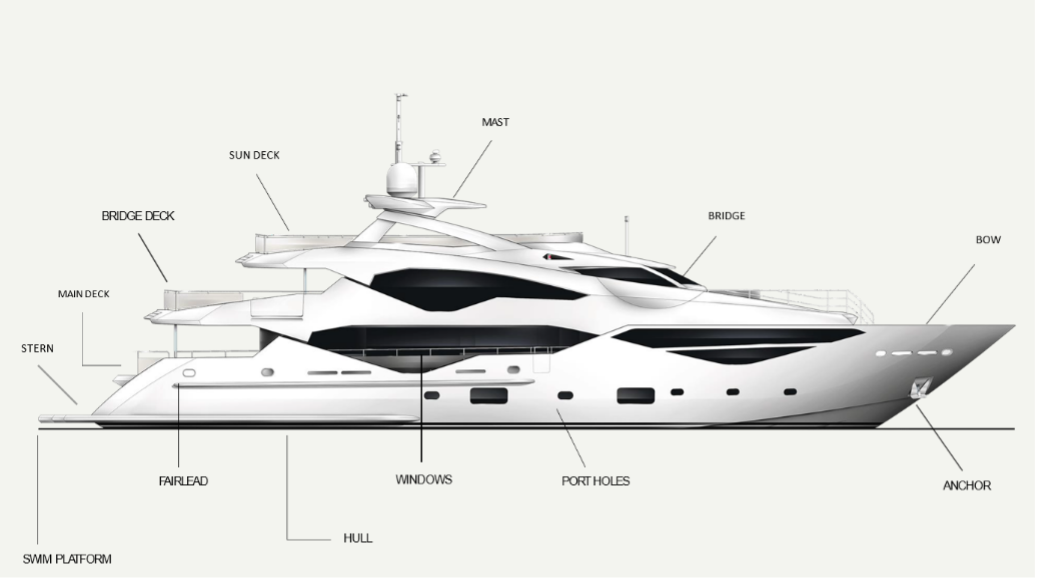
Mischief superyacht was designed with an iconic French navy hull and white boot stipe.
Hulls – Materials and Design
As hulls are one of the largest components of a yacht, it is important that the design is intentional to withstand the elements on the ocean. The material that is it constructed of varies depending on the vessels size and intended use; it is common to see hulls made from wood, steel, or composite materials. Hulls play a crucial role is ensuring stability on board and a smooth journey as conditions on the ocean can vary.
Bridge & Bridge Deck
Port side & starboard side.
These terms refer to the left and right sides of a yacht; Port side refers to the left side, while starboard side is the right. A helpful tip is to remember the saying “there is a little bit of port left in the bottle.” This terminology is often used by crew in order to effectively communicate with their team in order to avoid accidents and safely navigate the seas, so you will likely hear these terms onboard your stay.

Lady Pamela’s large swim platform ideal for fishing or setting off paddleboarding.
Yacht Main Salon and Swim Platform
There is plenty of fun to be had in these two areas of a yacht. The main salon refers to the main living room onboard and is a space where yacht designers can showcase their personality in the design. Often featuring plush seating, stylish decor and high-end entertaining systems, guests can comfortably enjoy downtime relaxing and socialising in this area. The swim platform is exactly what it sounds like; it offers a convenient way to jump in to cool off and enjoy the water. When you feel it’s time to take a dip, the swim platform is the perfect spot to soak up the sun, enjoy the available watertoys , dip your feet in the ocean, or take a refreshing dive or snorkel in the sea.
All of these elements are thoughtfully designed by experts across the world to construct the magnificent yachts that we know and love. We encourage you to experience our favourite vessels for yourself through luxury yacht hire to appreciate the impressive design and craftsmanship. Our team is here to help you plan your dream holiday on board today.
You May Also Like

mischief superyacht

sirenuse superyacht

Luxury Yachts | Choosing the Right Yacht for You
Make an enquiry, make an enquiry.


Parts of a Boat (Illustrated Diagram of a Boat’s Anatomy)
Posted on Published: April 13, 2022 - Last updated: June 13, 2022

Just like a car or truck or animal, there are many parts of a boat, all of which are unique to a boat. When you start boating, it’s a good idea to become familiar with boat anatomy and terms. Not only does it save you from looking like an amateur but it can be a safety issue.
The parts on a boat may vary by boat type. For instance, not all boats have a flybridge. That’s unique to certain types of boats . Below is our extensive series of diagrams setting out the main parts of a boat. We use a series of different types of boats and angles to aid understanding. Below our diagram, we expand on the specifics.
Related: Aluminum vs. Fiberglass Boat | Boat Accessories | Where to Buy Used Boat | Hewescraft 180 Pro V Review | Renting a Boat Slip | Types of Boats | Boat Cost | Hard vs. Soft Top vs. Hybrid vs. Semi Top Boat | Buying a Boat | Parts of a Boat Trailer

Parts of a boat explained
- Bow: the front of a boat.
- Stern: the rear of a boat.
- Port: left side of a boat.
- Starboard: right side of a boat.
- Helm: the driver’s seat.
- Gunwale: the top of the boat’s side (upper edge). If water comes higher than the gunwale, it enters the boat.
- Transom: The cross-section of the rear of the boat (stern).
- Pilothouse: Enclosed cabin for driver and passengers. Not all boats have a pilothouse.
- Cleats: Protruding knobs for tying up boats.
- Fenders: Act like bumpers to protect a boat against a dock or next to another boat. Prevent the boat from bouncing into anything solid. Because I keep my boat at a marina slip with a dock on one side and boat on the other, I have four fenders (two for each side). If you keep it at a dock only, you only need two (or more if a longer boat).
- Flybridge: Open area with additional helm on top of a boat’s cabin. Often includes seating for passengers. Found on cabin cruisers, convertible boats and yachts.
- Handrail: Railing on top of the gunwale.
- Beam: The full width of a beat.
- Freeboard: The distance from top of the water (waterline) to the gunwale (the point where water could flow into the boat).
- Draft: The distance from boat’s waterline to bottom (keel) of the boat. This is the shallowest the boat can enter. If propeller drops below the keel, either need to stay in deeper water or lift the motor up.
- Keel: the lowest point of the hull.
- Bilge: The very bottom of the boat. Water often collects in here which requires pumping out. If water fills the bilge it runs the risk of sinking.
Are there other boat parts?
There are for specific types of boats such as a sailboat. Sailboats have many additional parts and are more complex because of the sails. Ships also have many more parts to them as they are large and much more complex vessels. The above boat anatomy diagram is to set out the parts of a boat commonly found on most boats.
Why don’t you include boat accessories, especially required boating safety accessories?
Boat accessories are not standard parts of a boat. I’ve now bought a ton of boat accessories for our boat. Many are required to have on board (life jackets, fire extinguisher, whistle, manual bailer, etc.) but still, they are not part of a boat. Check out our extensive boat accessories article for tons of ideas to make your boat safer and more fun.
Where can you learn about boating including boat anatomy, safety and navigation?
Where I live, all boat operators must have a boating license. To get the boat license, we must take a course first. I took the BoaterExam course which was excellent. I passed the boat exam on my first try. In fact, I sailed through it. We were given 75 minutes for the exam. I had it done in 20 minutes.
Can you take boat operation lessons?
If you live near the ocean in a populated area, chances are there are powerboat classes and courses you can take where they instruct you on the water. I live in Vancouver and there are such options such as Cooper Boating . In the US, check out the USPowerboating website for course locations and options. Generally, there’s more instruction available for sailing than powerboat operation just because sailing is much more difficult to learn.
What about the parts of a boat trailer?
While tightly related to the parts of a boat, we decided to publish a separate article setting out the parts of a boat trailer here .

PARTS OF A BOAT: BOAT ANATOMY 101
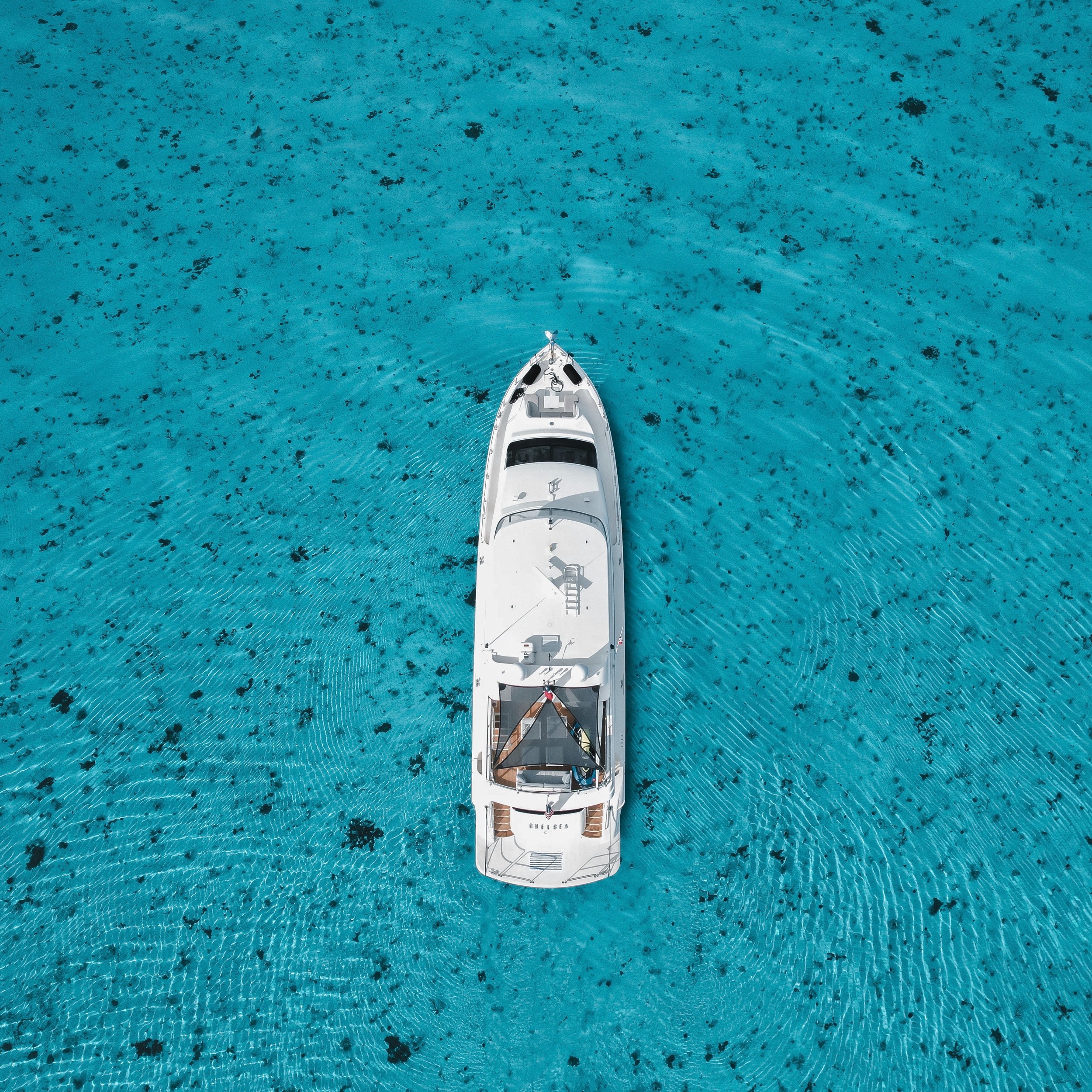
Want to take up boating? Start by learning the nautical terms used to indicate the parts of a boat. You’ll need to know these words before you go on a boat trip, as communication on a vessel is crucial. You can’t waste time trying to describe what you’re talking about; things happen fast.
BOAT ANATOMY
First, we’ll look at the boat parts you’ll find on both powerboats and sailing boats.
The body or shell of the vessel. A portion of it is submerged.
The flat surface on top of the hull. This is where you walk to get around the boat.
The back of a boat. It connects the two sides of the hull.
Gunwale or gunnel
The outermost top edge of a boat hull. This is where the deck and hull come together on most boats.
The width of the vessel at its widest point.
The area of the hull that sits on the water. Often, you measure its length.
The distance between the waterline and keel. It determines the minimum depth of water required for the boat to float.
The distance between the waterline and the gunwale.
The front of the boat.
The back of a boat.
When looking towards the bow, it’s the left side of the boat.
When looking towards the bow, it’s the right side of the boat.
The area towards the bow.
The area at the stern of the boat.
A compartment located in the lowest part of a boat’s hull. It often collects water, which is why you should install one or more bilge pumps.
A heavy weight installed in the hull of a boat to improve its performance and stability. It’s typically made of metal or stone. Sometimes, water tanks can serve as ballast.
The area on deck from where you steer the boat. It’s often enclosed or protected to help you stay on board.
A raised structure on the deck of a boat that holds the helm.
The steering station.
The steering wheel of a boat.
A stick or pole connected to the rudder, which allows you to steer a boat. Smaller and older boats tend to have a tiller, rather than a wheel.
A vane attached to the hull or transom of a vessel, which can steer a boat via a wheel or tiller. If you’re confused about the difference between a rudder, tiller, and wheel, check out this blog post .
A “room” inside a boat. A cabin can be the whole area inside the hull of a boat, or a specific “room” enclosed in that area.
Flybridge or flying bridge
An area located on top of a boat’s cabin. It usually contains the steering station and some seating. It offers great visibility and it’s an excellent spot to cool down in the wind.
A tank where you can store bait or fish while out on the water.
An opening in the deck or cabin which allows light and air to get into the hull.
Navigation lights
The lights mounted around the boat, which allow other vessels to see it at night. We talk about nav lights in more detail in this article .
A rotating mechanical device with blades which propels a boat.
Bulkhead
A wall located inside the hull of a boat, which can provide structural support or divide different cabins.
The kitchen. This is where a cooker and sink are located inside a boat. The cooker or oven are typically installed on a gimbal, so the pans stay level and don’t fall off.
The living room. It’s an area where you can relax. It usually features a dinette with settees (sofas/couches) and a dining table.
The bathroom. On boats, you’ll typically find an electric, manual, or composting toilet. Newer and bigger boats will even have a shower.
A canvas top that provides protection from the elements.
A fixed, solid alternative to a bimini usually made of fiberglass.
A bed or bunk. If it’s located in the bow of a boat, it’s called a v-berth.
Swim platform
A structure attached to the transom of a boat, which allows you to easily get in and out of the water.
The ropes you use to handle the boat.
A fitting made of metal, plastic, or wood on which you can tie a line or loop. It’s designed to allow you to tie the boat to a dock.
Fenders or bumpers
These are “cushions” made of plastic and filled with air, which stop a boat from rubbing against or hitting hard a dock or another vessel.
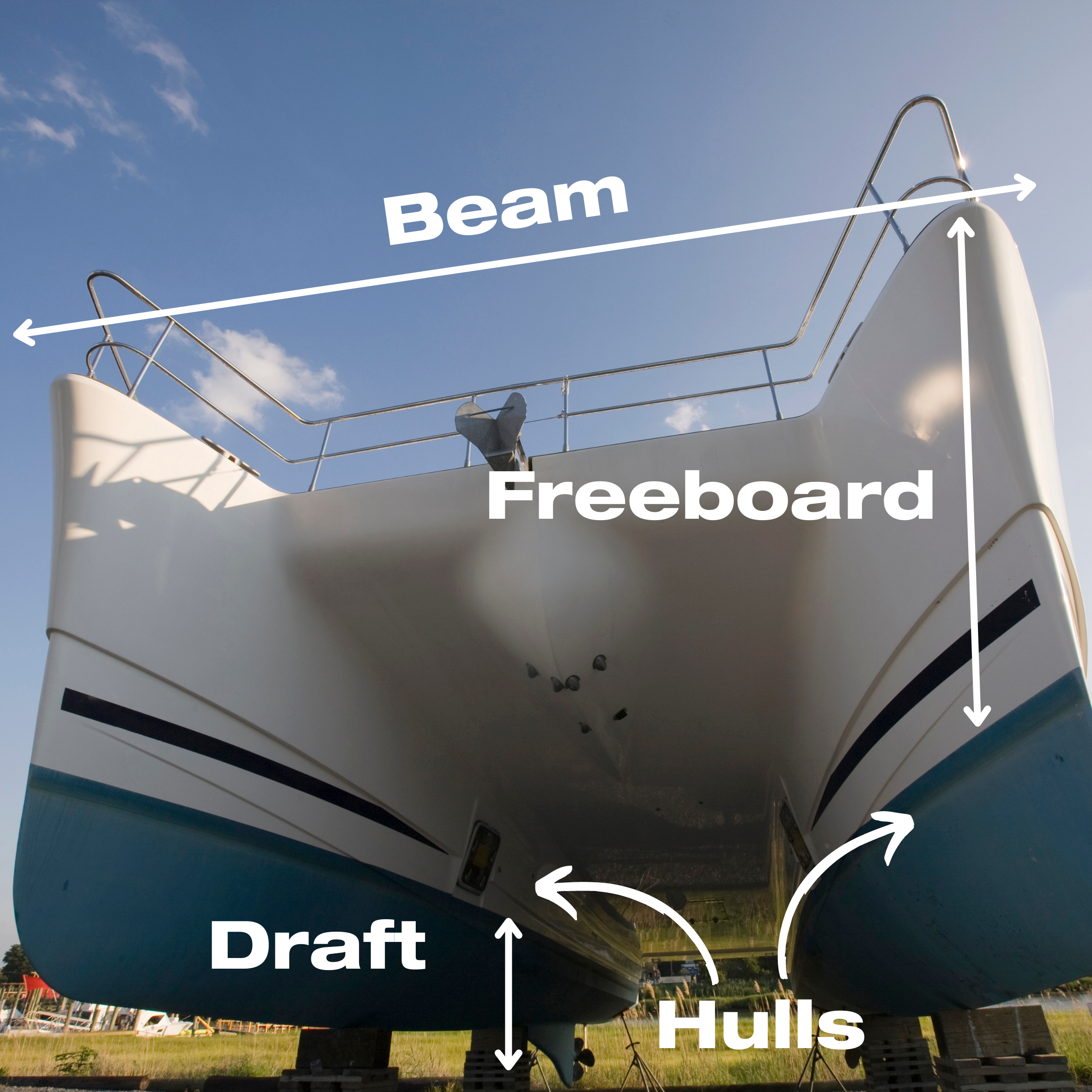
PARTS OF A SAILBOAT
There are specific nautical terms that only apply to sailboats and motorsailers. These vessels are different from powerboats, so they are equipped with some extra gear to allow them to use the wind as a means of propulsion.
Let’s look at the fundamental parts of a sailboat.
A lengthwise structure attached to the base of a boat, which keeps it upright and improves stability. Yachts that lose their keel capsize.
The spar that stands vertically at the centre-line of a sailboat. It supports the sails.
These are pieces of canvas extended from the mast. They are designed to catch the wind and propel the sailboat. If you’d like to read more about the different types of sails you can install on a sailboat, head over to this article .
A pole that’s attached to the mast and extends the foot (bottom edge) of the mainsail.
The wires, cables, or lines found on a sailboat. The running rigging is made up of the lines you use to handle the boat and sails. The standing rigging is fixed in place and holds up the mast.
A drum-shaped device around which you can wrap lines to make it easier to sheet the sails.
A device that allows you to change the spot in which the mainsheet tackle connects to the boat.
Companionway
A hatchway with steps which leads you inside a sailboat (“down below”).
When it comes to sailboats, there are many more nautical terms that describe the parts of a sail, a specific wire of the standing rigging, a type of line, and more. So if you plan to take on sailing, you’ll need to learn a lot more nautical terminology.
Now that you’re familiar with the anatomy of a boat, you can start looking at boating courses and sailing classes near you. Your instructor and peers will probably be impressed with your knowledge and you’ll be able grasp things a lot faster.
BOATING STARTUP DECKEE CLOSES IN ON SERIES A ROUND TO MAKE THE WORLD’S WATERWAYS SAFER
How to read a nautical chart.
Parts of a Boat: Understanding the Anatomy of Your Boat
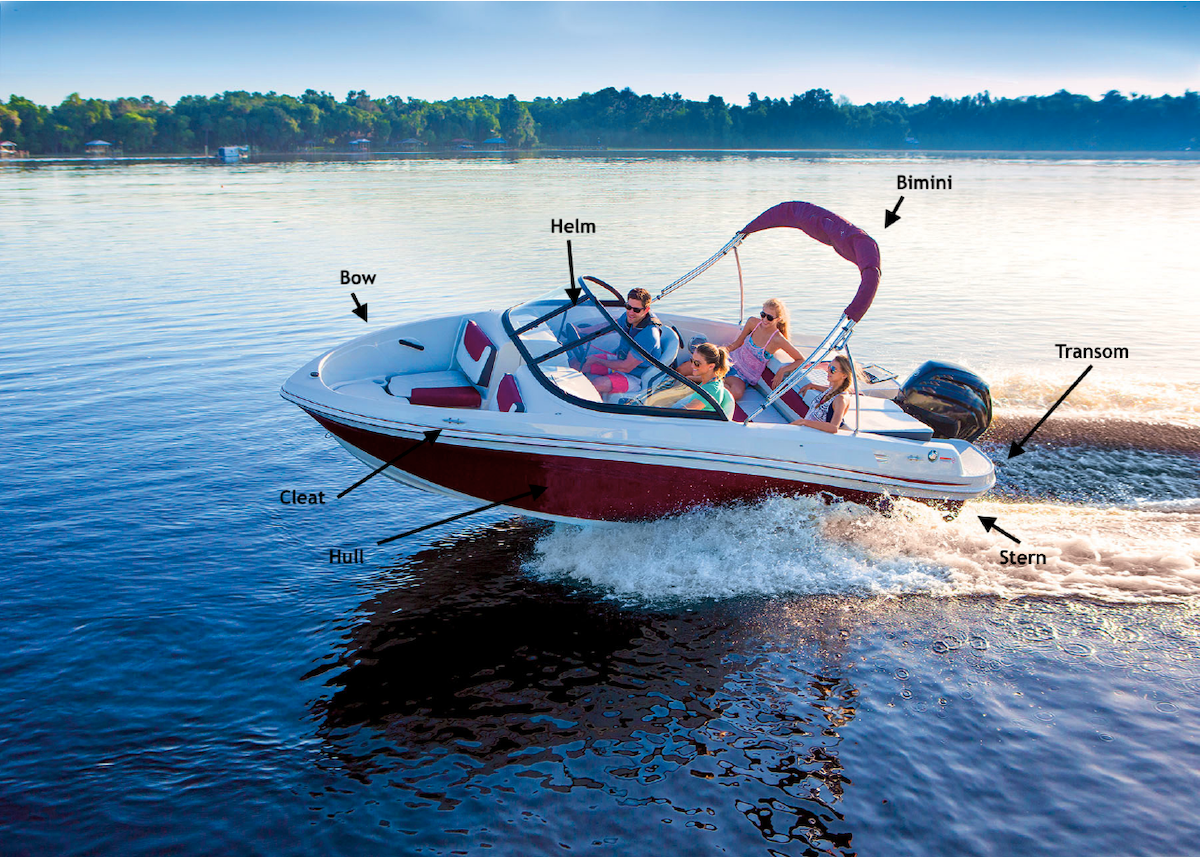
If you want to be a boater, you’ll need to learn a new vocabulary because boats don’t have a front and back, or a kitchen and a bathroom. Here’s a guide to basic nautical terminology, specifically having to do with the parts of a boat.
1. Ballast – Weight in the form of heavy material (water, metal or stone) placed low in a boat hull to improve stability and performance of the boat.
2. Berth – A bed or bunk if it’s in a boat or a slip for a boat to dock in.
3. Bilge – The lowest part of a boat hull that sometimes collects water.
4. Bimini – A canvas or composite (hard) top attached to a boat to provide protection from sun and rain.
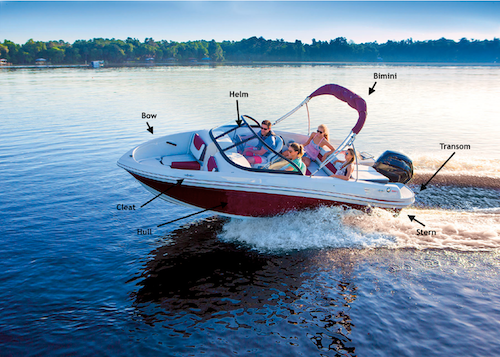
6. Bulkhead – An upright wall within the hull of a boat that may add structural integrity or a separation of living spaces.
7. Cabin – A room inside the boat, which can refer to the entire interior or just one room designed for sleeping.
8. Casting deck/platform – A surface at the front or back part of a boat that’s elevated so you can fish without obstructions and have a better view of the water.
9. Cleat – A wood, plastic or metal fitting onto which you tie or loop a line. This can be on a boat or a dock.
10. Cockpit – A protected, somewhat enclosed space on deck, usually from where a boat is controlled or steered.
11. Console – A raised structure on the deck of a boat that usually holds the helm or steering station and may include a toilet or stowage space in the compartment below.
12. Deck – The exterior flat surface of a boat.
13. Dinette – An area of the boat with a table and seats used for dining.
14. Flybridge – Also referred to as a “flying bridge” this is the area on top of a boat cabin, which usually holds a steering station and sometimes a social space.
15. Galley – A boat kitchen, which may be inside the boat or outside on deck.
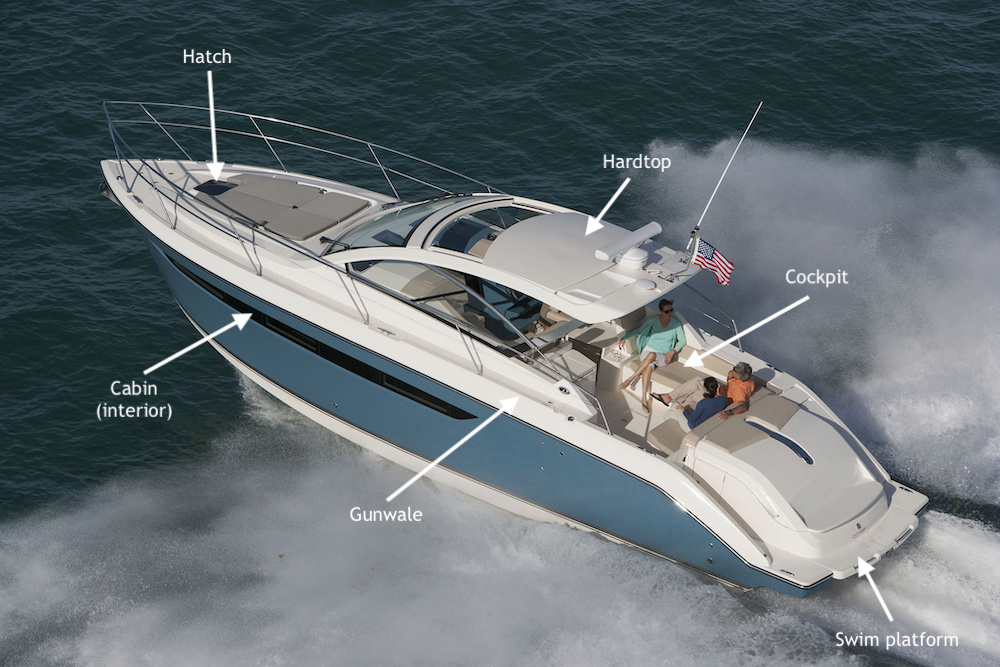
16. Gunwale – Also known as gunnel, this is the outermost top edge of a boat hull, usually where the deck and hull come together.
17. Hardtop – A top or roof added to a boat cabin-top or console. It serves to protect the driver and sometimes also passengers from the elements.
18. Hatch – An opening in the deck or cabin of a boat that serves as a window or door.
19. Helm – The steering station, which includes engine controls and a wheel or joystick.
20. Hull – The body or shell of the vessel.
21. Livewell – A tank designed to keep caught fish or bait alive during fishing.
22. Propeller – A rotating device with blades designed to move a boat forward or backward through the water.
23. Rigging – The wires, cables or lines, which support a mast on a boat.
24. Rudder – An appendage below the waterline that steers the boat.
25. Saloon – A room in a boat that is an interior social space used like a living room in a house.
26. Stern – The back part of the boat.
27. Swim platform – A structure fixed to the transom or aft portion of the boat designed to make getting onto the boat from the water or dock easier.
28. T-top – A metal or composite structure designed to hold a canvas or hardtop to protect the boat driver from the sun.
29. Transom – The back of the boat that comes up from the hull bottom and connects the two hull sides together.
30. V-berth – A bed in the bow of a boat. Since bows are usually pointy, the bed or the room that holds that bed is V-shaped.
Read Next: 10 Nautical & Sailing Terms to Know
You Might Also Like:
- Glossary of Boating Terms
- Understanding Different Boat Types
- Boating Safety Guide
- First-Time Boat Owners: How to Get Started
- Boat Buyer's Guide: How to Buy a Boat

Join Our Newsletter!
Get community news, buying bargains, and how-to guides at your fingertips.
- Inquire Now
- YACHT SEARCH
- Motor Yachts
- Sailing Yachts
- $1 – $25,000 Yachts
- $26,000 – $50,000 Yachts
- $50,000 – $100,000 Yachts
- $101,000 – $200,000 Yachts
- $200,000 – ∞ Yachts
- Virgin Islands
- Leeward Islands
- Turks and Caicos
- Spain & Balearic Islands
- New England
- Tahiti & South Pacific
- More destinations
- Charter Advice
The Guide to Boat Parts and Terminology
Learn some basic terminology to help on your next boating excursion.
Boats offer a great escape from everyday life. Whether you’re sailing across an ocean or sitting back enjoying the view from a charter yacht , being on the water can be relaxing. In order to get the most out of the experience, it is helpful to know the different parts of a boat and have some understanding of how they work. Gone are words like “front,” “back,” “left,” and “right.” Instead, nautical terminology takes over and adds to the enjoyment of being on the water.
Anchor: An anchor is a heavy item that is dropped down into the water, touching the bottom of the body of water and securing the vessel. Usually, the anchor is made up of a ring at one end for attaching the line (rope), while the other end of the anchor has two metal pieces jutting out to the sides to help grasp the floor of the body of water.
Bow: The bow of a boat is the front portion of the hull. As the boat moves ahead, this is the forward portion of the boat. When standing facing the bow, the left side is called the port bow and the right side is called the starboard bow.
Cabin : The cabin is the part of the boat below deck where people can sleep or spend time. It can refer to one single room where a person resides, or it can refer to the entire space where multiple rooms are located.
Deck : The deck is a portion of the boat that sits on top of the hull. This portion of the vessel works as a roof to the hull and is also where much of the work on a boat takes place.
Fenders: Made of plastic or rubber, the fenders prevent a vessel from moving onto a pier. They prevent damage to the boat as well as the pier should the two come into contact with each other.
Gunnel: Also known as the gunwale, this is an edge along the side of a boat. It works to add to the structure and provide strength to the overall design.
Hatch: The hatch is an opening that connects the bottom of the boat and the deck. Some ships have multiple hatches, depending on the design and the purpose of the vessel. Going down using the hatch is also called “going below.” When moving up through the hatch, the term is “going topside.”
Helm: The helm is one of the most important parts of a boat. This is how a person is able to steer the boat or yacht when moving along in the water. In most cases, the helm is a wheel that is used to control the direction of the boat.
Hull : The actual body or shell of a boat is called the hull. This includes several different parts of the structure, including the deck, the bottom, and the sides. It is important to note that it does not include things like the rigging or the mast.
Keel: The keel is a specific part of the hull. It is the main beam that runs from the front (bow) of the boat to the back (stern) and goes through the middle of the vessel. It is one of the main pieces of the structure and is often considered the foundation of a ship or yacht.
Line: A line is another word for rope in the nautical realm. There are several different purposes that lines can serve. Knowing the proper knots used at sea can be helpful when working with line.
Mooring: A mooring is a place where a vessel can be secured. This includes all sorts of locations, including wharfs and piers. It can also refer to the actual lines or anchors that are used in the process of connecting to a location.
Port : The left side of a boat, when you’re facing forward or toward the bow, is known as port. The port side runs all the way from the front of the vessel to the back.
Rigging: Rigging can be found on a sailboat and refers to the lines (ropes) that are used to work the masts, yards, and sails. When a person is going up into the rigging, it is often referred to as “going aloft.”
Scope : The scope is often understood as a formula where it equals the length of an anchor line divided by the depth of water below the ship measured from the deck. While it can be a little complicated to understand, it is important that the scope be correct to ensure that a ship is anchored correctly.
Starboard: The right side of a boat, when you’re facing forward or toward the bow, is known as starboard. The starboard side runs all the way from the front of the vessel to the back.
Stern : The stern is the back portion of the vessel. When a person is moving toward the stern, they are moving aft. However, if the boat is moving backward, it is called astern. When facing the bow of the ship but standing in the stern, the left side is called the port quarter while the right side is considered the starboard quarter.
Superstructure: Any type of structure that is above deck is considered the superstructure of a boat. It is important to note that the rigging is not considered part of the superstructure.
Underside: The underside of a boat is the portion of the hull that touches the water. It is also known as the bottom of the vessel.
Written by Katja Kukovic
Go to Knowledgebase
Set your search criteria to find the perfect yacht
- Alaska Australia Bahamas BVI Caribbean Croatia Florida France Galapagos Greece Indonesia Italy Malaysia Maldives Mexico Mediterranean New England Norway Spain Thailand Tahiti Turkey
- Motor Yacht Catamaran Sailing Boats
- 2 4 6 8 10 12 12+
Search by yacht name
Boat Reviews
- Boats Specs
- Marine Pros
- Boat Insurance
- Boat Warranties
- Boat Transport
- Boat Towing
- Marine Forecasts

Your Ultimate Boating Resource

Understanding Your Boat: Parts and Functions Explained

Boating is an incredible recreational activity that can be enjoyed in various forms, such as fishing, sailing, and water skiing. As a boat owner, it’s essential to understand the different parts of your vessel and their various functions. This knowledge will enable you to operate your boat more efficiently, maintain it properly and handle possible issues that may arise. In this article, we’ll break down the main components of a boat and their respective roles to help you get better acquainted with your watercraft.
The hull is the foundation of any boat, providing both buoyancy and protection to the vessel. It is the main structural element that keeps your boat afloat and defines its shape. There are various types of hulls, such as displacement, planing, and multihull types, each designed for different boating purposes and water conditions. When inspecting or maintaining your boat, always pay close attention to the hull’s integrity to ensure no damage, cracks, or leaks compromise its performance or safety.
The deck is the upper surface of the boat that you walk on and where most of the boat’s operations occur. The construction of the deck can involve different materials such as fiberglass, wood, or aluminum. As with the hull, it’s important to regularly inspect and maintain the deck, ensuring its structural integrity and cleanliness.
Bow and Stern
The bow refers to the front end of a boat, while the stern is the rear end. Each serves a functional purpose in the boat’s overall design. The bow is designed to cut through the water efficiently, reducing resistance when moving forward. The stern’s design and shape influence the vessel’s handling, stability, and performance.
Propulsion System
The propulsion system of a boat includes the engine or motor, propellers or paddles, and the transmission. These components work together to generate the thrust necessary for moving the boat through the water. Depending on the type of boat, the propulsion system may consist of an inboard, outboard, or hybrid engine setup. Maintaining the propulsion system is crucial, as failures or malfunctions can lead to a stranded boat or even accidents on the water.
Steering System
The boat’s steering system allows the operator to control and change the vessel’s direction. This can include a simple tiller system that directly manipulates the rudder or more advanced hydraulic or electronic systems that offer greater precision and responsiveness. Regular steering system maintenance is vital to ensure smooth and precise control of your boat.
Electrical System
The electrical system of a boat is responsible for powering various components, such as navigation lights, pumps, communication devices, and accessories. A vital part of the electrical system is the battery, which stores electrical energy and must be kept in good condition to avoid power failures. It’s crucial to regularly check and maintain the electrical system, ensuring that all wiring and connections are secure, properly insulated, and in good working order.
Safety Equipment
Every boat should be equipped with specific safety equipment, including lifejackets, fire extinguishers, signaling devices, and first aid kits. It’s essential to regularly inspect and maintain your safety equipment, replacing expired items or damaged gear as necessary. Remember, this equipment could save your life or the lives of your passengers in an emergency situation.
Understanding the various parts and functions of your boat is essential for maintaining safety, efficiency, and performance on the water. By learning about the critical components of your vessel, you’ll be better prepared to operate, maintain, and troubleshoot possible issues that may arise. Remember to always follow manufacturer guidelines and consult a professional when necessary. With a solid understanding of your boat’s parts and functions, you can enjoy the endless adventures and memories that await you on the water.
RELATED ARTICLES
Overview of the 2024 sea-doo rxp-x 325, overview of the 2024 parker offshore 2900 cc, what your boat’s beam is and why it matters, power cats of 2024: ultimate guide to the top power catamarans this year, navigating the heat: 10 safety tips for a safe boat ride in the summer heat, latest posts, don't miss, our newsletter.
Get the latest boating tips, fishing resources and featured products in your email from BoatingWorld.com!
What type of wood is used for pier pilings?
What is the difference between a dock and a floating pier, what is the proper technique for pulling a beginner wakeboarder, what does ‘no wake’ mean on a lake, what is the difference between wash and wake, highs, lows, and tidal know-how: a deep dive into ocean currents, 10 essential tips for fishing near private property, the benefits of using a drift sock: guidance for anglers, lure fishing: secrets for imitating live bait and attracting fish, explore the untapped depths of america’s best bass fishing spots, outboard motor maintenance: tips for keeping your engine in top shape, the essential boat tool kit: tools every boater needs, diy boat building: 8 tips and tricks for building your own vessel, the art of miniature maritime craftsmanship: ship in a bottle, antifouling paints: a guide to keeping your boat shipshape, beginner’s guide to standup paddle boarding: tips and techniques, boating for fitness: how to stay active on the water, kayak safety: how to stay safe on the water, anchoring in a kayak or canoe: how to secure your small boat, overview of the 2024 yamaha 252sd, overview of the 2024 tiara yachts 48 le, overview of the 2024 bass cat jaguar sts, 2024 pursuit os 445: an overview, 2024 aquila 47 molokai review, 2024 sea-doo switch 13 sport review, gear reviews, megabass oneten max lbo jerkbait review, fortress anchors fx-7 anchoring system review, fortress anchors fx-11 anchoring system review, fortress anchors commando anchor kit review, fortress anchors aluminum anchors review, stay in touch.
To be updated with all the latest news, offers and special announcements.
- Privacy Policy
Engineering Learn
- Marine Engineering
30 Parts of Boat and Their Functions [With Pictures & Names]
![parts of the yacht 30 Parts of Boat and Their Functions [With Pictures & Names]](https://engineeringlearn.com/wp-content/uploads/2023/07/Parts-of-Boat-1-1024x539.jpg)
Introduction
30 Parts of Boat and Their Functions [With Pictures & Names]: – At the point when you’re new to boating, it can appear as though everybody is speaking in a different language. Furthermore, with the language ranging from everyday words to literal Latin terms, it very well may be hard to sort out the basics! Boats offer a great escape from daily existence. Boats come in many styles and shapes, however, the names of the various parts remain consistent. Whether you’re sailing across the sea or sitting back enjoying the view from a charter yacht, being on the water can unwind.
What is a Boat?
The boat is a small vessel that is utilized for traveling over water, principally propelled by an engine or by oars to move the vessel. The term boat alludes to a wide range of types and sizes of watercraft however is for the most part smaller than a ship, which might be recognized by its bigger size, shape, freight, or passenger capacity. Small boats are regularly found on inland streams or waterways like lakes and rivers or in protected coastal regions. While different types, like whaleboats, were utilized in seaward conditions.
Boats are vessels that can be carried on ships in modern maritime terms. Boat manufacturing techniques vary in their intended purpose, accessible materials, or local traditions. Besides, there are many parts of it that the vast majority don’t know about. Before we get to ride on the water in a boat, we really want to get familiar with a couple of explicit words that are completely used to describe common parts of boats.
Parts of Boat
- Port and Starboard
- Casting Deck
- Swim Platform
- All-round Light
1. Rudder : ( Parts of Boat )
The rudder is the part of a boat steering mechanism that is mounted outside the hull, usually at the stern. The rudder on each boat might look a bit changed, and the kind of hull on the vessel likewise impacts this appearance. In general, rudders seem to be flat plates or sheets, and they frequently look like a fin or blade. Rudders possibly work when the boat is moving. In the event that there’s no moving water to deflect, the rudder can do barely anything to direct the vessel.
2. Propeller : ( Parts of Boat )
A propeller is a rotating or turning device having sharp edges (blades) to move a boat forward or in reverse through the water. It involves a rotating hub and radiating blades, which are set to a pitch to form a spiral and, when rotated or turned, you can apply linear thrust on a functioning fluid. A propeller, known as a ‘screw’ for its form, is a fan-like machinery attached or joined to the stern of a boat. They are accessible in numerous designs and varieties and can be left-hand turns or right-hand turns.
3. Ballast : ( Parts of Boat )
Ballast is a material that is utilized to provide stability to boats and structures. The water from the ballast tank should move in and out to balance or adjust the boat. The reason behind installing this part is to improve the stability and execution of the boat. The ballast is typically placed or positioned in the lower part of the hull, bringing about an exceptionally high center of gravity. You really want a great deal of ballast to keep the boat tight. A boat that doesn’t have ballast will experience issues navigating the deceptive waters.
4. Hull : ( Parts of Boat )
A hull is generally referred to as a watertight body or shell of a boat. It might open at the top, like a sailboat, or it could be completely or to some degree covered by a deck. Gunwales are provided on the upper sides of the hull of the boat. In nautical terms, the waterline is where the hull meets the outer layer of the water. Modern types of boats are built with hulls comprising heavy steel panels welded together.
5. Port and Starboard : ( Parts of Boat )
Concerning the bow of the boat, port alludes to the left side, while starboard refers to the right side. It is the case for vessels with bilateral symmetry that the left and right sides are mirror representations of one another. There is one asymmetrical highlight in that access to boats, ships , and planes is for the most part on the port side.
6. Gunwale : ( Parts of Boat )
The upper edge of the side of a boat is known as a gunwale. Otherwise called a gunnel, this is normally where the deck and rudder come together. On a kayak, the gunwale generally has a wide edge at the top, supported with wood, plastic, or aluminum , to convey the sway.
The reason it is known as a gunwale is that from the earliest days of the naval force, the top edge of the boat was an extremely helpful place to store a weapon to safeguard against foes and pirates.
7. Deck : ( Parts of Boat )
In a boat, a deck is a compartment or a super durable cover over the hull. The upper deck of a boat is the horizontal structure that fills in as the primary working surface, strengthens the hull, and forms its rooftop. This part is typically located on top of the hull where you can walk or work.
8. Bow : ( Parts of Boat )
The area at the front of the boat is generally alluded to as the bow. While taking a look at the bow, the left half of the boat is towards the port. It is critical to know where the bow is to characterize two other common sailing terms, port, and starboard. The name ‘bow’ was given to the front portion of the boat on the grounds that, in medieval ships, the stakes (boards) must be bent or ‘bowed’ to make the curved or ‘bowed’ part of the boat cut through the water better.
9. Stern : ( Parts of Boat )
The area at the back or rear of the boat is commonly alluded to as the stern. At the point when individuals originally referenced the stern of a boat, they implied the port toward the back segment. Notwithstanding, these days, assuming you hear the word stern, it implies the whole back of the boat. Likewise, this part is featured by a white navigation light around evening time.
10. Cleat : ( Parts of Boat )
A cleat is a gadget for securing a rope in a boat. The cleat is generally made of wood, plastic, or metal fittings which are utilized for tying or looping a line. It tends to be tracked down on a boat or dock. These are famous pieces of marine innovation not restricted to sailboats. Be that as it may, cleats are more significant on sailboats than on some other sort of boat.
11. Bilge : ( Parts of Boat )
A bilge is a compartment at the absolute bottom of a boat’s hull that collects or gathers water. In the event that the boat isn’t supported by water, this part will rest on the ground. The boat will sink if an excessive amount of water enters the bilge too fast. To stay away from this, the bilge likewise has a pump that helps eliminate the water collected in the bilge, which is located under the inside of the hull.
12. Bulkhead : ( Parts of Boat )
A bulkhead is a straight wall inside a boat’s hull. Its primary purpose is to forestall corrosion brought about by the water that surrounds your property and goes about as a barrier between it and the water. Their fundamental purpose is to expand the structural rigidity of the vessel. Furthermore, it creates a watertight compartment that can hold water in case of a hull break or other leaks. Bulkheads are likewise built with resistance to fire to receiving compartmentalization, an uninvolved fire security measure.
13. Casting Deck : ( Parts of Boat )
A casting deck is a flat surface on your boat that is utilized to acquire stable footing without any obstruction while you fish in your chosen waterway for a better view. Forward casting decks frequently have storage capacity or a live well beneath, perhaps a casting seat mount, alongside a molded toe rail for further improved safety and security.
14. Cabin : ( Parts of Boat )
A cabin is a room inside a boat, alluding to the entire interior of the boat. Basically, cabins are rooms on boats, despite the fact that they are designed and intended for sleeping. Many luxury yachts regularly serve 10-12 visitors with no less than 4-5 cabins.
15. Cockpit : ( Parts of Boat )
A cockpit is an area where the boat’s controls are located. Modern boats might have an enclosed or encased cockpit as opposed to an open well on the deck outside a deckhouse or cabin.
16. Gallery : ( Parts of Boat )
For the most part, the gallery in a boat alludes to the kitchen. The kitchen might be located inside the boat or outside on the deck, contingent upon the design of the boat.
17. Bimini : ( Parts of Boat )
It is a canvas or composite top attached or joined to the boat to give protection from the daylight. As a protection from the sun, it gives no protection from wind, downpour, or spray while moving at any speed. This top possibly gives protection when the boat is stationary, and there is no wind. Notwithstanding its functional capability, it can likewise be personalized and arrived in various colors to fit different boats.
18. Flybridge : ( Parts of Boat )
A flybridge is an area on top of the cabin of a boat, for the most part containing a steering system and in some cases a social space. The boats which are larger, it is typically a raised second bridge placed on top of the superstructure, which has a steering wheel navigational instruments and can likewise be utilized as a seat and area of storage.
19. Dinette : ( Parts of Boat )
The dinette is located or situated in the middle or center of the boat, where the table and seats are used for having food. It is a flexible piece of furniture every now and again found on narrow boats and some wide-beam canal boats as well. A dinette is generally made out of a table and two to four seats. Its functional capability is to provide a seating or dining region, and little things can likewise be stored under the seating units. A few dinettes can likewise convert into single or twofold beds.
20. Saloon : ( Parts of Boat )
A saloon is a room built or incorporated into a boat that is an inner social space utilized as a living room in a house. Likewise, it is additionally known for a yacht cabin area that is dedicated to seating relaxation, frequently combined with a dining table.
21. V-Berth : ( Parts of Boat )
V-Berth is a bed in the bow boat. By and large, these beds are three-sided because of the shape of the hull, albeit most have a three-sided notch cut out of the middle of the aft end, making them more like a V-shape. This notch can typically be filled with a detachable board and cushions, forming a twofold bed. Like any regular bed, a V-berth requires some degree of comfort on the off chance that you are to enjoy your sleep.
22. Hatch : ( Parts of Boat )
A boat hatch is the covering/entrance through which the storage, freight, or extra living space within a boat can be accessed from your boat deck. Likewise, it is an opening in the deck or cabin of a boat that serves as a window or door. The main purpose of hatch covers is to prevent water from entering freight holds and to safeguard the freight from getting wet and damaged. A well-constructed hatch ought to be waterproof, supporting the weight of individuals as well as objects that are placed on it.
23. Console : ( Parts of Boat )
A raised or elevated structure on the deck of a boat that generally holds the helm or rudder as well as steering station and may include or incorporate a toilet or stowage space in the compartment underneath.The boat console likewise houses the ignition, trim controls, radio, and other electronic gear, switches, and so forth. Additionally, it allows simple access or admittance to the bow, stern, and sides of the boat. In larger center console boats, smaller berths may likewise be located inside the console and underneath the deck. A center console is typically powered by an outboard motor and may have a couple, or even five, on account of an exceptionally large model.
24. Helm : ( Parts of Boat )
A helm is a steering and controlling station comprising engine controls and a wheel or joystick. The helm is generally located on the right or starboard side on the grounds that the vast majority of people are right-handed, making it more easy to control the boat. It’s vital to keep the helm in great condition.A multifunctional helm can prompt serious mishaps, so it’s important to ensure that it is always working in a proper way.
25. Livewell : ( Parts of Boat )
A Livewell is a kind of storage tank designed and intended to keep live fish or bait caught while fishing. This device effectively keeps the water aerated and pumps fresh water from adjacent water bodies into the tank. The strategy for deciding the necessary size of a Livewell is that every one-inch-long fish requires one gallon of water. Also, they are two other significant factors in Livewell’s functionality maintaining appropriate temperature and eliminating metabolic waste.
26. Rigging : ( Parts of Boat )
Rigging comprises a system of ropes, cables, and chains that help and support the masts of a boat. Ragging is additionally divided into two classifications, standing and running. The standing rigging supports or upholds the mast, and the running rigging controls the direction and orientation of the sails and their degree of reefing.
27. Transom : ( Parts of Boat )
The transom is found at the rear or back of the boat, comes up from the lower part of the hull, and connects or interfaces the two hull sides together. This is the area of the boat where the motor is attached. In pontoon boats, the transom is normally metal and is located at the stern. This is essential on the grounds that the transom extends the existence of the boat’s rear or back material while maintaining the stern to support the additional weight.
28. Swim Platform : ( Parts of Boat )
Swim platforms are fixed to the transom or rearward part of the boat to facilitate passage and exit from the water. It provides a place to board a boat when fastened aside or stern. They are designed and intended to make it simple to get on and off the boat and can go about as a staging platform for water sports.
29. Fender : ( Parts of Boat )
In boating, a fender is a bumper utilized against a jetty, wharf wall, or different vessels to retain the kinetic energy of a boat. As it shields ships and berthing structures from damage, it is utilized on a wide range of boats, from freight boats to journey boats, ships, and personal yachts.
30. All-round Light : ( Parts of Boat )
An all-round light is a white light installed on a boat that shines or sparkles persistently on the horizon in an arc of 360 degrees. These lights permit you to figure out which direction the boat is going. Furthermore, this light goes about as an anchor light when the edge light is wasted.
In the wake of knowing these parts, in an emergency, you use them to save your life and others. However, on the off chance that you don’t have the foggiest idea about these parts and their functional capability, you can not operate them. Whether you’re cruising around the lake or sailing across the ocean, make certain to find an opportunity to see the value in all the hard work that went into building your vessel. The boating world operates on a different level in comparison to your everyday life.
Most boating terms address a long history of the activity. There are specialized parts of a boat and terms to clarify all that for do with boating. For a newbie, this can be hard to understand. Hence, it’s great to get to know the basic boating terms. The information we discussed about above explicitly focuses on boat parts and does exclude details that are relative to ships. Understanding boat terminology will permit you to effortlessly understand different boaters.
Image Source: – aceboater
You may also like...
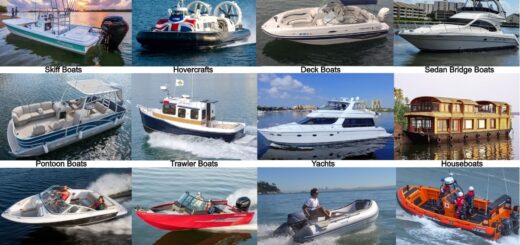
15 Types of Boats – Essential Boat Safety Tips [with Pictures & Names]
July 9, 2022
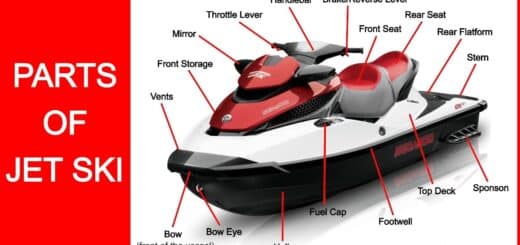
32 Parts of Jet Ski and Their Uses [with Pictures & Names]
May 13, 2023
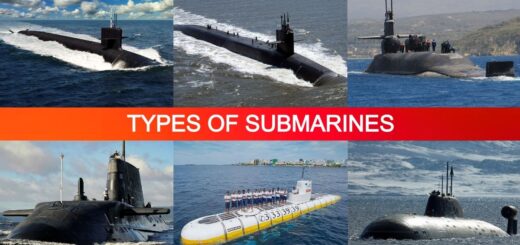
5 Types of Submarines – [Explained with Complete Details]
January 11, 2023

Blow Molding: Definition, Types, Process, Advantages & Disadvantages [Complete Details]

Ladder Truck | What are Ladder Trucks? | Aerial Ladder Trucks | Benefits of Ladder Trucks | Limitations of Ladder Trucks

Party Bus: 10 Best Party Buses in World [With Pictures & Names]

20 Types of Car Brands and Their Logo – [With Pictures & Names]

17 Advantages of Steel and Their Uses in Construction – [Explained]

27 Parts of Tank and Their Uses [With Diagram, Pictures & Names]

17 Parts of AC (Air Conditioner) – With [Functions, Diagram Names & Pictures]

18 Parts of Boat Trailer and Their Diagram [With Pictures & Names]

14 Parts of a Lamp and Their Uses [Explained with Diagram]

15 Parts of Door Knob/Lock and Their Functions [With Pictures & Names]
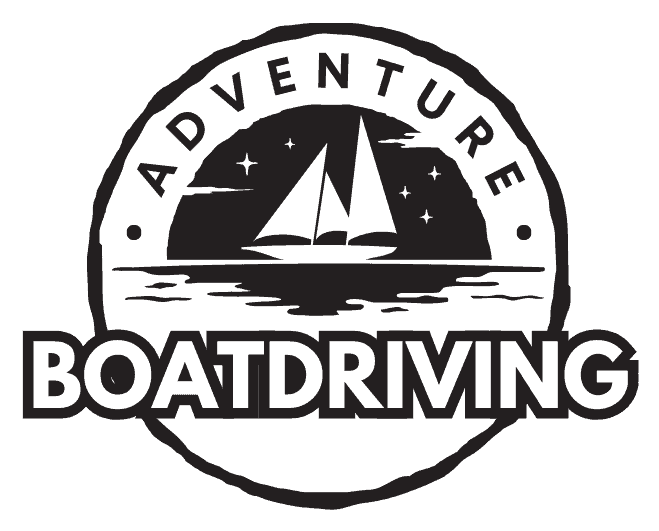
42 Main Parts of Boat (Name & Terminology)
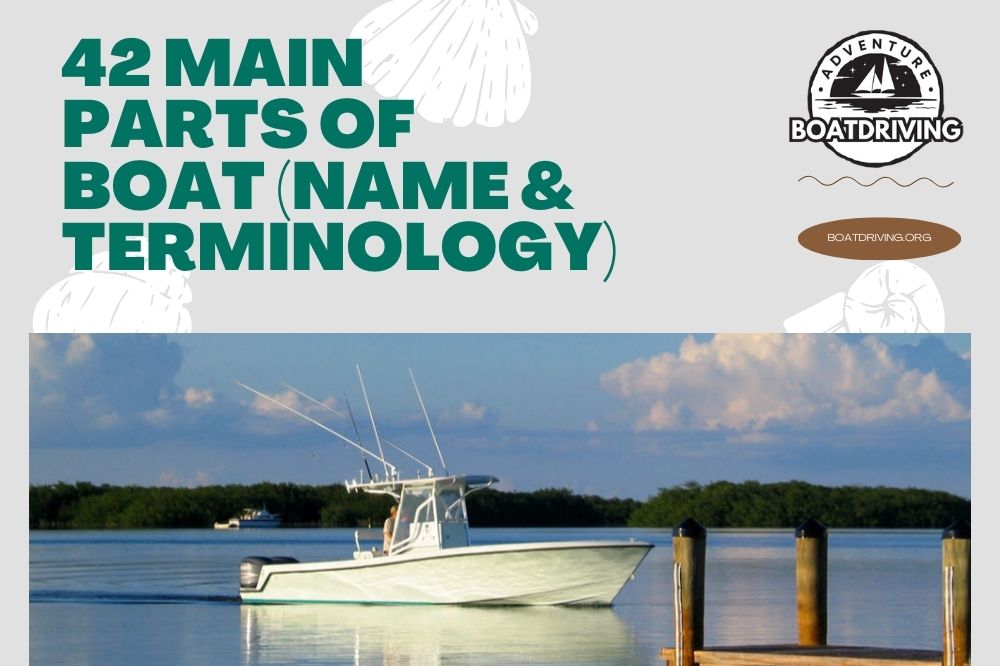
When you’re new to boating, it can seem like everyone is speaking a foreign language. And with the jargon ranging from everyday words to literal Latin terms, it can be tough to figure out the basics! That’s where we come in. We’re going to guide you on the most important boating parts and terminology. Once we’re done, you’ll be chatting on the docks like a pro!
Section One: Boat Parts
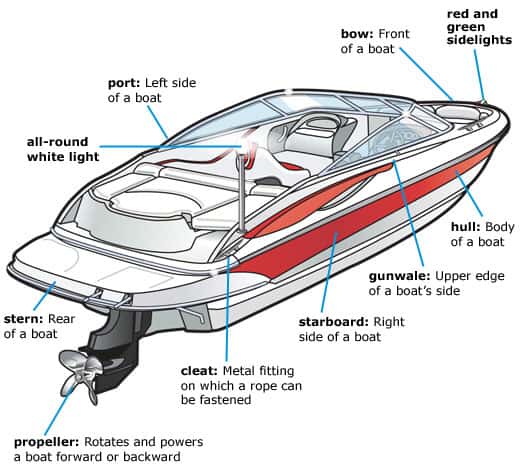
We’ll start with the crucial parts of a boat. Some of these parts can be found in ships too, but we’re staying with the basics. For reference, a boat is smaller than a ship and mostly operates in-shore with oars, propellers, and/or a small motor . To put it simply, a ship can carry a boat, but a boat can’t carry a ship. We’ll look at the typical parts of speed boats and sailboats.
Let’s begin with the directional parts of the boat : up, down, left, right, front, and back.
- Bow – front part of the boat
- Stern – back part of the boat
- Port – left side of the boat
- Starboard – right side of the boat
You can tell which side is port and which side is starboard by looking at the lights. The portlight is red and the starboard light is green. You can also use this information when you’re thinking about right-of-way in boating. Just like traffic, green means go and red means stop.
So the boat that’s on the starboard side (i.e. the boat that’s on your right) always has the right of way. Now let’s name the boat parts from the bottom to the top of the boat. Think of scanning the boat with your eyes, starting at its highest point and working your way down.
- Bulkhead – the ‘side walls’ of the boat
- Gunwale – sometimes called the gunnel, it’s the bulkhead
- Deck – the upper surface where you sit or walk
- Hull – the outer bottom of the boat, it’s the part that touches the water
- Bilge – the inner bottom of the boat above the hull
- Keel – the spine or backbone of the boat, it stays underwater
- Transom – the outer part of the stern where you attach an outboard motor
- Aft – the inner part of the stern where seats and gear are placed
- Forward – the inner part of the bow where seats or harpoons are placed
- Beam – the width or breadth of the boat at its widest part
- Freeboard – the physical distance between the gunwale and the water’s surface
- Line – another name for rope or rigging on a boat
Next, we’ll look through the functional parts of a typical boat, whether it has sails or engines.
- Anchor – a heavy device that sinks to the waterbed to hold the boat in place
- Helm – the steering wheel , bridge, or console that controls the boat
- Cockpit – another name for the enclosed area that steers the boat (console, bridge)
- Cleats – metal fixtures where you tie your docking lines
- All-round light – a white light that illuminates the whole boat
- Propeller – a submerged rotor that moves the boat forward (aka prop)
- Cabin – that’s the section where you sleep, often under the deck
- Galley – the kitchen of the boat, usually below deck
- Head – the toilet section of the boat, usually below deck
- V-berth – a v-shaped bed in the cabin that often folds into a chair or table
- Fenders – removable side cushions that are plastic or inflatable buoys
- Hatch – a door or gateway that lets you access the lower or inner parts of the boat
- Rod holder – think of cup holders, but these are for fishing rods
- Livewell – a section filled with water for storing live fish
- Swim platform – a flat section at the stern where you can get into or out of the water
Okay, now we want to talk about how the boat moves, whether it uses a sail or an engine, sometimes both. Just to be clear, all boats have propellers, but this could be a ski, outboard, inboard, stern, or duo propeller. We’ll go into detail in section two. For now, let’s talk sails.
Sailboats have the same parts as speed boats , but they also have extra parts. These include sail cloths and other functional components that facilitate analog sailing. Let’s check out some of these parts below. We’re going to focus on the most common parts and their roles.
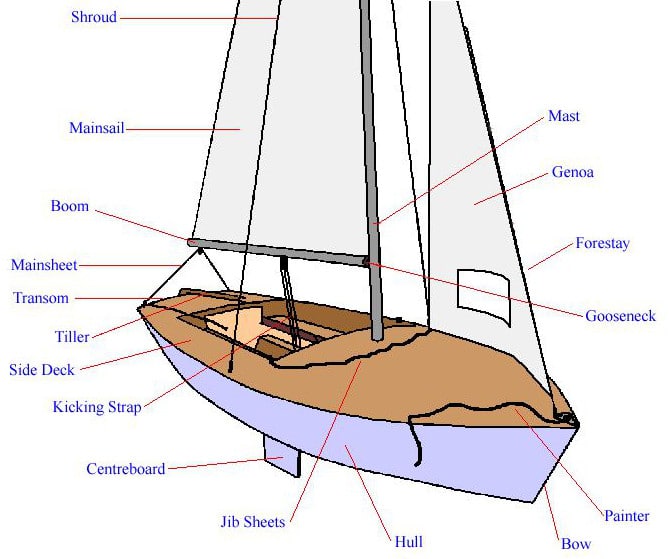
- Mainsail – the largest sailcloth
- Staysail – the smaller sailcloth, sometimes called a jib or genoa
- Battens – horizontal shafts that weave through the sailcloth to stiffen it
- Mast – the vertical pole that holds the sail cloths
- Boom – the horizontal pole that holds the sail cloths
- Gooseneck – the right-angled swivel joint between the boom and the mast
- Centerboard – a submerged section of the keel that juts downward in the middle
- Rudder – a submerged section of the keel that juts downward at the stern
- Tiller – a handle on the rudder that lets you steer the boat
- Pulpit – safety guardrails at the bow
- Pushpit – safety guardrails at the stern
If you’re looking at a sailboat (or a picture of one), you’ll notice lots of rigging. And yes, each rope has a name and a function. But they’re pretty technical, so we won’t get into that. For now, just know that sailboat ropes include a foresta y, backstay, kicking strap, and painter.
Section Two: Boating Terminology
Now that you’re familiar with the basic parts of a sailboat and speed boat, we’re going to look into the boating terms you’ll hear around the dock . You might hear them at a boat shop too, or in boating forums. Here’s a simple glossary. You’ll never feel out of your depth again!
1. The A-terms
Newbies sometimes feel boaters are ribbing them by just adding a- to everything. But these words do have meanings. Astern means steering in reverse. Ahead means moving forward. Adrift means loose and uncontrolled. Aground means unintentionally scraping the waterbed.
2. Outboard Engine
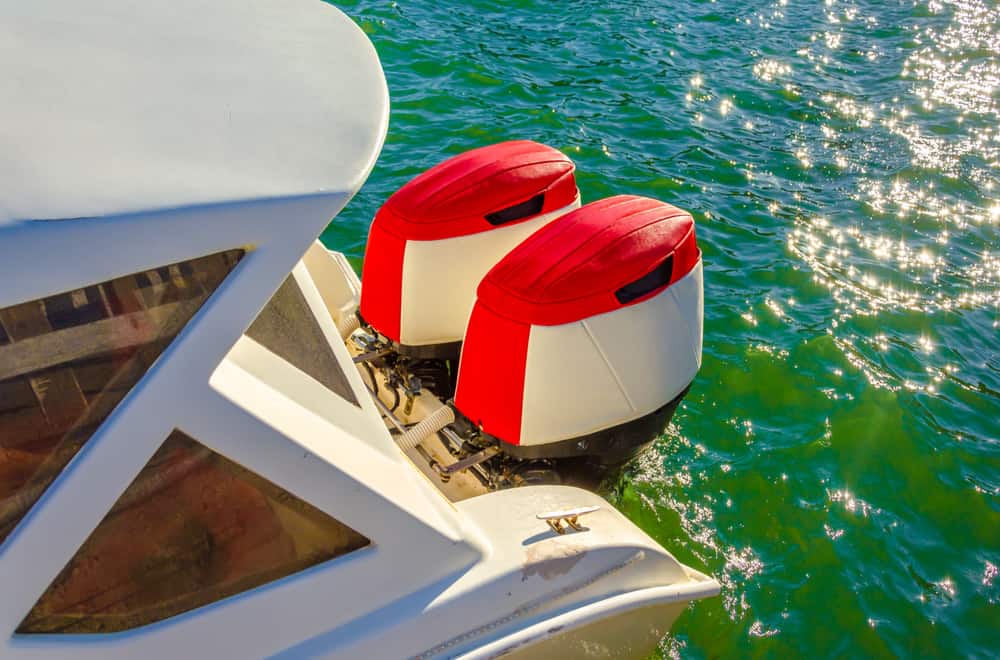
This is a type of external motor that’s visible on the surface of the boat. Outboard motors are usually attached to the transom at the back of the boat. They’re sometimes used to steer the boat. The number of outboard motors affects the knots and horsepower of your speed boat.
3. Inboard Engine
This is when the motor is hidden in a closed compartment. Inboard motors are often modified car engines that are placed in the hull and covered by the deck, with a door or hatch for engine access. You can’t use inboard motors to steel, so they’re connected to propellers.
4. Stern Drive Engine
We’ve mentioned that on some boats , you can use the outboard motor as a steering shaft. But this is only for stern drive engines where the tiller is attached to the rear motor. On ordinary outboards, there’s no steering mechanism connected to the transom engine.
5. Waterline
When a boat touches water, the bulk of the boat is above the waves while a smaller section stays submerged. The border between these sections is called the waterline. It’s the visual spot where the boat touches the topmost surface of the water body, leaving the hull below.
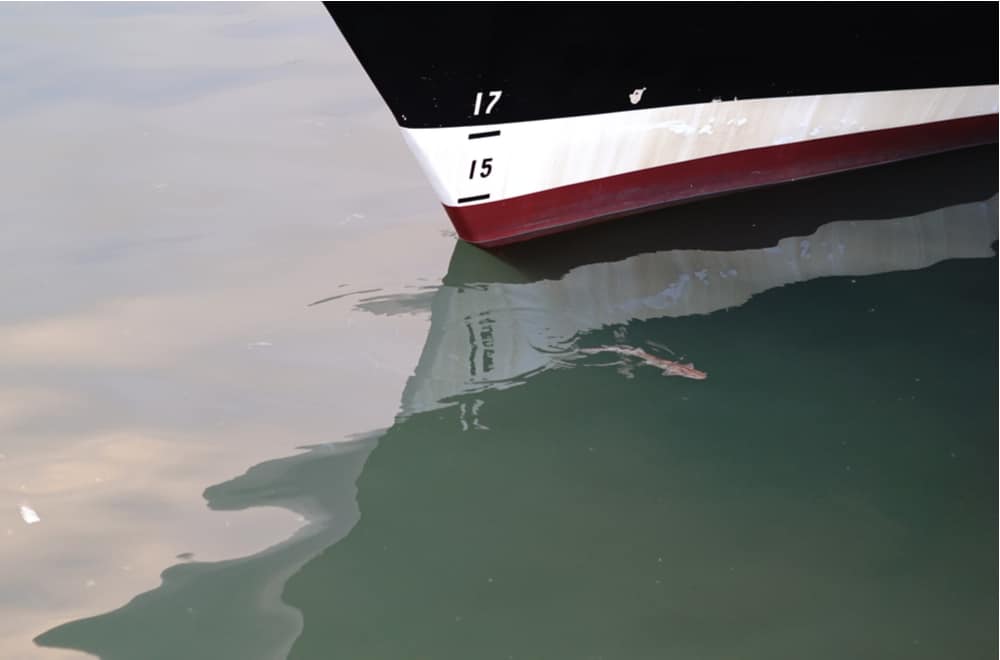
You can physically measure the part of the boat below the waterline. That distance is called the draft , and it describes how low the boat sits in the water, and how much of the boat stays submerged. Shallow draft boats (like pontoons) have 8 to 10 inches underwater at any time.
This term describes the shape and angle of the hull as it moves through the water. It can be defined as flat or round, soft or hard, with lots of overlap between. Round chines have a gentle curve (as opposed to flat hulls). Hard chines have a sharp or drastic angle e.g. V-hull.
8. Skinny Water
This is an area of shallow water where the waterbed (i.e. the ground at the bottom of the sea, ocean, pond, etc.) is roughly a foot below the surface. You’ll find a lot of skinny water inland (lakes, rivers, swamps, etc.) but you can also find skinny waters in bays, docks, or islands.
9. Choppy Water
This is deeper offshore water that’s often rough and full of waves. The currents are stronger so you need a boat that can handle these conditions. Pontoons don’t do as well in choppy water, but they rule the roost in skinny water, so that’s something to be familiar with.
10. Rigging
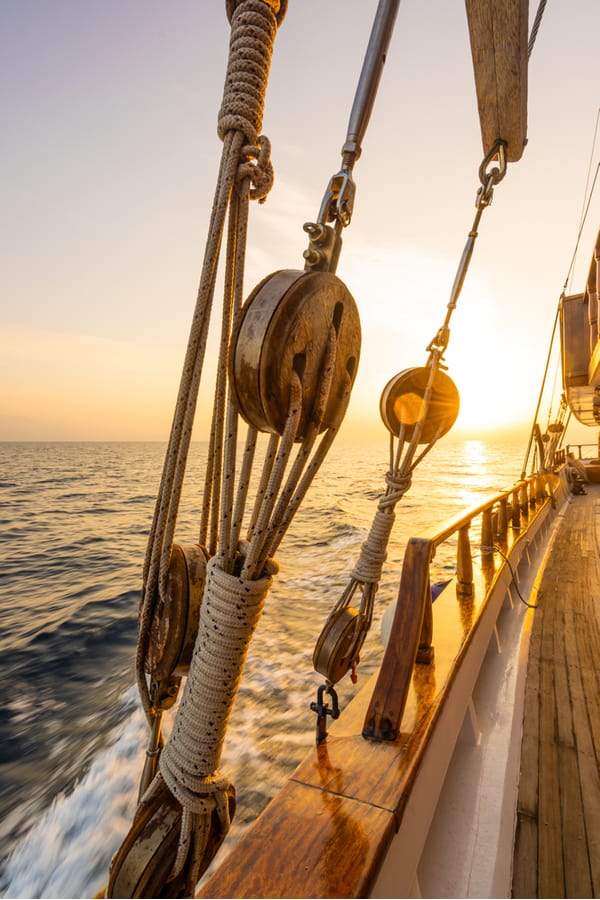
We mentioned this when we were talking about sailboat parts. The rigging is the grab-all term that describes the rope-work on any boat, but particularly a sailboat. If you’re climbing the rope-work to scale the sail, it’s described as ‘going aloft’. You’ll need to know your knots!
When you’re dropping your anchor , it’s isn’t just a matter of releasing it and you’re done. You should calculate how much of the rope or chain you need, depending on the size of your boat, depth of the water, and condition of the waterbed (rocky, sandy, etc.) This figure is the scope.
12. Mooring
The mooring is the place where your boat goes to sleep. This could be a pier, a dock, a boatyard, or even the backyard docks on waterfront properties. Sometimes, mooring means anchors and lines. But if you use it as a verb, mooring is the process of docking your boat .
13. Set the Anchor
When you drop your anchor, it helps to confirm it has a solid hold on the waterbed. Otherwise, the next time you check, your boat is gone! This process of reinforcing the anchor is called setting. Set the anchor by tugging it or by reversing the boat for 45 to 60 seconds.
14. Right of Way
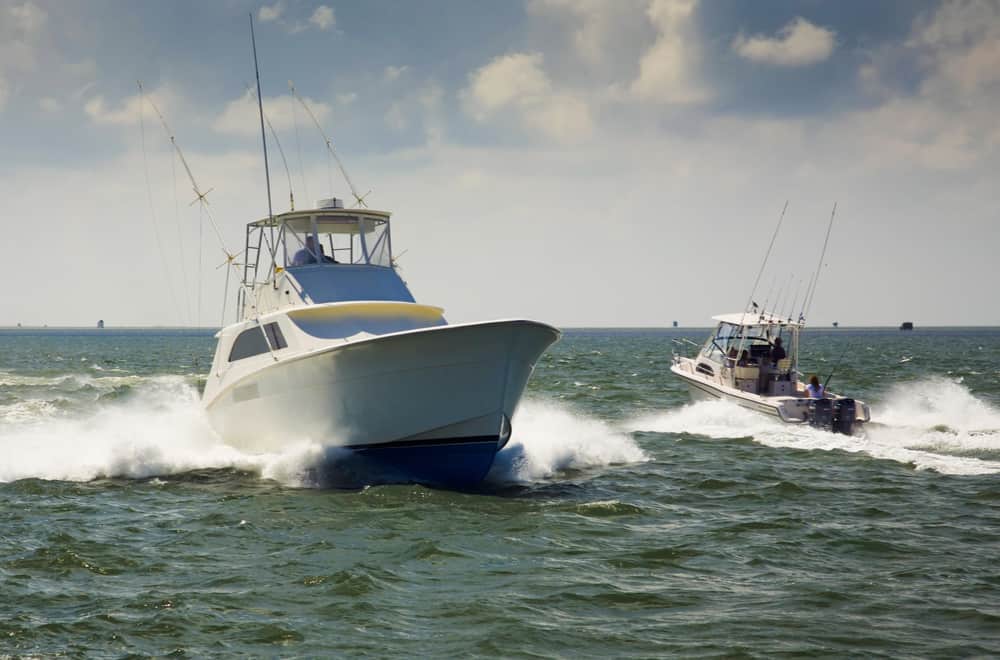
Waterways don’t have lanes like roads do. So when two boats meet , you have to use the right-of-way guidelines we mentioned earlier (aka Rules of the Road). The boat that has right of way is called the stand-on or stay-on boat, while the other boat is the stand-off or give-way.
15. Nautical Miles
No, they’re not the same as regular miles. One nautical mile is 1,852m or 6,076.12 feet. The speed of a boat is measured in nautical miles too. 1 knot is 1.15 mph, though this is often rounded off to 1.2mph. But don’t confuse speed knots with the rigging knots on the ropes.
16. Heeling and Gybing
When your boat is heeling, it means its leaning into the water and looks like it’s about to fall in. Meanwhile, to gybe (sometimes spelled as jibe) is to swing the boom. This changes how the sail cloths respond to each other and catch the wind, so it changes the boat’s direction.
17. Heading and Bearing
The heading is the direction your boat is sailing (e.g. due north, etc.) The bearing is a way of describing that heading, but you use angles and degrees. If you’re bearing off, you’re turning your boat away from the wind. But if you’re tacking, you’re turning the bow into the wind.
18. Bridge Clearance
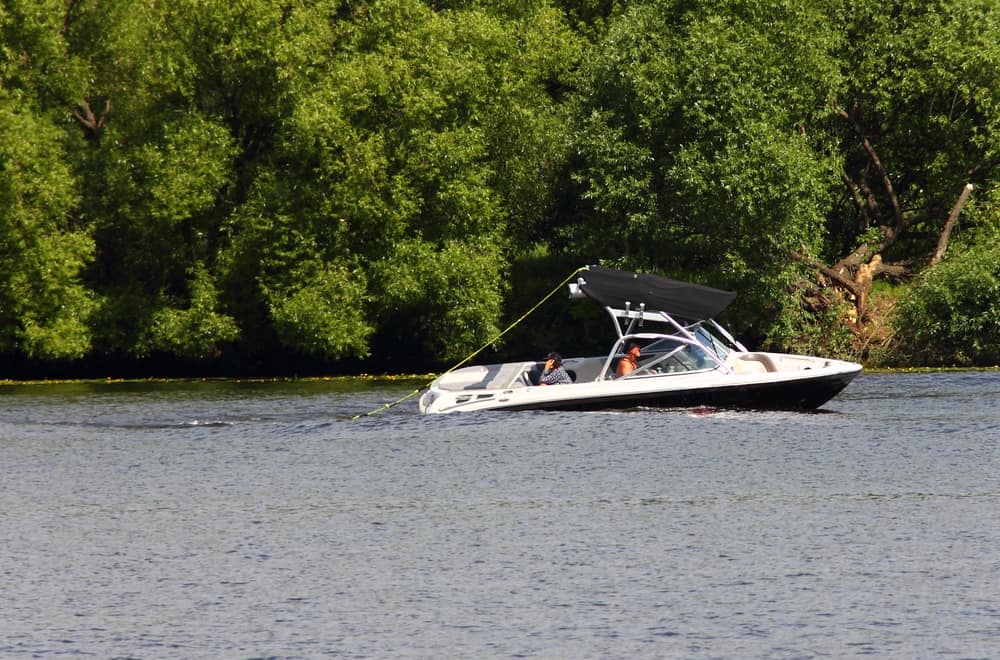
Some boats (like aluminum fishing boats or rowboats) have a flat top. Others have an open-top covered with optional canvas canopies called biminis or dodgers. But if the steering heel is enclosed in a console or bridge, the bridge clearance is the height of the tallest sub-section.
19. Roping Terms
When you’re referring to the rigging, you may hear terms like ‘make fast’ which means to secure the rope by knotting it carefully. Or ‘cast off’ which means to release the docking lines and set off. Also, the ropes on your sail cloths are sometimes described as sheets or lines.
20. Anchoring Terms
We’ve talked a bit about anchors already, but it helps to know a sea anchor is a boat brake that’s different from a regular anchor. It floats behind the boat to create drag and slow the boat. Pulling your anchor back into the boat is called retrieving or weighing your anchor.
21. Movement Terms
We’ve mentioned tacking (turning the bow), which is also called coming about. And we’ve talked about jibing (swinging the boom to turn the stern). When you tack in a zigzag to dodge wind, that’s called beating. When you drive directly into the wind, that’s called running. And when you drive your boat perpendicular to the wind (aka crosswind), that’s called reaching.
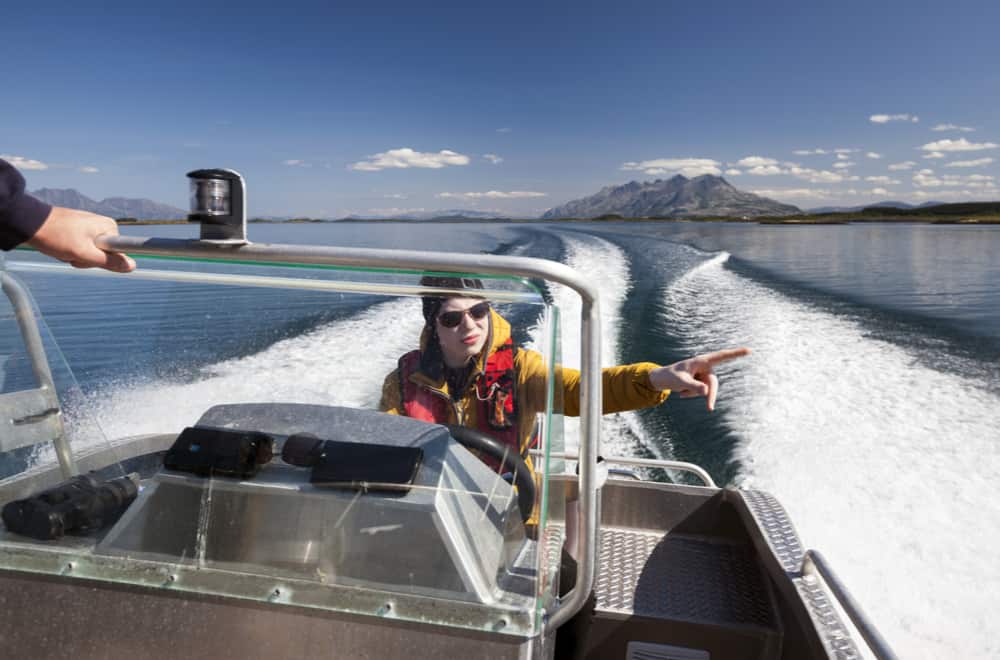
The route you’ve chosen to sail is called your course, so you can be on-course or off-course. If you’re smoothly moving forward then your boat is making headway. The waves that your propeller forms behind your boat are called the wake (hence wake surfing or wakeboarding).
23. Ballast
When a boat is sinking, you might throw cargo overboard to make the boat lighter. If you plan to retrieve these items, you can mark them with a buoy. This is called lagan. But if you add weight to the boat to make it more stable (e.g. water, stone, metal), this is called ballast.
24. Kill Switch
As a safety feature, a small lanyard ties the boat driver to the cockpit or steering wheel . If the driver leans too far back, gets distracted, or loses control, the lanyard will tighten and eventually pull away, automatically turning off the engine. Hence the name, Kill Switch.
25. Accidental / Flying Jibe
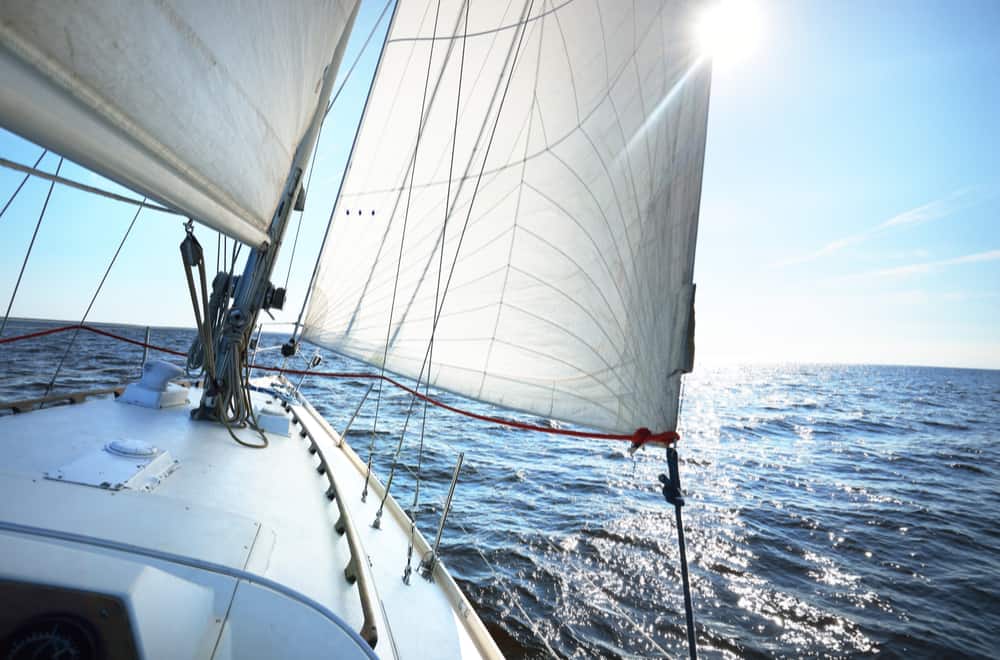
When you jibe the boat (which is the opposite of tacking), you use the boom to maneuver the stern of the boat out of the wind. But sometimes, this happens unintentionally and the boom swerves across the boat aka sailing by the lee. This mess is called accidental gybing.
Do you know any other boating parts or terminology we left out? Tell us in the comments!
Related posts:
- 6 Best Types of Boats for Gulf Coast Waters
- 21 Best Affordable Bay Boats for the Money
- Boat Club Membership Cost (Price Chart)
- 8 Tips to Choose the Best Dinghy for Your Boat
Similar Posts

5 Different Types of Center Console Boats
As a boating enthusiast, the center console design offers a great mix between practicality and versatility whether you choose to go fishing, snorkeling, skiing, entertaining, dockside restaurant hopping, or take advantage of a bit of it all. If you are ready, I aim to get you all up to speed on a center console boat…

What Is Draft On A Boat? Why Is It So Important?
Are you planning on buying a new boat? Have you heard the term ‘draft’ and wondered what it meant? Draft is one of the most important factors to consider if you want to buy a boat. The draft on a boat will determine how and where you can safely use your vessel. Buying a boat…

How to Mentally Prepare for Long-Term Offshore Sailing
Being out on the open water is a wonderful experience; many poets and sailors have left plenty of writings documenting that. However, that doesn’t lessen the toll of long-term sailing on a person’s psyche. As such, it is essential to mentally prepare for long-term offshore sailing. Table of ContentsHave a readily available hobbyTry to form…

33 Types of Boat Anchors: Which is Best?
Your car has a handbrake to hold it in place when needed. Similarly, boats have anchors. You slip them off the side of the boat and let them sink to the ocean floor, where they dig in stop your boat from drifting. You can use anchors in oceans and rivers too. But how do they…

6 Simple Steps to Paint A Boat Trailer
Painting your boat’s trailer is essential to keeping it rust and corrosion-free. While you can certainly pretty up your trailer and even color-coordinate it with your boat, maintaining a well-kept trailer is more about function than anything else. This article includes an easy-to-follow process for restoring boat trailers- not only to stay looking good but…

10 Best Bay Boats Under 30k
Bay boats will help you cruise the shores, but did you know that you can buy them even with your small budget? Yes, getting quality bay boats is costly. But which great ones will cost you less than 30k? You are about to find out. Here, we’ll talk of the best bay boats under 30k….
Leave a Reply Cancel reply
Your email address will not be published. Required fields are marked *
Save my name, email, and website in this browser for the next time I comment.
Parts of a Boat: Essential Components Explained
Boating is an exciting activity that provides a unique blend of adventure, relaxation, and connection with nature. Learning the basic parts of a boat and understanding the terminology is vital to mastering navigation and ensuring safety on the water. Boats come in diverse shapes and sizes, from modest rowboats to luxurious yachts, each serving specific purposes and requiring different levels of knowledge.
The anatomy of a boat consists of essential components such as the hull, bow, stern, port, and starboard sides. Knowledge of these parts allows for effective communication and improved maneuverability on the water. Whether you're a novice or an experienced skipper, it's important to understand parts and terminology related to movement, boat equipment, and open deck areas, as well as specific aspects of sailboats and fishing vessels.

Key Takeaways
- Familiarity with basic boat parts and terminology enhances navigation and safety on the water.
- Boats come in various forms and sizes, each with specific purposes and features.
- Understanding the unique aspects of sailboats, fishing boats, and other vessel types ensures an enjoyable and safe boating experience.
Basic Parts of A Boat
The bow refers to the front part of the boat. It is designed to cut through water with minimal resistance, allowing the boat to move smoothly and efficiently. The shape of the bow can vary depending on the boat's intended use, but it is generally narrow and pointed.
The stern is the rear part of the boat. It can have different shapes and features, such as a flat transom or a rounded shape. The stern is where the boat's propulsion system, like an outboard motor or inboard engine, is typically located.
The hull is the primary structure of the boat , providing both support and buoyancy. It is comprised of the boat's outer shell and is designed to withstand a variety of conditions, including waves and impact from abrasion or collisions. Hulls are generally made from materials like fiberglass, aluminum, steel, or wood.
The deck is the flat surface on the boat's top, providing open spaces for passengers and crew. It is often used for recreational activities, such as sunbathing, fishing, or socializing. Decks can be made of various materials, including wood, fiberglass, or metal.
The cabin is the enclosed space within the boat that provides shelter and living accommodations for the passengers and crew. Cabins are usually found on larger boats and can include sleeping quarters, a galley (kitchen), and bathroom facilities.
The keel is the boat's backbone, running longitudinally along the bottom of the hull. It provides structural support and stability. In sailing boats, the keel also serves as a counterweight and assists with lateral resistance when sailing upwind.
The bridge is the command center of larger boats or ships, housing the navigation and control systems. It is typically located near the top of the vessel, providing a clear and unobstructed view for the captain and crew. The bridge contains essential equipment such as radar, GPS, communication devices, and steering controls.
In summary, the basic parts of a boat include the bow, stern, hull, deck, cabin, keel, and bridge. These components work together to ensure a smooth and safe experience for passengers and crew alike.


Position Indicators
The port side of a boat refers to the left side when facing the front or forward part of the boat. This is an important position indicator as it helps sailors and passengers ensure they are navigating the waters correctly. The port side is usually marked with red navigation lights to indicate its position in low visibility conditions. The term aft refers to the rear part of the boat, which is closest to the port side.
Starboard Side
On the other hand, the starboard side is the right side of the boat when facing forward. It is a crucial position indicator that allows sailors to distinguish their right side from the left side. Starboard side is typically marked with green navigation lights to differentiate it from the port side in low light or foggy situations. During navigation, a boat should ideally pass other boats on its starboard side, which means the other boat should be on its ahead and port side. The term astern refers to the rear part of the boat, which is closest to the starboard side.
Both port and starboard sides are essential for properly navigating and maneuvering the boat while sailing. Understanding the differences between these position indicators ensures safe and efficient movement at sea. Knowing the forward, aft, astern, and ahead concepts in relation to the port and starboard sides further establishes a solid foundation for any boating enthusiast.

Terms Related to Movement
The right side of a boat is referred to as the starboard side. When a boat is moving forward, this is the side on the right. The term starboard originates from the old nautical term "steorbord" which refers to the side where the steering oar was placed. Most boats today have a green navigational light on the starboard side.
The left side of a boat is called the port side. Just as with the starboard side, the port side's name has its origins in nautical terminology. The port side was originally called "larboard," but due to its similarity in pronunciation with starboard, "port" was adopted as the term. Today, boats have a red navigational light on the port side.
Back of a Boat
The back of a boat is known as the stern . This is the area where the boat's propulsion system, such as the motor or propeller, is usually located. When a boat is adrift , the stern can be a critical spot for maintaining control and making necessary adjustments to the vessel's movement.
Front of a Boat
The front part of a boat is called the bow . This is the area that cuts through the water as the boat moves forward. The waterline of a boat refers to the point where the hull meets the water's surface; this varies depending on the vessel's load and can impact its movement.
When discussing movement in nautical terms, speed is often measured in knots , which is equivalent to one nautical mile per hour. Knowing the speed of a boat is important for navigation , fuel consumption, and safety. Sailors must also be aware of the possibility of a boat running aground , which means the vessel's hull is in contact with the sea floor, often resulting in damage or being stuck in place. A grounded boat can impact vessel trajectory and movement.

Boat Equipment
A cleat is an essential piece of boat equipment used for securing lines. It is a T-shaped or Y-shaped hardware component, commonly made of metal or plastic, that allows for easy tying and untying of ropes or lines. Cleats are crucial for docking, anchoring, and tying boats to other floating devices. They can be attached to the deck, side railings, or the mast base to provide a secure point for lines.
Lines are important for various tasks on a boat, such as mooring, anchoring, or towing. They are typically made of synthetic materials like nylon or polyester, which are durable and resistant to UV radiation, saltwater, and chemicals. When selecting a line for specific tasks, it's essential to consider factors such as strength, stretch, and resistance to abrasion. Among other parts of a boat, lines are often used in conjunction with cleats and fenders to ensure secure docking.
Fenders are cushioning devices used to protect a boat's hull from damage caused by contact with docks, piers, or other boats. They are typically made of soft, flexible materials like foam or inflatable plastic and are designed to absorb impact and distribute pressure. Placed between the boat and the docking area, fenders can prevent potential damage such as scratches, dents, or chipping paint.
A gate on a boat refers to an opening in the railings or lifelines, allowing the crew and passengers more accessible entry or exit. Gates are often found on sailboats and yachts. To ensure safety, they are usually equipped with a latching mechanism or locking device, preventing accidental opening while the boat is underway.
In addition to the above-listed components, some other crucial boat parts include:
- Outboard Motor : A detachable engine unit mounted on the stern (rear) of the boat, providing propulsion. Outboard motors are typically self-contained, housing the engine, gearbox, and propeller in one unit.
- Anchor : A weighted, hook-like device that secures boats to the seabed or riverbed, preventing them from drifting due to wind or currents. It is connected to the boat by an anchor line or chain.
- Helm : The steering control area, typically consisting of a wheel or tiller, which allows the operator to maneuver the boat.
- Propeller : A rotating fan-like device connected to the boat's engine, responsible for generating thrust and propelling the boat forward or backward.
- Mast : A tall, vertical pole on a sailboat that supports the sails and rigging.
- Rudder : A flat, vertical panel, usually mounted beneath the boat's stern, which helps steer the boat when turned by the helm.
Boat equipment plays a crucial role in operating and maintaining a vessel safely and efficiently. Ensuring that these components are in good condition and used properly is essential for a successful boating experience.

Open Deck Areas
Open deck areas on a boat serve various purposes and often host different types of equipment, providing both functionality and comfort to the passengers. This section will discuss three subsections, focusing on the galley, rod holder, and throttle.
The galley is an essential part of any boat with an open deck area, similar to a kitchen found on land. It often includes facilities for cooking, refrigeration, storage, and meal preparation. A well-designed galley allows passengers to prepare meals while enjoying the outdoor surroundings. Located near the bulkhead , it provides easy access to other deck areas like the bridge and cockpit .
A rod holder is a crucial piece of equipment for recreational boating, especially for those who enjoy fishing. It securely holds fishing rods in place and allows anglers to fish hands-free, increasing safety and convenience. Rod holders are typically located near the boat's casting deck and pulpit , offering easy access while fishing. It is essential to ensure that rod holders stay clear of the boat's swim platform to minimize accidents or obstructions.
The throttle controls the boat's speed and is a vital component that falls under open deck areas. Located in the cockpit or near the boat's bridge , the throttle allows the operator to control the boat's engine power and steer it safely. A smooth and responsive throttle is essential for safe and enjoyable boating experiences.
In conclusion, open deck areas of a boat include essential facilities and equipment that provide comfort, functionality, and entertainment for passengers. Understanding the role and location of the galley, rod holder, and throttle can significantly enhance the overall boating experience.
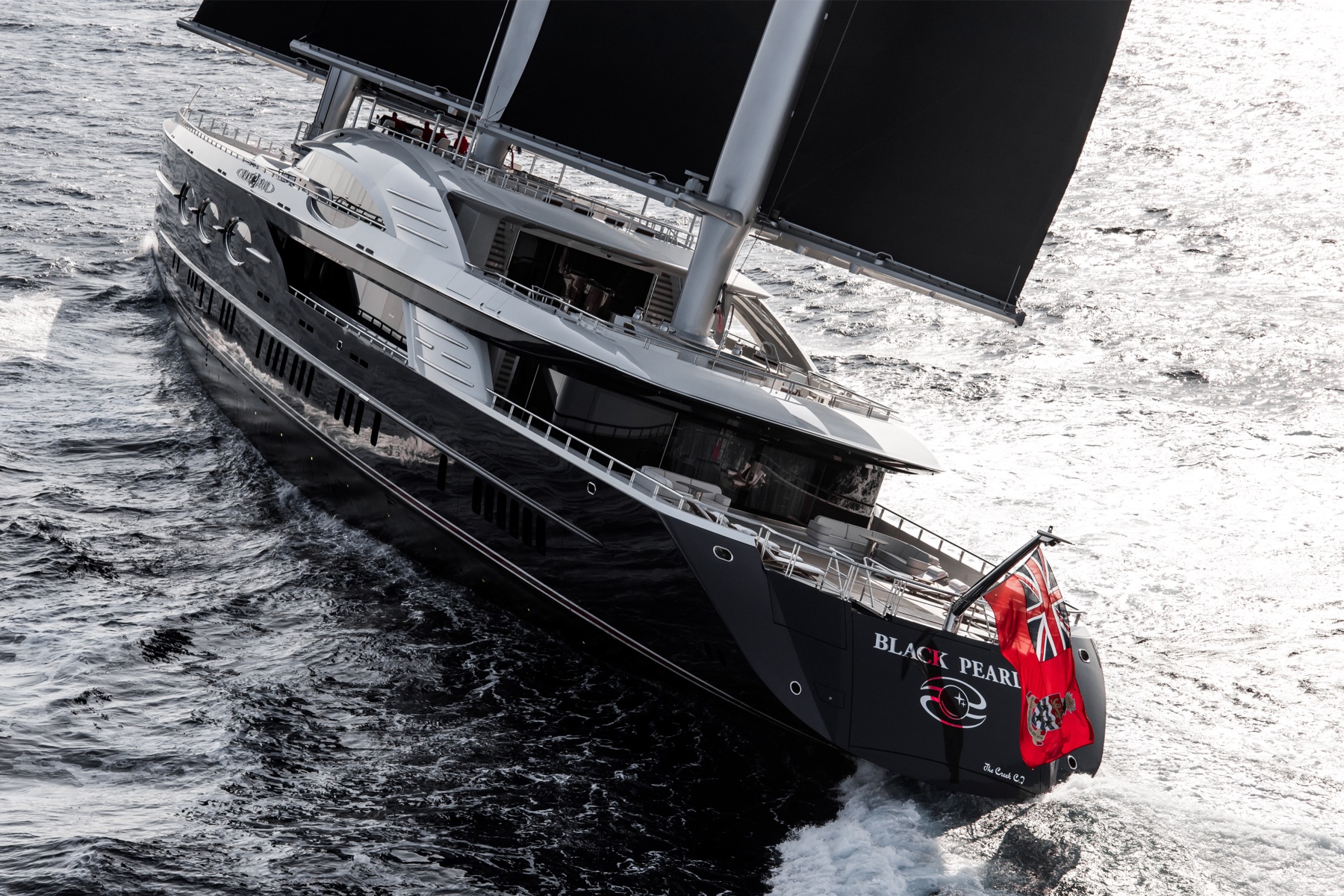
Sailboat Specifics
Sailboats are designed with various distinctive parts that contribute to their unique sailing capabilities. This section will discuss three specific components of a sailboat: the Ballast, Forestay, and Centerboard.
The ballast is an essential element in a sailboat's stability. It is typically found at the bottom of the boat and is responsible for providing a low center of gravity, counteracting the heeling force induced by the sails' wind pressure. The ballast is often made of dense materials like lead or iron and accounts for a significant portion of the boat's overall weight. A well-designed ballast ensures that the sailboat maintains its balance and returns to an upright position after being heeled by the wind.
The forestay is a vital part of the sailboat's rigging, as it secures the mast's forward end. This cable or rod connects the bow (front) of the boat to the top of the mast, providing support and tension to the mast and helping maintain its shape. The forestay is also crucial for attaching the jib, a smaller triangular sail set forward of the mainsail. The jib can improve the boat's overall performance , allowing it to point more effectively into the wind and increasing maneuverability.
Centerboard
A centerboard is a movable fin located at the sailboat's bottom middle portion, allowing the boat to change its draft (submerged depth) and optimize its performance. The primary functions of a centerboard are to combat leeway, generating lift under the boat and preventing it from being pushed sideways by the wind, and to help control the sailboat's balance.
The centerboard can be raised or lowered as needed, providing the desired level of stability and maneuverability. It can be retracted entirely to allow the sailboat to move through shallow waters or for transportation purposes. Thus, the centerboard is an essential factor in a sailboat's flexibility and adaptability.
In summary, the ballast, forestay, and centerboard are crucial components of a sailboat that contribute to its stability, rigging, and overall sailing performance. These parts work together, enabling sailboats to harness wind power effectively and provide an enjoyable sailing experience.

Boating Terminology
When it comes to boating, understanding the terminology can be crucial for a safe and enjoyable experience. This section aims to provide you with a clear and concise explanation of some essential boating terms.
The rail is an essential part of a boat, serving as a safety barrier and also adding stability. It is located along the outer edge of a boat's deck, ensuring that passengers do not accidentally fall overboard. Typically, the rail is made of durable materials such as stainless steel or aluminum, to withstand harsh marine conditions.
A hatch refers to a door or opening that provides access to different sections of a vessel. It can be found on both the exterior and interior of a boat. Hatches serve various purposes, such as ventilation, emergency escape routes, and access to storage compartments. They are typically designed with watertight seals to prevent water from seeping in and damaging the vessel's interiors or essential equipment.
In boating terminology, a bulkhead refers to a structural partition that separates different compartments within a ship. Bulkheads are vital for the vessel's stability and play a crucial role in maintaining its integrity and balance while at sea. Additionally, they also provide a degree of fire protection, as they can act as a barrier between sections of the boat in case of a fire breakout.
A livewell is a specialized compartment on a fishing boat that serves to keep bait and caught fish alive while onboard. This container is filled with water, and usually has an aeration system to maintain oxygen levels and ensure the wellbeing of the fish. Livewells are essential for anglers who participate in catch-and-release fishing or need to keep their catches fresh until they return to shore.
By understanding these essential boating terms, one can navigate vessels more effectively and safely, and fully appreciate the complexities of ships and boats.

Other Key Aspects
The bilge is a crucial part of a boat located at the lowest point of the hull, responsible for collecting any water or oil that may accumulate inside the vessel. It is important to have a functional bilge pump in place to ensure the boat remains safe and seaworthy. The beam of the boat plays a role in determining how much water the bilge can handle. A wider beam allows for more water storage capacity and makes it more stable.
The draft of a boat refers to the depth of water needed for it to float freely without touching the bottom. This measurement plays a significant role in deciding where a boat can travel, as some areas may not be navigable due to shallow waters. The draft directly relates to the boat's design, including the freeboard and hull shape. A larger draft may lead to a more stable vessel in rough waters, while a smaller draft benefits boats navigating shallow areas.
The head is the maritime term for the boat's toilet. It is an essential component on any vessel equipped for overnight trips or extended cruises. Proper maintenance of the head and its plumbing system is crucial for sanitation and ensuring a pleasant experience for passengers onboard. Some larger boats may feature more sophisticated systems, including separate shower areas or pump-out systems.
The doors on a boat differ from those found on land; they need to be watertight, designed to withstand harsh marine conditions, and must not compromise the overall integrity of the vessel. The material used for the door construction varies, often including high-quality stainless steel or aluminum. In some cases, doors may be equipped with air-tight seals and locking mechanisms to prevent water ingress during rough seas.
In conclusion, understanding key aspects such as the bilge, draft, head, and doors is essential for boat owners and enthusiasts. Considering other elements like beam, freeboard, transom, and gunwale will provide further insight into the boat's stability, navigation capabilities, and overall design.

Fishing Boat Essentials
When it comes to enjoying a day on the water, having the right essentials on your fishing boat can make all the difference. This section covers some of the must-have components for a successful fishing trip: the Tiller, Bimini, and Console.
The tiller is an essential part of any fishing boat, as it is used to steer the vessel. It is typically attached to the boat's outboard motor or rudder and allows the operator to control the direction of the boat. A tiller provides excellent maneuverability and is ideal for navigating tight spaces and shallow waters, which are often found in prime fishing spots. In addition, many fishing boats come equipped with rod holders , just behind the tiller, making it easy for anglers to keep their fishing gear within reach.
A bimini is a type of canopy that provides shade and protection from the elements while on the water. It is especially useful for anglers who spend long hours exposed to the sun and elements. A bimini can be easily installed on most fishing boats and can usually be folded down when not in use. It also adds an extra layer of comfort and protection for those on board.
For added convenience, some biminis have built-in rod holders, allowing anglers to secure their fishing rods while taking a break from casting. A good bimini can make the difference between an enjoyable day on the water and an endurance test against the elements.
The console is the control center of the fishing boat, housing essential instruments and controls needed for navigation, communication, and boat operation. Located near the steering wheel, the console should contain the necessary equipment such as a GPS system, VHF radio, and depth finder to aid anglers in their fishing expeditions.
A well-designed console also provides space for mounting additional tools and storage, such as a livewell . Livewells are valuable components for keeping bait and caught fish alive and in optimal condition until the angler is ready to return to the shore. There should also be dedicated spots for storing extra fishing equipment, such as tackle boxes and spare rods.
In summary, having a well-equipped fishing boat with essential components like the tiller, bimini, and console will make for a more enjoyable and efficient angling experience. These crucial parts ensure that the angler is ready for whatever challenges the water may bring, allowing them to focus on the main task at hand: catching fish.
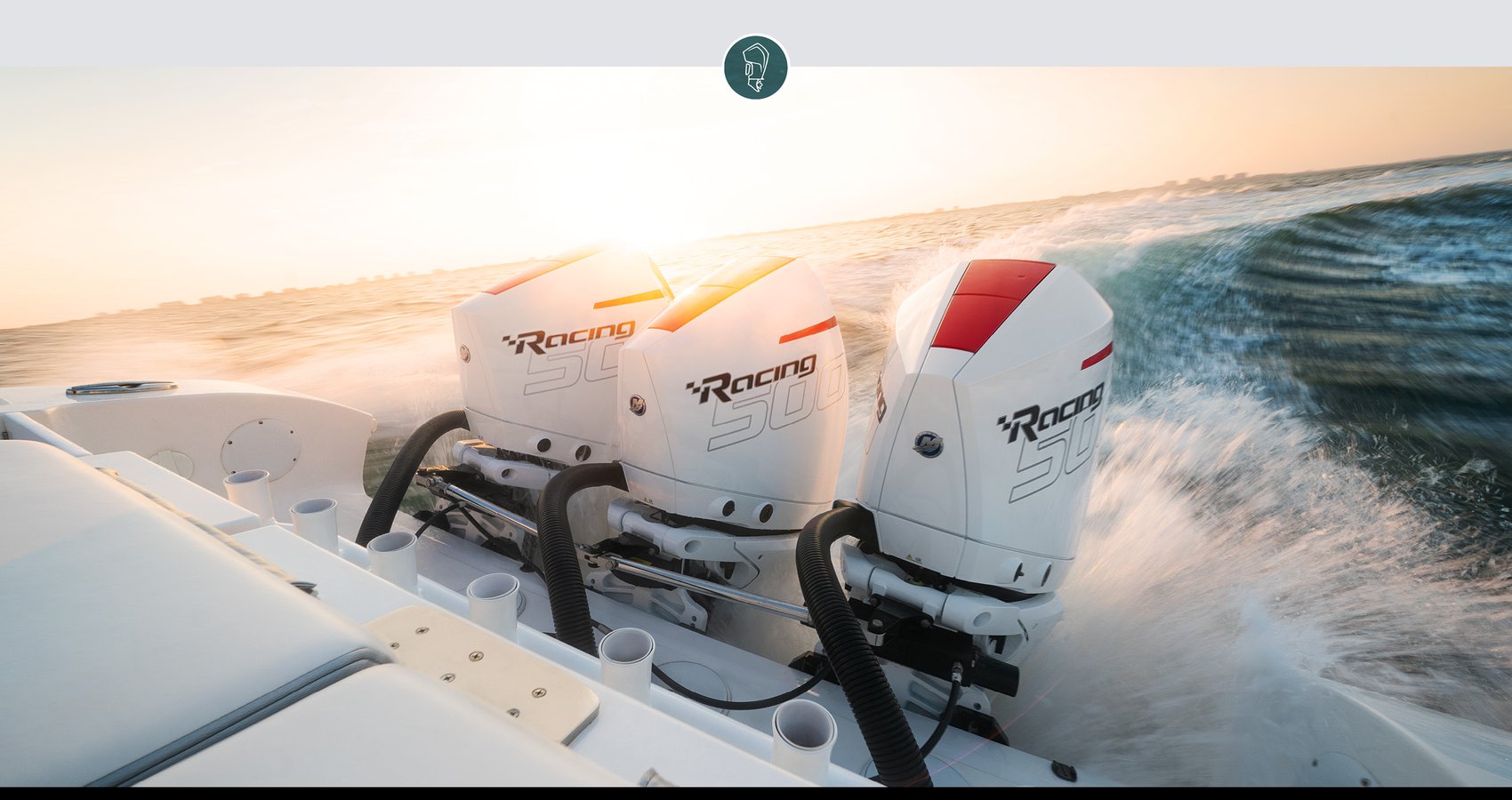
Frequently Asked Questions
What is the right side of a boat called.
The right side of a boat is called the starboard side. This term is used to refer to the right side when facing forward on a boat.
What is the back of the boat called?
The back of a boat is known as the stern . The stern is the rear section of a vessel that helps provide stability and aid in the steering process.
What are the 4 basic parts of a boat?
The four basic parts of a boat are the hull , deck , engine , and sails (in sailboats). The hull is the main body of the boat, providing buoyancy and protection from water. The deck is the flat surface that covers the hull and supports the occupants and any equipment. The engine propels the boat, and the sails are used for harnessing wind energy in sailboats.
What is the cockpit of a boat called?
The cockpit of a boat is called the helm . The helm is the part of the boat where the captain or helmsman steers and controls the vessel. This area typically includes a steering wheel, throttle, and navigation equipment.
What is the outer part of the boat?
The outer part of the boat refers to the hull and deck . The hull is the structural component that keeps the boat afloat, while the deck is the part that occupants walk on. The hull and deck together form the external shell of the boat, protecting it from water and providing stability.
What are boat parts called?
Boat parts are usually referred to by specific names such as hull, deck, mast, rudder, and keel, among others. Each part serves a unique function in the overall operation and stability of the boat, making it essential for boat owners to be familiar with these terms.
Related Articles
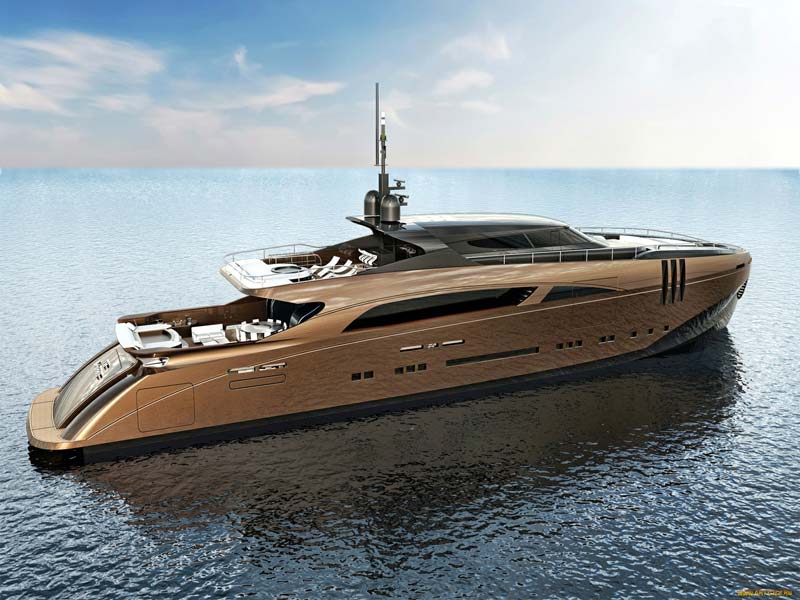
History Supreme Yacht Most Expensive: Exploring the Ultimate Luxury Vessel
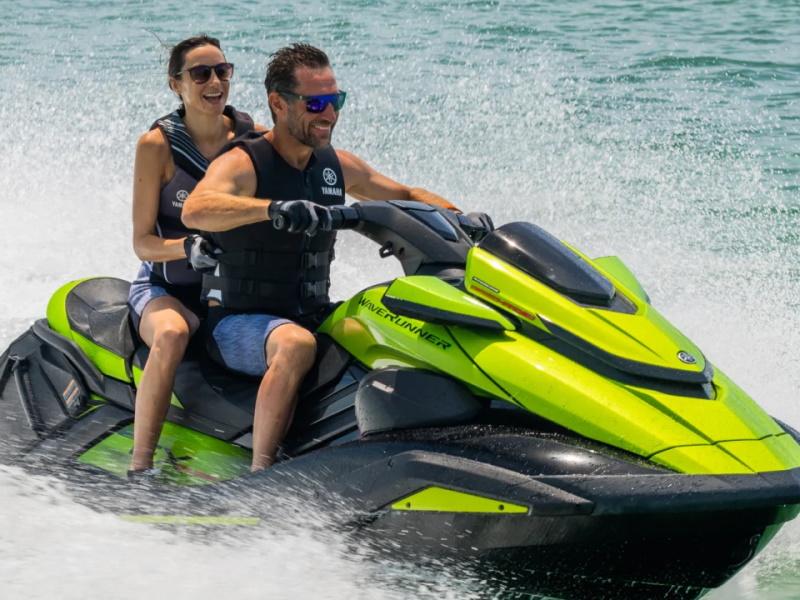
Which Action May Cause Loss of Steering Ability in a PWC? Essential Safety Tips

50 Best Boat Names of 2023: A Wave of Creativity and Wit
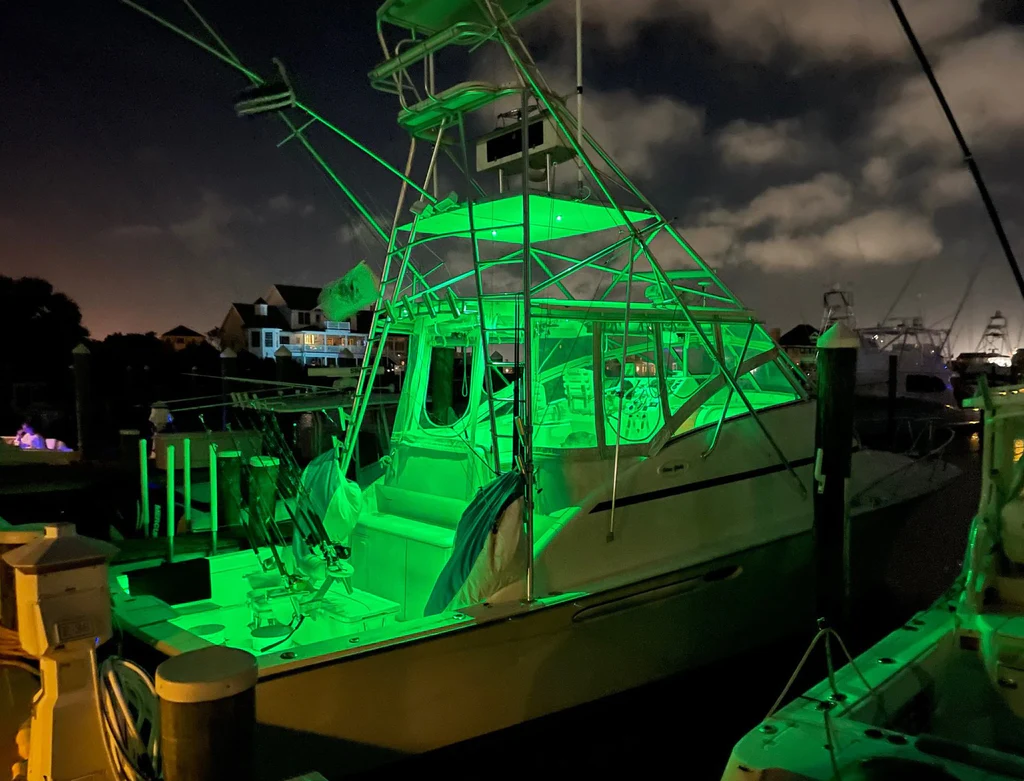
Black Oak LED: Unleashing Illumination Excellence

Top 10 Jet Skis for Sale in New York: Best Deals and Models Available
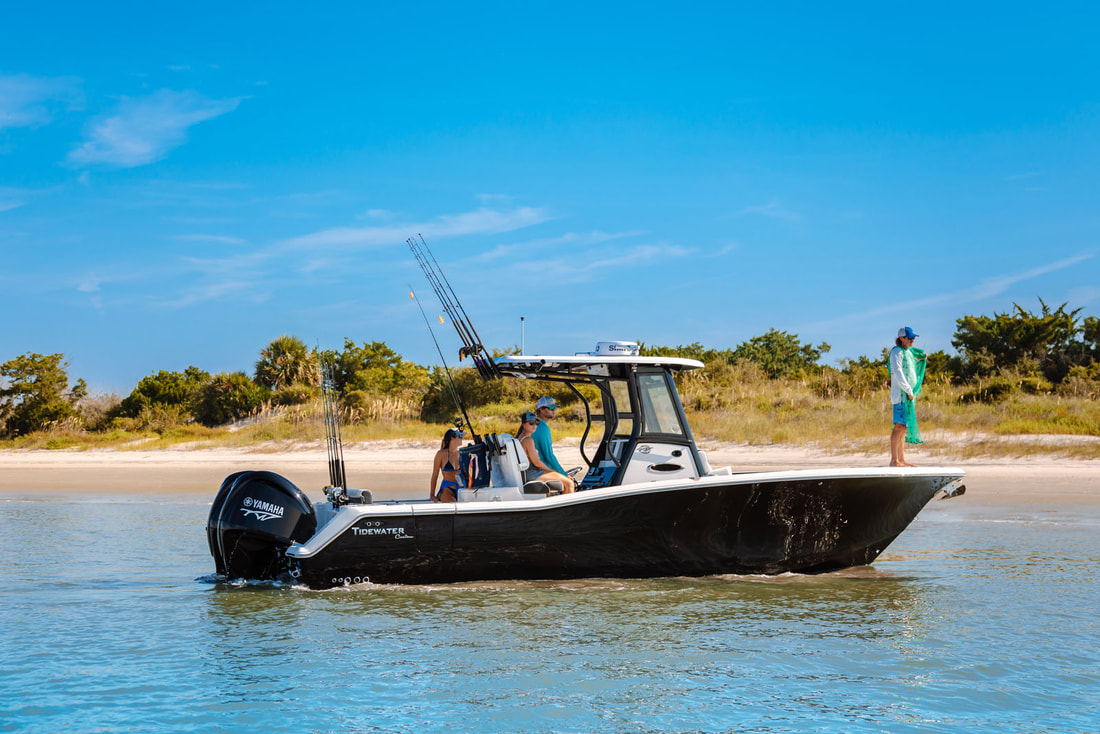
Tidewater Boats 2024: Unveiling the Latest Models and Features

Gunwale Reinforcement: A Critical Step in Boat Maintenance
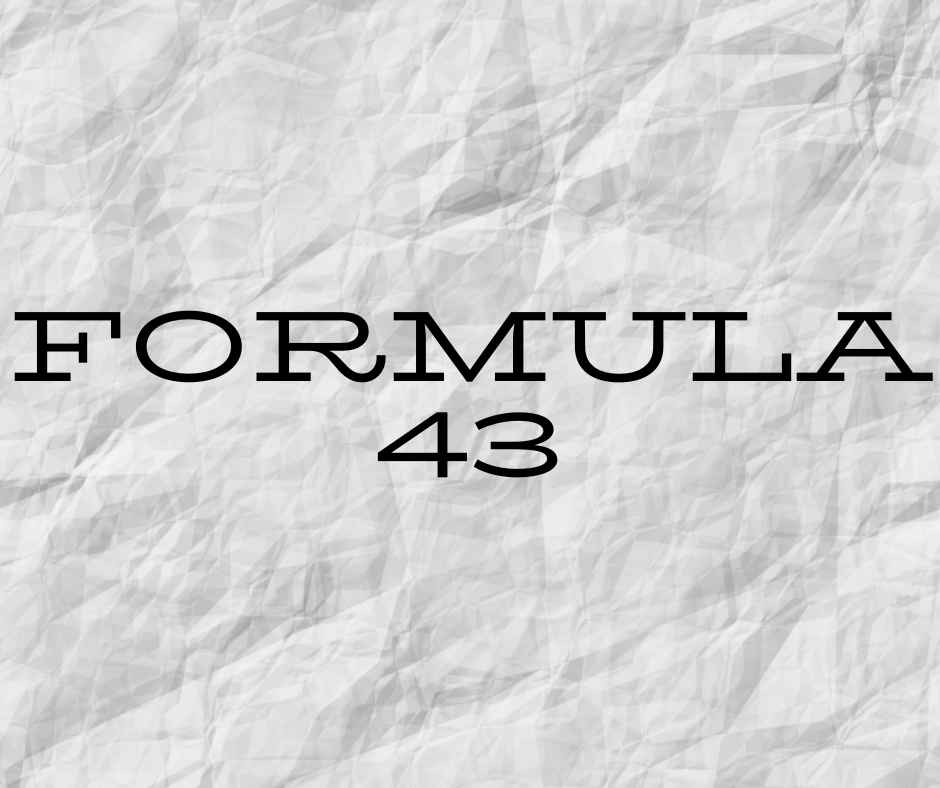
Formula 43 Sport
Parts of the Boat: A Comprehensive Guide to Understanding Every Component
by Emma Sullivan | Jul 14, 2023 | Sailboat Gear and Equipment

Short answer parts of the boat:
The main parts of a boat include the hull (the bottom part that touches water), deck (top surface), bow (front end), stern (back end), and keel (the centerline running beneath). Other essential components are the rudder, propellers, mast or sail, and various navigation equipment.
Understanding the Different Parts of a Boat: A Comprehensive Guide
Whether you’re a seasoned sailor or an aspiring boat enthusiast, having a thorough understanding of the various parts that make up a boat is essential. From the bow to the stern, every component plays a crucial role in ensuring smooth navigation and safety on the water. So, let’s embark on this comprehensive guide as we explore each part with professional finesse, witty flair, and clever explanations.
1. Bow: Ahoy! We begin our journey at the front of the ship – the bow. It’s not just a fancy term for “front” but rather an integral part designed to cut through waves effortlessly. Don’t mistake it for being all aesthetics; this sleek pointy section helps maximize speed and minimize resistance like Batman’s aerodynamic cape.
2. Hull: Ah, the hull! Think of it as the skin of your boat – protecting everything inside from those sneaky underwater critters and harsh elements. The hull also provides buoyancy and stability because nobody wants their vessel acting like a drunken sailor during rough weather conditions.
3. Deck: Picture yourself on deck, wind weaving through your hair, soaking in picturesque views – ah, pure bliss! That magical space where you chillax while catching some sun rays or shout with glee when spotting dolphins is none other than…the deck! This horizontal platform provides extra structural integrity (bonus points for double-decker boats) and more room to party like Jack Sparrow.
4. Cabin: Time to take shelter belowdeck in what sailors refer to as “the cabin.” Forget cramped quarters; this snug living space is perfect for overnight stays or hiding from blistering heatwaves (cue dramatic pirate narration). If you think boat cabins are cramped dark spaces, think again – welcome to luxurious floating hotel rooms!
5. Cockpit: No need for pilot licenses here; entering the cockpit unleashes your inner sea captain skills without a hitch. Contrary to what it sounds like, it’s not where chickens hang out but the control center of your vessel. Packed with nifty gadgets like steering wheel, throttles, and instruments that rival NASA’s spacecraft, this is where you’ll navigate your boat – without any chicken-related distractions.
6. Mast: Ahoy again! As we lift our gaze skyward, we encounter a captivating structure known as the mast. Rising majestically above the deck (and usually adorned with sails), the mast helps bring your boat to life on wind-powered adventures. It’s analogous to a wizard’s wand, channeling magical gusts to propel you on fantastical voyages across the water.
7. Keel: Wait! Before you dive into maritime jargon-induced confusion, let us explain what keels are all about. Think of them as underwater stabilizers; they prevent tipping over or sailing sideways during choppy conditions – basically acting like the rock-solid friend who keeps you grounded at parties.
8. Rudder: Steering a boat without a rudder is like trying to cross the ocean with an invisible paddle – not very effective! The rudder may seem unassuming but is vital for changing course with precision and grace. Also known as the “steering oar,” it allows you to navigate through even stormy seas with ease.
9. Buoyancy Tanks: Oh buoy! (Pun intended) These cleverly placed compartments keep your boat from taking an unintended nosedive after hitting a rogue wave or cramming too many friends aboard for that epic party weekend. They trap air inside, helping maintain optimal buoyancy lest your vessel becomes more submarine than pleasure craft!
Now that we’ve unveiled this comprehensive guide exploring various parts of a boat in professional detail – complete with wit and cleverness – you can confidently set sail on your next maritime adventure armed with knowledge befitting Captain Jack Sparrow himself. Bon voyage!
How Do the Various Parts of a Boat Work Together?
Boats have long fascinated people with their ability to traverse water, allowing us to explore new horizons and enjoy recreational activities. But have you ever wondered how all the different parts of a boat work together seamlessly? From the hull to the propeller, each component plays a vital role in ensuring smooth sailing. So let’s dive into the nautical world and unravel the intricate web of boat anatomy.
First and foremost, we have to give credit where it’s due – to the unsung hero of any vessel – the hull. Acting as both an outer shell and a structural foundation, it not only keeps us afloat but also provides stability and buoyancy. Crafted from various materials like fiberglass or aluminum, this sturdy frame resists water pressure while gliding smoothly through waves, making sure our on-board experience remains stable and enjoyable.
Now that we’re comfortably positioned within this floating fortress, let’s take a closer look at how propulsion is achieved – enter stage right: The engine room! It houses those mighty mechanical beings known as marine engines. These powerhouses are responsible for transforming stored energy into motion by burning fuel (usually gasoline or diesel) in cylinders that move pistons up and down.
As these pistons swivel away with coordinated precision inside their chambers, they generate linear energy that ultimately drives the crankshaft – all thanks to combustion wizardry! This rotational force is then transmitted through various gears within the transmission system, which transfers it to our beloved propeller. And just like that, we’ve unlocked Mother Nature’s pragmatic lottery ticket for movement in water!
Ah yes, our shining star: The Propeller! This wonderous contraption features rotating blades specifically designed to push or pull water backward with exceptional force known as thrust. Channeling Newton’s third law (every action has an equal and opposite reaction), this generated thrust propels our vessel forward against resistance provided by the surrounding liquid. It’s like nature’s very own revving racecar, but on water!
But how do we steer this magnificent machine? The humble tiller or steering wheel is our trusty companion in navigating the seas. Connected to the rudder – located beneath the transom at the stern of the boat – it allows us to control the direction of travel. By turning left or right using either a mechanical linkage or hydraulic mechanism, we can gracefully maneuver through even the choppiest waters.
Safety should always anchor our adventures on water, which is why every vessel boasts an array of auxiliary systems aimed at keeping us secure and comfortable onboard. From bilge pumps that expel unwanted water from the hull, preventing flooding, to electrical circuits for lighting and navigation instruments, these critical components ensure a smooth sailing experience while adapting to various environmental conditions.
Now that we’ve explored some key elements intertwining perfectly in harmony aboard a boat let’s not forget about teamwork – that invisible sailor who orchestrates all these intricate operations: The skipper! With their knowledge and expertise handling both navigation and emergency situations, they’re like conductors overseeing this symphony of interconnected components ensuring our safety and enjoyment on water.
So next time you board a boat, take a moment to appreciate how each part seamlessly collaborates with its neighbors. From hull to engine room, propeller to steering system, they work together like talented dancers performing an artful piece – expressing not just function and utility but also undeniable elegance. May your nautical journey be one filled with wonder and admiration for these remarkable achievements of human ingenuity!
Step-by-Step: Exploring the Essential Parts of a Boat
Title: Step-by-Step: Delving into the Essential Parts of a Boat
Introduction: Smoothly gliding across the water, a boat exemplifies both adventure and relaxation. However, have you ever wondered about the intricate machinery that propels these floating marvels? In this article, we will embark on an exploration of the essential parts that make up a boat’s anatomy, unraveling the magic behind their functionality and unveiling how they come together to create a seamless boating experience.
1. Hull – The Backbone of Stability: Let us begin with the hull, which serves as the foundation for any boat. This vital component provides buoyancy and structural integrity to ensure stability on water. Crafted from various materials such as fiberglass or aluminum, each hull design caters to specific needs – whether it be speed or leisurely cruising.
2. Propulsion Systems – Powering Your Journey: Next, let’s delve into the propulsion systems responsible for thrusting boats forward. Depending on your vessel type and preference, power can come from either outboard motors or inboard engines neatly tucked within the stern. Each system has its advantages; outboards are versatile with easy maintenance access while inboards offer better weight distribution for stability.
3. Steering Mechanisms – Navigating Your Course: While a boat may possess incredible power, it means little without proper steering mechanisms guiding its path through waterways. Traditional vessels often employ mechanical or hydraulic systems connected to a rudder at the stern to control direction effectively. However, modern boats utilize electric steering technologies for easy maneuverability and enhanced precision.
4. Electrical Systems – Illuminating Possibilities: Boats are not just meant for daytime adventures; preparing for nighttime escapades is equally crucial! This brings us to electrical systems installed onboard. Lighting fixtures keep paths illuminated after dark while allowing visibility within cabins and workspaces. Furthermore, electrical systems power navigation equipment such as GPS units and communication devices that always keep you connected.
5. Navigation Equipment – Finding Your Way: For any aspiring mariner, the ability to navigate with precision is paramount. Advanced navigation equipment such as chartplotters and radar systems are essential tools in redefining your seafaring experience. These marvels of technology provide accurate positioning, illustrating charts and helping avoid hazards for a safe voyage.
6. Safety Equipment – Preparing for the Unexpected: While a boat offers pure enjoyment, it is crucial to prioritize safety above all else. Equip your vessel with various safety features like life jackets, fire extinguishers, distress signals, and first aid kits – these essentials ensure peace of mind during any excursion.
Conclusion: Exploring the intricate parts of a boat serves as an ode to its engineering genius. From the steadfast hull to powerful propulsion systems, precise steering mechanisms, electrical components, essential navigation equipment, and invaluable safety gear – every bit contributes to shaping your boating experience. So next time you set sail on shimmering waters or admire boats from afar, take a moment to appreciate their underlying craftsmanship that makes aquatic adventures so memorable!
Frequently Asked Questions about the Different Parts of a Boat
Title: Navigating the Seas of Boating: A Comprehensive Guide to Frequently Asked Questions about Different Parts of a Boat
Introduction: Ahoy there, fellow boating enthusiasts! As you embark on your journey through the vast sea of knowledge about boats, it’s essential to acquaint yourself with the different parts that make up these magnificent vessels. This guide aims to steer you in the right direction by answering some frequently asked questions regarding boat components. From stern to bow and everything in between, we’ll explore the intricacies of various boat parts with a touch of professionalism and sprinkle of wit.
1. What is a Hull, and why is it important? At the heart and core of every boat lies its hull. Comparable to a sturdy exoskeleton, the hull provides buoyancy while protecting against water intrusion. Designed meticulously to glide smoothly through waves, this critical part enhances stability and ensures your vessel remains seaworthy. Picture it as an armor that allows your boat to navigate even the roughest waters—truly a force to be reckoned with!
2. How do Outboard Motors work? Think of outboard motors as adrenaline-inducing rockets strapped onto your boat’s transom – they provide power and propel you forward! Combining an engine, gearbox, propeller driveshaft, and steering system into one compact package, outboard motors offer tremendous versatility while being easily removable for maintenance or transport purposes. These mechanical marvels allow us to conquer both calm rivers and wild horizons!
3. Understanding Propellers: Power Behind Every Turn If boats were magical creatures like unicorns (bear with us), their propellers would be their horns – graceful yet instrumental in maneuvering through water currents! Shaped like twisted wings or corkscrews attached at the rear end (stern) underwater, propellers generate thrust by spinning rapidly inside submerged driveshafts connected to engines or electric motors. They are true superheroes responsible for turning every boat trip into an adventure!
4. The Deck: Where the Action Unfolds Imagine a boat as a magnificent stage, with the deck being its grand performance area. This expansive platform offers space to walk, sit, socialize, or dance while serving important functions like distributing weight evenly and providing stability. It is here where you’ll find cabins, seating areas, control consoles, hatches leading to storage areas below deck – essentially everything needed to keep your nautical experience elegant and enjoyable.
5. Let’s Talk Rigging: Sailing Simplicity Explained Rigging is the intricate system of ropes (or lines) and fittings used to control sails on sailboats. These ropes connect masts, booms (horizontal poles), and other related parts to harness the wind’s power effectively. Each line has a specific name and purpose – halyards hoist up sails; sheets adjust their angle; and downhauls control tension – all working together in harmony like an invisible crew choreographing synchronized sailing symphonies.
6. Anchors Away! Understanding Anchor Systems: Anchors are more than just heavy metal objects dropped into the water; they symbolize security amidst adventurous sailing escapades. Equipped with sharp flukes that latch onto seabeds for grip, these metallic guardians prevent boats from drifting away freely when it’s time for a temporary stop or overnight sleepovers at sea. Different anchor types serve diverse purposes ranging from sandy bottoms to rocky terrains—always ensuring safe moorings wherever you choose to drop your musical anchor!
Now that we’ve sailed through these frequently asked questions about various boat parts, breeze through your boating conversations with confidence! From understanding the hull’s significance to appreciating the underlying magic of propellers’ thrust generation – consider yourself equipped with knowledge as vast as the ocean itself.
Bon voyage on your future boating endeavors filled with smooth waters and exciting adventures!
A Closer Look at the Must-Know Parts of a Boat
Setting sail on a boat can be an exhilarating experience, whether you’re a seasoned sailor or someone new to the world of boating. While many people may admire boats from afar, not everyone is familiar with the intricate parts that make up these vessels. In this blog, we will delve into the must-know parts of a boat, uncovering their functionality and significance in ensuring smooth sailing.
1. Hull: The Backbone of the Boat Starting from the bottom up, let’s first explore the hull – arguably the most crucial part of any boat. The hull is essentially the main body or backbone of the vessel that provides buoyancy and stability in water. Typically made from fiberglass, wood, metal or even inflatable materials, hulls come in various shapes and sizes based on their specific purpose – be it cruising, fishing or racing. An understanding of different hull designs can greatly influence your choice when it comes to buying or renting a boat.
2. Bow and Stern: Leading and Trailing Ends Moving further along our exploration of boat parts, let’s examine two vital (yet often misunderstood) sections – the bow and stern. The bow refers to the front end or forward part of the boat, while the stern denotes its rear or aft section. But these terms go beyond mere nautical jargon; they serve essential functions as well: steering control systems are typically located at one end (often at the stern), while important navigation lights are usually found on both ends for increased visibility during nighttime voyages.
3. Deck: A Platform for Various Activities Up next is an area where boaters spend most of their time – yes, we’re talking about decks! Decks are not just flat surfaces; they play integral roles in ensuring safety and efficient movement onboard. They act as platforms for fishing activities, sunbathing spots for leisure seekers or even provide storage space for additional equipment. Understanding the importance of deck layouts, materials (such as non-slip coatings), and proper maintenance can greatly enhance your overall boating experience.
4. Cockpit: Where the Captain Takes Charge Venturing deeper into the boat’s structure, we find ourselves in the cockpit – also known as the helm or control station. Acting as the nerve center of the vessel, this is where the captain takes charge, steering and controlling various aspects of navigation. Here you’ll find a myriad of important components such as navigational instruments, gauges, throttle controls, and steering wheels. Gaining familiarity with these essential features will allow you to confidently take control of your own boating adventures.
5. Engine: The Powerhouse that Drives It All Lastly, we cannot forget one vital part that propels any boat forward – its engine! Without an engine, our beautiful boats would be nothing more than floating vessels aimlessly drifting across waters. Engines vary in size and power depending on boat type and purpose – from small outboard motors to large inboard engines. Familiarizing yourself with basic engine operations can come in handy for minor maintenance tasks or troubleshooting issues while out at sea.
In conclusion, exploring the must-know parts of a boat grants us not only valuable knowledge but also a better appreciation for these magnificent vehicles that have carried seafarers through centuries of nautical adventures. By understanding how each part contributes to safe and enjoyable voyages, you’ll embark on your boating journeys with confidence and an elevated sense of admiration for these marvelous creations.
Mastering the Anatomy: Unraveling the Mystery behind Boat Components
Whether you’re a seasoned sailor or a budding boating enthusiast, understanding the various components that make up your boat is crucial. Mastering the anatomy of your vessel not only enhances your overall boating experience but also ensures safety and proper maintenance. So, let’s embark on a journey together as we unravel the mystery behind boat components.
1. Hull: The Backbone of Your Boat The hull forms the foundation of any watercraft. Generally made of fiberglass, aluminum, or wood, it provides buoyancy and structural integrity. Its design – whether planing (flat bottom) or displacement (V-shaped) – dictates how the boat moves through water. Remember to regularly inspect and maintain your hull to prevent any potential issues.
2. Deck: A Haven Above Water The deck is where you spend most of your time onboard – sunbathing, fishing, or simply enjoying the scenery. Made from non-skid materials like gelcoat or teakwood, it offers traction while walking around and serves as a protective shell for compartments below deck.
3. Transom: Gateway to Adventure Situated at the back of the boat, the transom acts as both a mounting point for an outboard engine and as a barrier against water intrusion. It needs to be sturdy enough to handle mechanical stress while providing support for propellers and swim platforms.
4. Motor: The Heartbeat of Your Vessel An essential component responsible for powering your boat forward is its motor – typically either an inboard or outboard engine. Inboards are fixed within the hull, offering greater control and durability but often necessitate more maintenance compared to their outboard counterparts mounted externally.
5. Propeller: Converting Power into Thrust Fitted onto the motor’s driveshaft, propellers transform rotational energy into forward momentum by creating thrust using specially designed blades. Proper selection based on factors like boat size and desired performance is vital for optimal efficiency.
6. Steering System: Directing Your Path Controlling the direction of your boat is made possible by the steering system, which varies based on boat type. Traditional cable and pulley systems allow manual control, while more advanced vessels may feature hydraulic or electronic systems for smoother responsiveness.
7. Bilge Pump: Keeping Your Boat Afloat Boats aren’t entirely waterproof, and water inevitably finds its way in. Enter the bilge pump – a mechanical device designed to remove excess water from the bilge (lower part of boat interior). Regular inspection and maintenance of your bilge pump ensures it operates smoothly when needed.
8. Navigation Lights: Guiding Your Way When sailing during darker hours or reduced visibility conditions, navigation lights become vital aids for both your safety and that of other vessels nearby. These lights indicate your vessel’s position, direction, and status to ensure effective communication at sea.
9. Electrical Systems: Powering Onboard Convenience Modern boats often feature electrical components such as lighting fixtures, navigational equipment, radios, sound systems, and other amenities that require power sources like batteries or generators. Understanding their functions aids in preventing electrical failures and maintaining efficiency.
10. Safety Equipment: The Lifesavers Never forget to equip your boat with essential safety gear like life jackets (one for each person onboard), flares, fire extinguishers, first-aid kits, distress signals, and an anchor in case of emergencies. Being prepared can make a crucial difference on the water.
Mastering the anatomy of your boat goes beyond just recognizing individual components; it involves understanding their interplay to ensure seamless operation and a pleasurable boating experience overall. So dive deeper into this oceanic world by exploring different resources available – you’ll unlock a wealth of knowledge waiting to be discovered!
Recent Posts

- Sailboat Gear and Equipment
- Sailboat Lifestyle
- Sailboat Maintenance
- Sailboat Racing
- Sailboat Tips and Tricks
- Sailboat Types
- Sailing Adventures
- Sailing Destinations
- Sailing Safety
- Sailing Techniques
Welcome to Lake
Discover places to stay and unique experiences around the world.
- How It Works
Home - Blog - Parts of a Boat: Understanding the Essentials with Ease
Parts of a Boat: Understanding the Essentials with Ease

David Ciccarelli
August 26, 2024
In this article
Get started.

Embarking on a boating adventure requires more than just a sense of excitement; it demands a solid understanding of the vessel beneath your feet. Whether you’re a seasoned sailor or a curious novice, grasping the fundamental parts of a boat is essential for both safety and enjoyment.
In this article, we break down the key components of a boat in a straightforward and accessible manner. From the hull to the helm and everything in between, you’ll gain the knowledge to confidently identify and understand the various parts that make up these incredible machines.
Boat Anatomy Overview
Let’s dive into the key parts of a boat, focusing on the hull and the deck. These sections are essential for understanding how a boat operates and what makes each type unique.
Understanding the Hull
The hull is the main body of the boat. It’s the part that sits in the water, providing buoyancy. Different types of hull designs include planing, displacement, and semi-displacement.
Planing Hulls: These hulls lift out of the water quickly, reducing drag and enabling faster travel.
Displacement Hulls: These move through the water, offering more stability and smoother rides, especially in rough seas.
A boat’s stability and speed largely depend on its hull type. Larger vessels often have deep V-shaped hulls for better handling in rough waters. The material of the hull can vary from fiberglass to aluminum , each having pros and cons.
The Deck and Its Components
The deck is the flat surface on top of the hull, where you walk and place equipment. Key components here include the bow, stern, and cockpit.
Bow: The front part of the boat. It often has storage compartments or seating areas.
Stern: The back part of the boat. It usually houses the engine if it’s an outboard motor.
Cockpit: The area where you control the boat. It contains the steering wheel, navigation systems, and control panels.
Other important deck parts include the cleats, which secure ropes, and the pulpit, which has a safety rail at the front. Each plays a vital role in the boat’s operation and safety.
Crucial Boat Sections

Bow: The Front End
The bow is the front part of the boat. It’s designed to cut through the water, creating less resistance and helping with smooth navigation. The bow usually has a pointed or rounded shape to achieve better hydrodynamics.
The bow is the first part to meet the water when you’re moving forward . This section also affects the boat’s overall stability and balance. Additionally, many boats have a bowsprit, a pole extending from the bow for attaching sails.
Knowing your bow’s position helps with docking and maneuvering in tight spaces. So, look for it when you’re steering your vessel.
Stern: The Rear End
The stern is the back part of the boat. It’s where you’ll often find the transom, the flat surface at the very end. This area is crucial for mounting the boat’s engine.
When you move aft, you head toward the stern. The stern plays a key role in determining how the boat handles. For instance, a low stern can help with stability in rough waters.
Sometimes, the stern includes a swim platform or ladder for easy access to the water. This part of the boat is especially important if you’re into watersports.
Port Side: Left of the Vessel
The port side is the left side of the boat when you’re facing forward, toward the bow. Mariners use this term to avoid confusion, especially when giving directions.
To help remember, “port” has the same number of letters as “left.” Also, the port side is marked with a red light in the dark to ensure safety and proper navigation at night.
Understanding the port side is essential for proper anchoring and docking. Knowing which side is port helps you communicate better with your crew and other boats when maneuvering.
Starboard Side: Right of the Vessel
The starboard side is the right side of the boat when you’re facing forward. This term helps sailors avoid confusion, especially in emergencies or when coordinating maneuvers.
To remember: “starboard” sounds like “star right.” The starboard side is marked with a green light for nighttime navigation. This ensures everyone on the water knows which direction you’re headed.
Knowing your starboard side helps with many activities, from docking to sailing. It also enhances communication with other boats and your crew, making operations smoother and safer.
Essential Navigation and Control Features
The helm: controlling the boat.
The helm is where you control the boat. It includes the steering wheel or tiller and the rudder, which steers the vessel. It’s usually located in the cockpit or on the flybridge in larger boats, giving you a good view.
Sometimes, the helm also features navigation lights to help you see and be seen at night.
The rudder plays a key role in maneuvering. It’s a flat piece behind the boat that moves back and forth when you turn the wheel or tiller, changing the boat’s direction. Simple, right?
Masts and Sails: The Tools of Sailboats
On a sailboat, the mast stands tall and holds the sails. The sails catch the wind and propel the boat forward. Rigging refers to the ropes and lines that control the sails, including tasks like tacking, which is changing direction with the wind.
The sails come in different types, like the mainsail and the jib. Each has a different role. The mainsail is the big one in the middle, while the jib is smaller and at the front.
Remember, mastering the rigging and sails can greatly affect how smoothly my sailboat glides through the water!
Safety and Mooring Equipment
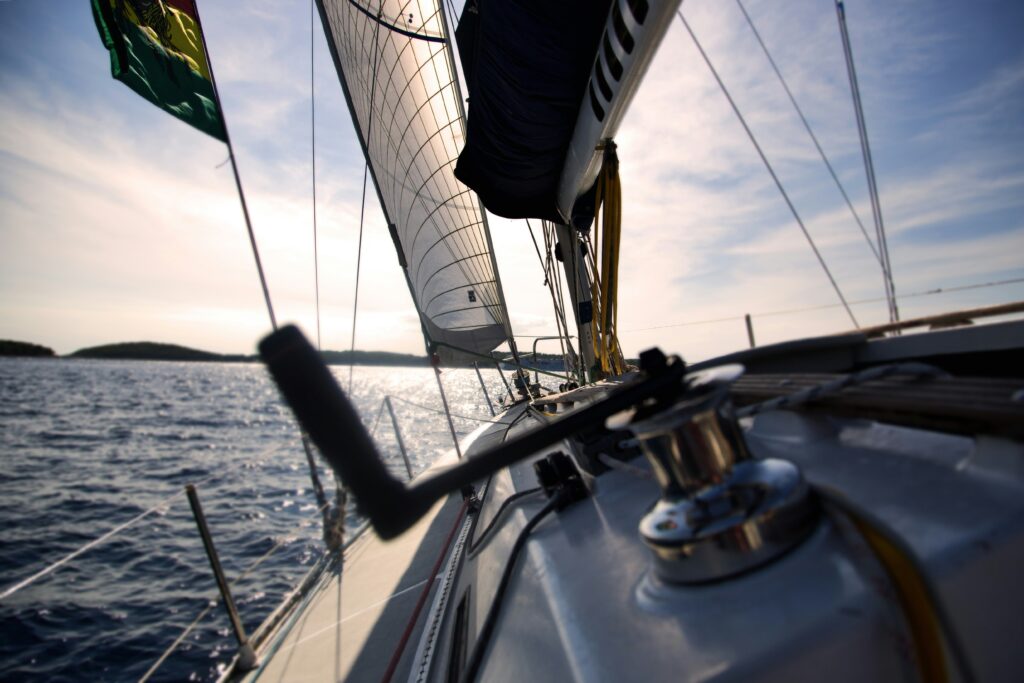
When it comes to boating , ensuring your vessel’s and crew’s safety is crucial. This includes having the right mooring systems and equipment to secure your boat. Let’s take a closer look at some key components.
Anchor and Cleats: Docking and Anchoring Basics
Every boat needs a reliable anchor to keep it in place when not in motion. Anchors come in various types, such as plow, fluke, or mushroom, each suited for different seabeds. But having the right anchor isn’t enough; you also need strong cleats. Cleats are metal fittings on the deck where you tie off your mooring lines.
Properly using cleat hitch knots ensures that your boat is securely tied to the dock. Always make sure the cleats are bolted down well to avoid mishaps. For safety, keep spare mooring lines on hand.
Fenders: Protecting the Vessel
Fenders are crucial for preventing damage to your boat while it’s docked. These are essentially bumpers that absorb shock and prevent scratches or dents. You can find fenders in various shapes and sizes, from cylindrical to round.
The key is to hang them at the correct height to cushion your boat and the dock or other vessels. Regularly check your fenders for wear and tear, and replace them if they show signs of damage. Always have a couple of extra fenders in storage, just in case.
Engine and Propulsion
A boat’s engine and propulsion system are the heart and muscles that drive it through the water. From various types of engines to the way propellers function, these elements work together to ensure smooth sailing.
Propellers: Turning Energy into Motion
A propeller takes the power from the engine and converts it into thrust, moving the boat forward. Whether the engine is an inboard engine housed within the hull or an outboard engine mounted on the stern, the propeller’s role is crucial.
The propeller blades create a difference in water pressure, pulling water in and pushing it backward, propelling the boat forward. The size and shape of the propeller blades impact speed and efficiency.
Engines and propellers have to be well-matched. For example, a big boat needs a larger propeller to push more water. Maintenance is also vital to keep the system in top shape.
In short, without a functioning propeller, your boat isn’t going anywhere.
Supplementary Boat Parts
Knowing about the extra parts that make it even better is important to enjoy a smooth and safe boating experience. We’ll explore components that keep your boat dry and make recreation more fun.
Bilge and Bulkheads: Keeping Water at Bay
The bilge is the lowest part of the boat, where water can collect. Water can seep in from splashes, leaks, or even rain. A bilge pump is used to pump this water out. Without it, you’d be constantly bailing out water like a sailor in old times! I always recommend having a reliable bilge pump.
Bulkheads are vertical partitions that divide the boat into sections. They give the boat structure and help prevent flooding. Imagine one section getting flooded; bulkheads keep the water from spreading. It’s like having watertight walls inside your boat.
You usually find bilge pumps near the bilge, often installed to pump water out when it reaches a certain level automatically. That way, less worry for you. Bulkheads, meanwhile, are positioned at crucial points to ensure your boat remains stable and safe.
Swim Platforms and Casting Decks: Recreation and Sport
Swim platforms are flat surfaces at the back of the boat, just above the waterline. They make it easy to get in and out of the water. If you like swimming or just dangling your feet in the water, you’ll love it. A good platform should be sturdy and slip-resistant.
Casting decks are spaces on the boat designed for fishing . They give you a stable area to cast your line. These decks often come with livewells to keep your catch fresh. Imagine standing on a firm deck and reeling in a big one without losing your balance—that’s what a casting deck is for.
Both swim platforms and casting decks are designed to enhance fun moments on the water, adding both convenience and enjoyment.
Types and Functions of Boats

There are various types of boats, each designed for different purposes and functions. Some are used for recreation, while others are essential for fishing or transportation.
Local Traditions and Various Vessel Functions
Local traditions often influence boat designs. For example, whaleboats are long and narrow. They’re designed for speed and maneuverability to catch whales.
Fishing boats are equipped with fishing rods, nets, and storage for the catch. Sailboats use sails to harness the wind, making them perfect for leisure and competition.
Here’s a quick look at some boat types for different activities:
- Sailboats: Use wind for movement; used for racing or leisure
- Fishing boats: Equipped to catch and store fish
- Whaleboats: Designed for hunting whales
Each type of boat has unique features tailored to its specific function, influenced by local needs and traditions.
Boating Know-How
Knowing the parts of a boat and the terminology used in boating is essential for safe and effective operation. This guide will help you get familiar with key nautical terms.
Language of the Seas: Nautical Terminology
When you start boating, you need to learn the language of the seas. Nautical terminology helps everyone on board communicate clearly and avoid confusion.
- Bow : The front part of the boat.
- Stern : The back part of the boat.
- Port : The left side of the boat when facing forward.
- Starboard : The right side of the boat when facing forward.
Knowing these terms can help a boater direct the crew more effectively. If someone yells, “Man overboard, port side!” you need to know instantly where to look.
Also, understanding basic sailing terms like tacking and jibing is important.
In addition, a boating license often requires passing a test that includes these terms. So, mastering them isn’t just about being safe—it’s also about being legally compliant.
Study these terms thoroughly before hitting the water. They’ll make your boating experience smoother and safer.
Frequently Asked Questions
What do you call the front section of a boat.
The front of a boat is called the bow. It’s the part that cuts through the water first as you sail. Simple, right?
Can you list the main structural components of a boat?
Sure! Boats have several main parts:
- Hull : The body of the boat
- Deck : The flat surface on top of the hull
- Engine : Powers the boat
- Sails : Used on sailboats to catch the wind
What’s the term for the back end of a boat?
The stern is the back end of a boat . It often influences the boat’s stability and handling.
What are the different sides of a boat known as?
There are specific terms for the sides of a boat:
- Port : The left side when you’re facing forward
- Starboard : The right side when you’re facing forward
Could you name some parts unique to a fishing boat?
Fishing boats have unique parts, such as:
- Livewell : A tank for keeping fish alive
- Rod holders : For securing fishing rods
- Outriggers : Extendable poles for trolling
What common features are found on a yacht?
Yachts often come with luxurious features:
- Cabin : Enclosed space for sleeping and living
- Galley : Boat’s kitchen
- Flybridge : An upper deck with a steering station

administrator
David Ciccarelli, is the Founder and CEO of Lake. He is based in Toronto, Canada, and is an expert in management, business administration, strategy, product development, and customer experience. His educational achievements include the Owner President Management Program at Harvard Business School (2019-2022) and the QuantumShift Program at Ivey Business School in 2017, aimed at CEOs of growing businesses.
- Parts of a Boat
Related Posts

August 18, 2024
Boating: Your 10-Step Guide to Driving a Boat Safely
Boating is one of the most exhilarating ways to embrace […]

Water Skiing Essentials: Tips and Tricks for a Thrilling Experience
Water skiing is an exhilarating surface water sport where individuals […]
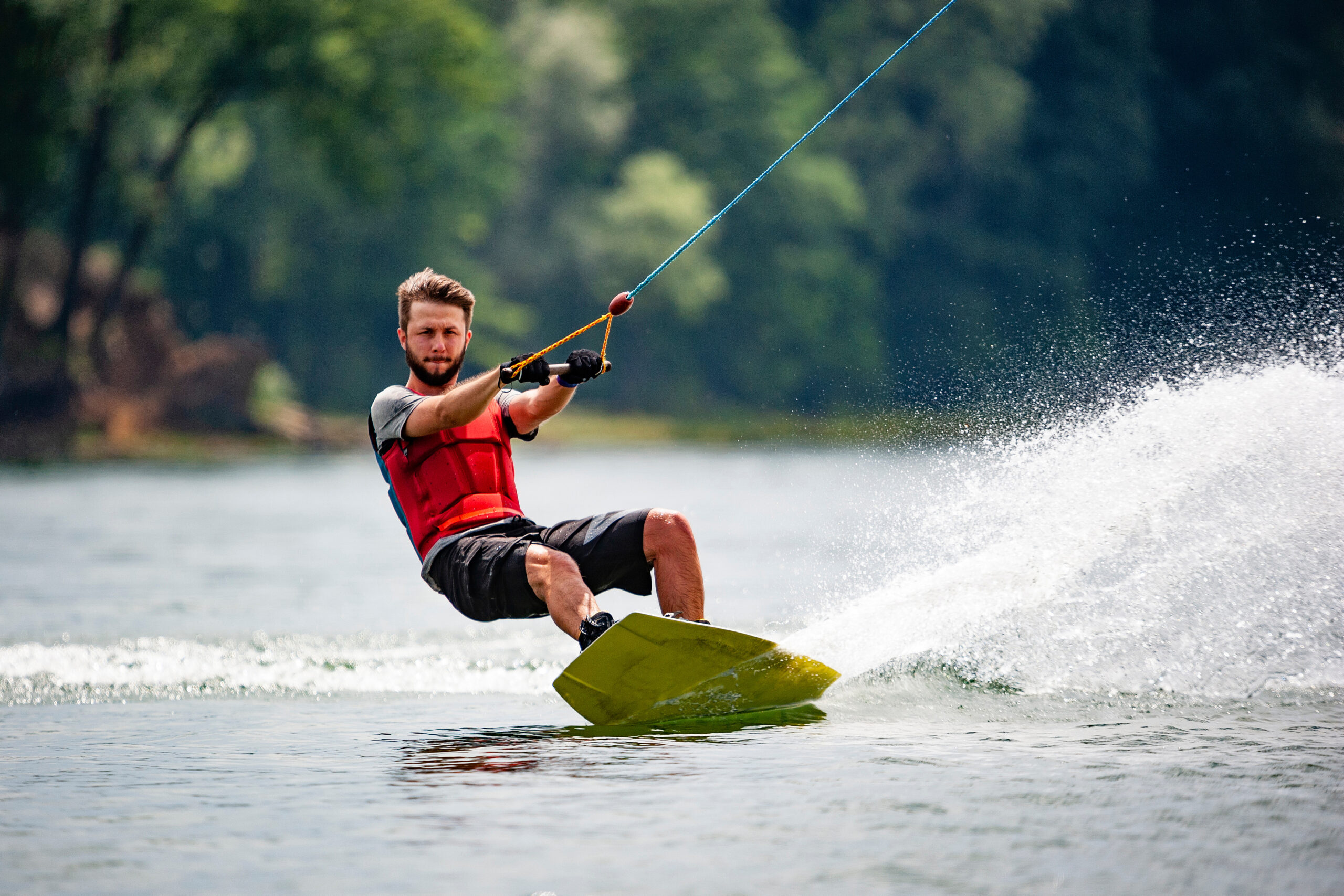
May 31, 2024
Wakeboarding Fun: Tips and Techniques for Every Skill Level
Wakeboarding Tips and Techniques, For Beginners and Pros Wakeboarding is […]
Don't have an account yet? Register
Already have an account? Sign In
Reset Password
Please enter your username or email address, you will receive a link to create a new password via email.

What Are the Parts of a Yacht Called? (Discover Here)

Are you curious about the parts of a yacht? From the hull to the cockpit and rigging, the construction of a yacht is a unique blend of form and function.
In this article, well explore what a yacht is, the different parts that make up a yacht, and how each plays an important role in the overall design.
So, if youre ready to explore the world of yachts, lets dive in and discover what each part of a yacht is called!.
Table of Contents
Short Answer
Yachts typically have three main parts that make up their structure: the hull, the deck, and the superstructure.
The hull is the main body of the watercraft, and is usually made of fiberglass or wood.
The deck is the top surface of the yacht, and is typically made of wood or composite materials.
Finally, the superstructure is the part of the yacht that contains all of the accommodations and amenities, such as cabins, bathrooms, and seating areas.
What is a Yacht?
A yacht is a luxurious vessel typically used for recreational activities such as fishing, cruising, and sailing.
While the design of each yacht may vary, all yachts have certain parts and components in common.
Knowing the different parts of a yacht and what they are called is essential for those looking to purchase or operate one.
In this blog post, well take a look at the parts of a yacht and discuss their purpose and function in more detail.
The hull is the main body of the yacht, providing the structure and shape of the vessel.
The deck is a flat surface that covers the hull and provides access to the cabin, cockpit, and other parts of the yacht.
The keel is a fin-shaped structure that helps the yacht stay balanced and steer in the water.
The cabin is the living area of the yacht and often contains bedrooms, a kitchen, and other amenities.
The cockpit is the part of the yacht used for steering and navigation, while the rigging consists of the wires and masts that support the sails.
All of these parts are essential for the safe and efficient operation of a yacht.
In addition to the parts mentioned above, there are also a number of accessories and equipment that can be installed on a yacht to enhance its function and performance.
These include anchors, winches, and sails.
It is important to note that the names of these accessories may vary depending on the type of yacht and its manufacturer.
By familiarizing yourself with the different parts of a yacht and what they are called, you can ensure that you have a safe and enjoyable experience when operating one.
Whether you are looking to purchase one or just curious to learn more, it is helpful to have a basic understanding of what makes a yacht tick.
Parts of a Yacht

When it comes to the parts of a yacht, the hull, deck, keel, cabin, cockpit, and rigging are the main components.
The hull is the main body of the yacht and provides the structure.
It is usually made of fiberglass, steel, or aluminum and is designed to be streamlined and watertight.
The deck is the flat, horizontal surface that covers the hull and provides access to the cabin, cockpit, and other parts of the yacht.
The cockpit is the part of the yacht used for steering and navigation and is typically located in the stern of the yacht.
Lastly, the rigging consists of the wires and masts that support the sails and is responsible for providing the power for sailing.
In addition to the main components, there are a few other parts of a yacht that are important to note.
These include the rudder, which is used to steer the yacht, and the anchor, which is used to keep the yacht in place.
Other parts include the bow and stern thrusters, which are used to help maneuver the yacht in tight spaces, and the winches, which are used to raise and lower sails.
All of these parts, along with the main components, help to make a yacht a reliable and safe vessel.
The hull is the main part of a yacht, providing the structure and support that allows the vessel to stay afloat.
The hull is usually made of fiberglass, wood, or aluminum, and is often reinforced with a steel frame to increase its strength and durability.
The hull is typically divided into two sections: the main deck, which contains the cabin, cockpit, and other amenities; and the bottom, which houses the engine, fuel tank, and other equipment.
The hull is also responsible for providing buoyancy, which allows the yacht to float in the water.
The shape of the hull depends on the type of yacht, with different designs providing different levels of performance and capabilities.
Racing yachts , for example, often have a narrower hull shape that allows them to cut through the water more efficiently, while cruising yachts typically have a wider hull shape that provides more stability.

The deck of a yacht is the flat surface that covers the hull and provides access to the cabin, cockpit, and other parts of the yacht.
It is usually made of fiberglass or wood and contains various components that are essential for the yachts operation.
The deck typically includes a helm station, navigation lights, and a mooring cleat.
It also provides a place to mount the boats instruments, such as a compass and GPS.
The deck is also home to the boats various rigging components, such as the masts, booms, and winches.
These components are essential for the boats sail operation, allowing it to be steered and navigated while under sail.
The deck also serves as the main platform for moving around the boat, providing the crew with a safe and secure place to walk and work.
Lastly, the deck provides a great vantage point for admiring the view, whether it be from the bow, stern, or sides of the boat.
The keel of a yacht is a fin-shaped structure located at the bottom of the boat.
It is designed to provide stability and improve the yachts steering performance.
The keel also helps the yacht cut through the water more efficiently and reduces drag, which can improve speed.
In addition, the keel is an important part of the yachts design and contributes to its overall shape and aesthetics.
The keel can be made from a variety of materials, such as fiberglass, steel, or wood, and can be either full or fin keels.
Full keels provide greater stability and are better for navigating rougher waters, while fin keels are lighter and more aerodynamic.

When it comes to luxury and leisure, few things can top the experience of sailing on a yacht.
Whether youre cruising the high seas or fishing in the bay, a yacht is the perfect way to get away from it all.
But before you start your nautical adventures, its important to understand the different parts of a yacht and what theyre called.
One of the most important parts of a yacht is the cabin.
The cabin is the living area of the yacht, where you can relax and enjoy the ride.
The cabin typically houses the bedrooms, kitchen, and other amenities.
Depending on the size of the yacht, the cabin can also include a lounge, wet bar, and dining area.
Its the perfect spot to unwind after a long day on the water or entertain family and friends.
When it comes to decorating the cabin, the possibilities are endless.
From traditional nautical dcor to modern, minimalist designs, you can create a space that reflects your own personal style.
The cabin is also a great place to install the latest technology, such as high-definition TVs, Wi-Fi, and sound systems.
With the right features, you can enjoy a truly luxurious experience.
The cabin is the heart of a yacht, and the perfect spot for you and your guests to relax and enjoy the journey.
With the right design and amenities, the cabin can transform your yacht into a home away from home.
Cockpit and Rigging
Cockpit and rigging are two essential parts of a yacht.
The cockpit is the part of the yacht used for steering and navigation.
It is typically located aft of the cabin and may be enclosed or open, depending on the design.
It’s the central place where the captain and crew can see all the instruments needed to control the yacht, making it the perfect spot to take in the view and enjoy the journey.
Rigging consists of the wires and masts that support the sails.
These are used to increase the yachts speed and enable it to move more efficiently through the water.
The masts are held in place by a series of stays and shrouds, while the sails are attached to the masts and held down by halyards and sheets.
Rigging is a complex system that requires regular maintenance and attention, which is why it is important to have a knowledgeable and experienced crew on board.
Together, the cockpit and rigging allow a yacht to be operated safely and efficiently.
They are essential for maneuvering the yacht and controlling its speed, making them one of the most important parts of a yacht.
It is important to understand the different parts of a yacht and how they work together to ensure a safe and enjoyable experience.
Final Thoughts
Now that you know the parts of a yacht and their purpose, you can confidently explore the waters in your own vessel.
Whether youre a seasoned sailor or just starting out, understanding the structure of a yacht is essential for a safe and enjoyable experience.
So, go ahead and plan that next adventure youve got the knowledge to make it a success!.
James Frami
At the age of 15, he and four other friends from his neighborhood constructed their first boat. He has been sailing for almost 30 years and has a wealth of knowledge that he wants to share with others.
Recent Posts
When Was Banana Boat Song Released? (HISTORICAL INSIGHTS)
The "Banana Boat Song" was released in 1956 by Harry Belafonte. This calypso-style song, also known as "Day-O," became a huge hit and remains popular to this day for its catchy tune and upbeat...
How to Make Banana Boat Smoothie King? (DELICIOUS RECIPE REVEALED)
To make a Banana Boat Smoothie King smoothie at home, start by gathering the ingredients: a ripe banana, peanut butter, chocolate protein powder, almond milk, and ice. Blend the banana, a scoop of...
32 Parts of Boat & Their Function [Names & Terminology]
In this article, you will learn the different parts of boat and their functions . All are explained with Names & Pictures .
You can also download the PDF file of this article at the end.
The boat is a small vessel that is used for traveling over water, mainly propelled by an engine or by oars to move the vessel. The term boat refers to a variety of different types and sizes of watercraft but is generally smaller than a ship, which may be distinguished by its larger size, shape, cargo, or passenger capacity.
Small boats are usually found on inland waterways such as rivers and lakes or in protected coastal areas. Whereas other types, such as whaleboats, were used in offshore environments. Boats are vessels that can be carried on ships in modern naval terms.
Boat manufacturing methods vary with their intended purpose, available materials, or local traditions. Furthermore, there are many parts of it that most people are not aware of. Before we get to ride on the water in a boat, we need to learn a few specific words that are all used to describe common parts of boats.
Let’s understand them one by one below.
Read Also: Different Types of Ships and Their Functions [Names & Images]
Parts of Boat
The following are the important parts of boat:
- Port and starboard
- Casting deck
- Swim-platform
- All-round light
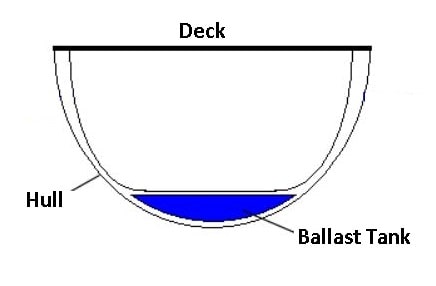
In a boat, ship, submarine, or other floating structure, ballast refers to a compartment that contains water. The water from the ballast tank must move in and out to balance the ship. The reason for installing this part is to improve the stability and performance of the boat.
The ballast is typically placed in the bottom of the hull, resulting in a very high center of gravity . You need a lot of ballast to keep the boat tight. A boat that does not have ballast will have difficulty navigating the treacherous waters.
A hull is commonly referred to as a watertight body or shell of a boat. It may open at the top, such as a sailboat, or it may be completely or partially covered by a deck.
Gunwales are provided on the upper sides of the hull of the boat. In nautical terms, the waterline is the point where the hull meets the surface of the water. Modern types of cruise ships are built with hulls consisting of heavy steel panels welded together.
In a ship, a deck is a compartment or a permanent cover over the hull. The upper deck of a boat or ship is the horizontal structure that serves as the primary working surface, strengthens the hull, and forms its roof. This part is usually located on top of the hull where you can walk or work.
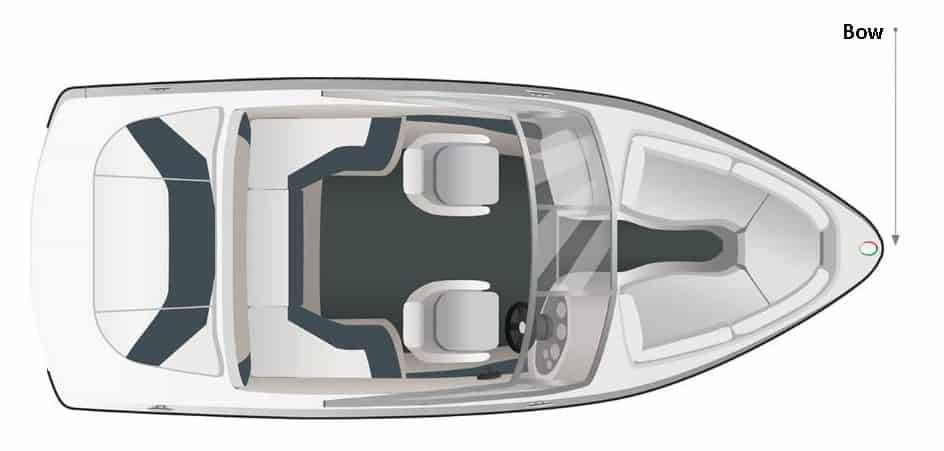
The area at the front of the boat is commonly referred to as the bow. When looking at the bow, the left side of the boat is towards the port. It is important to know where the bow is in order to define two other common sailing terms: port and starboard.
The name ‘bow’ was given to the front part of the ship because, in Medieval ships, the strakes (planks) had to be bent or ‘bowed’ to make the curved or ‘bowed’ part of the ship cut through the water better.

The area at the back of the boat is commonly referred to as the stern. When people originally mentioned the stern of a boat, they meant the port aft section. However, nowadays, if you hear the word stern, it means the entire rear of the boat. In addition, this part is highlighted by a white navigation light at night.
Read Also: Working of Leaf Spring Suspension System
#6 Port and Starboard
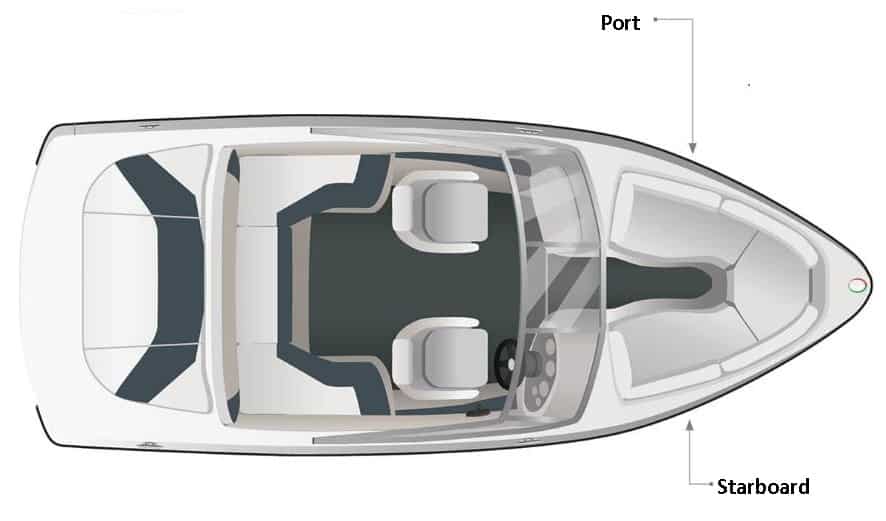
In reference to the bow of the boat, port refers to the left side, while starboard refers to the right side. It is the case for vessels with bilateral symmetry that the left and right sides are mirror images of each other. There is one asymmetrical feature in that access to boats, ships, and airplanes are mostly on the port side (hence the name).
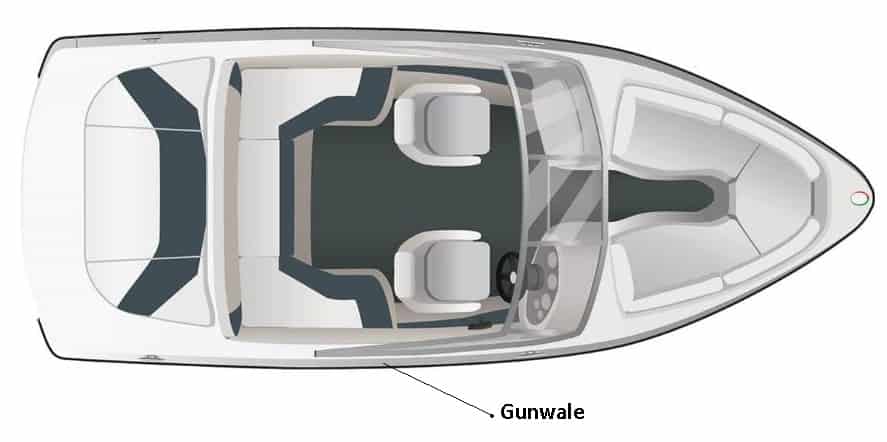
The upper edge of the side of a ship or boat is called a gunwale. Also known as a gunnel, this is usually where the deck and rudder come together. On a canoe, the gunwale usually has a wide edge at the top, supported with wood, plastic, or aluminum, to carry the sway.
The reason it is called a gunwale is that from the earliest days of the navy, the top edge of the ship was a very handy place to store a gun to defend against enemies and pirates.
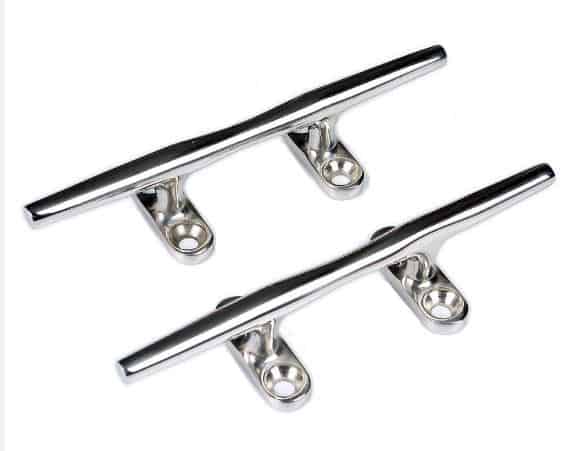
A cleat is a device for securing a rope in a boat or ship. The cleat is usually made of wood, plastic, or metal fittings which are used for tying or looping a line. It can be found on a boat or dock.
These are iconic pieces of marine technology not limited to sailboats. However, cleats are more important on sailboats than on any other type of ship.
A bilge is a compartment at the lowest point of a boat’s hull that collects water. If the boat is not supported by water, this part will rest on the ground. The boat will sink if too much water enters the bilge too quickly. To avoid this, the bilge also has a pump that helps remove the water collected in the bilge, which is located under the inside of the hull.
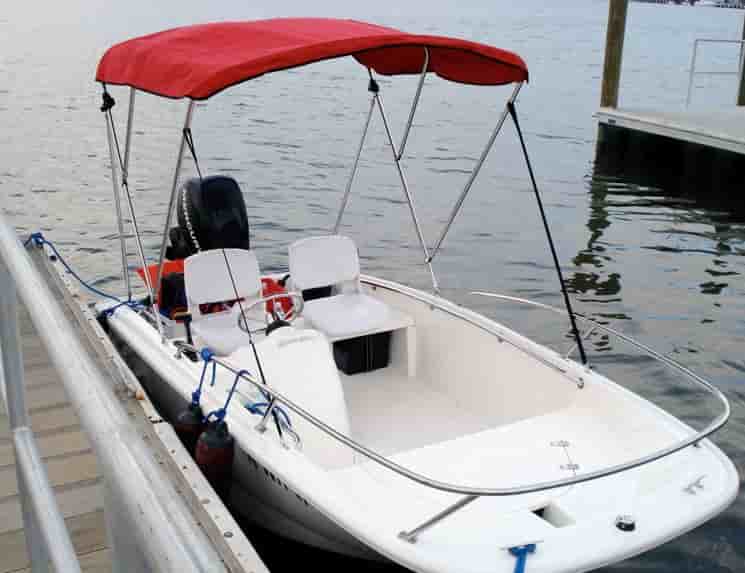
It is a canvas or composite top attached to the boat to provide protection from the sunlight. As a protection from the sun, it does not provide any protection from wind, rain, or spray when moving at any speed.
This top only provides protection when the boat is stationary, and there is no wind. In addition to its function, it can also be personalized and come in a variety of colors to fit a variety of boats.
Read Also: Important Parts of Bike Engine and Their Functions
#11 Propeller
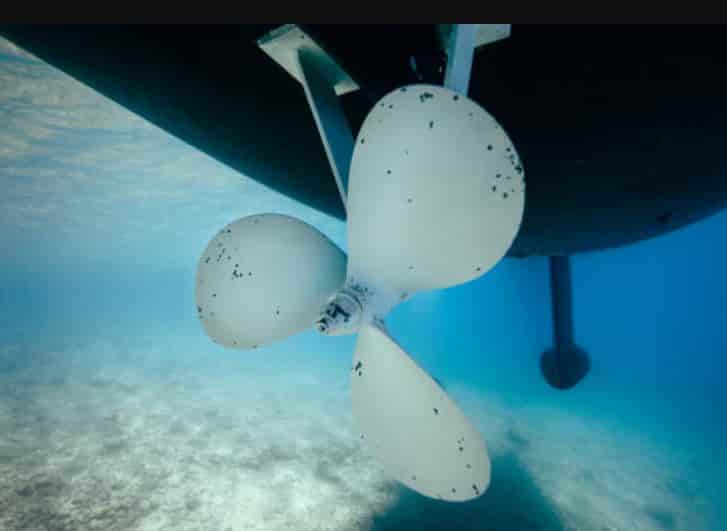
A propeller is a rotating device having blades to move a boat forward or backward through the water. It consists of a rotating hub and radiating blades, which are set to a pitch to form a spiral and, when rotated, exert linear thrust on a working fluid .
A propeller, known as a ‘screw’ for its form, is a fan-like machinery attached to the stern of a ship. They are available in many varieties and designs and can be left-hand turns or right-hand turns.
#12 Bulkhead
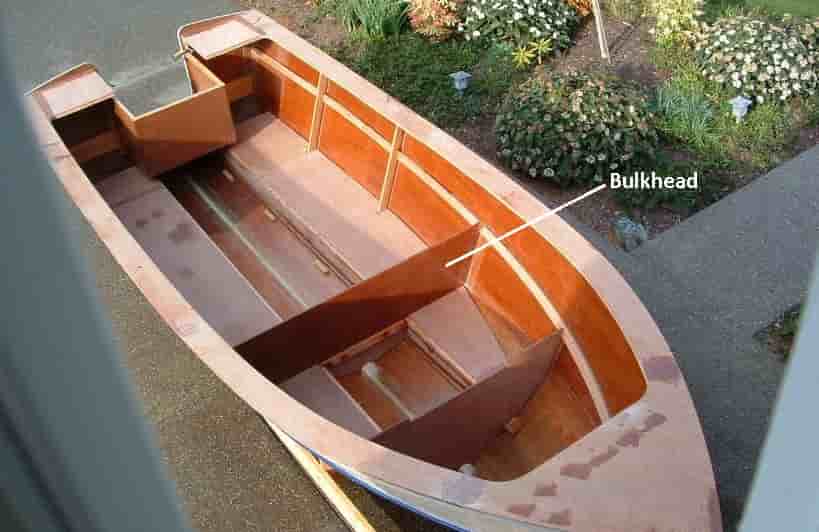
A bulkhead is a straight wall within a boat’s hull. Its main purpose is to prevent corrosion caused by the water that surrounds your property and acts as a barrier between it and the water. Their main purpose is to increase the structural rigidity of the vessel.
In addition, it creates a watertight compartment that can hold water in the event of a hull break or other leak. Some bulkheads are also built with fire resistance to receiving compartmentalization, a passive fire safety measure.
A cabin is a room inside a boat, referring to the whole interior of the boat. Simply put, cabins are bedrooms on boats, although they are designed for sleeping. Luxury yachts typically serve 10-12 guests with at least 4-5 cabins.
#14 Cockpit
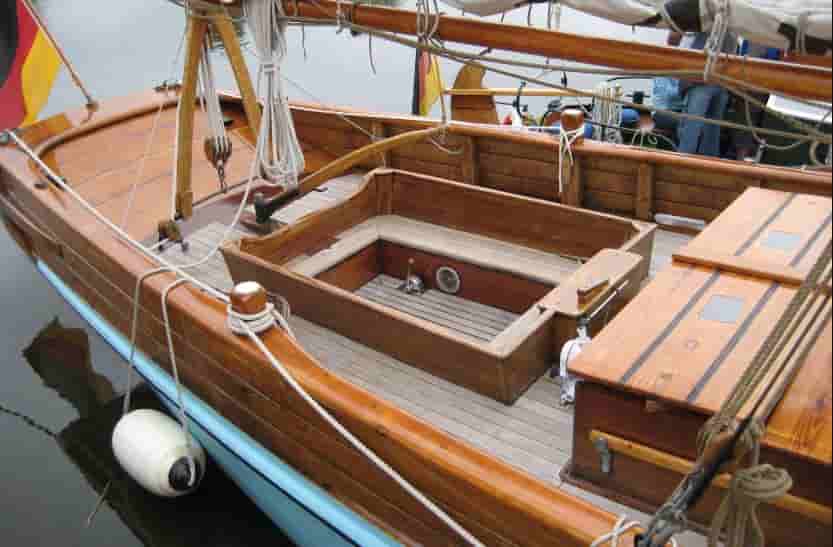
A cockpit is an area where the boat’s controls are located. Modern boats may have an enclosed cockpit rather than an open well on deck in deck outside a deckhouse or cabin. Smaller boats usually have a cockpit towards the rear of the boat, while larger vessels may offer a center cockpit with protection from rain, sun, and wind.
#15 Gallery
Generally, the gallery in a boat refers to the kitchen. The kitchen may be located inside the boat or outside on the deck, depending on the design of the boat.
Read Also: 20 Car Interior Parts and Their Functions [with Pictures]
#16 Casting Deck
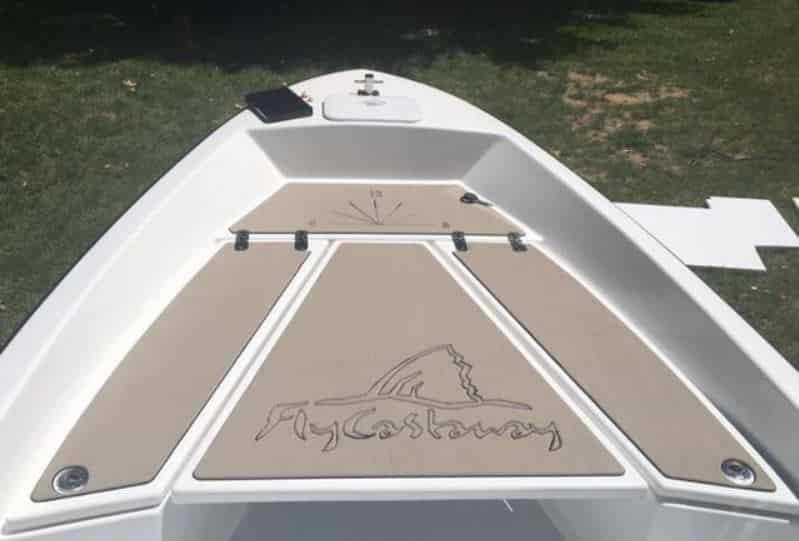
It is an elevated surface that is attached to the front or back part of the boat to allow the fisherman to fish without being obstructed by objects and have a better view of the water.
Forward casting decks often have storage or a live well below, perhaps a casting chair seat mount, as well as molded toe rails for improved protection.
#17 Dinette
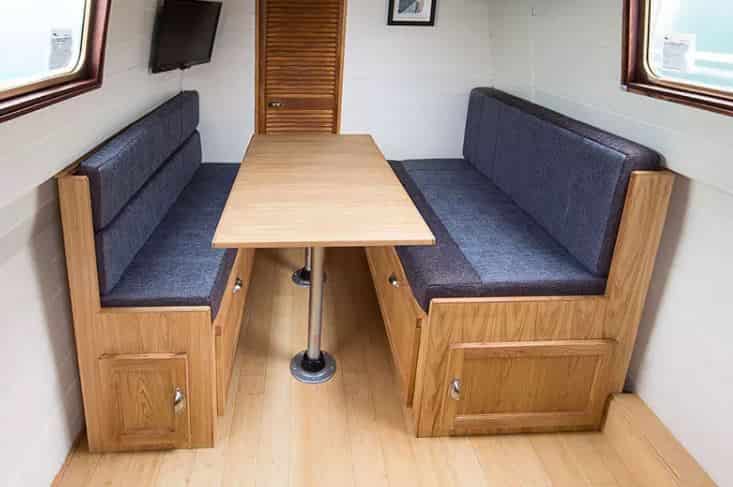
The dinette is located in the center of the boat, where the table and seats are used for dining. It is a flexible piece of furniture often found on narrow boats and some wide-beam canal boats as well.
A dinette is usually composed of a table and two to four chairs. Its function is to provide a seating or dining area, and small items can also be stored under the seating units. Some dinettes can also convert into single or double beds.
#18 Hard Top
As the name suggests, hardtops are rigid roofs that sit on top or console of a boat. The primary purpose of this roof is to provide protection from the elements for the driver and sometimes the passengers.
These roofs are more expensive than canvas tops, which is why budget-conscious boaters might not choose them over canvas tops. With the smaller vessel and forward windscreen alloy runout, you don’t really have the option of fitting a hardtop.
#19 Flybridge
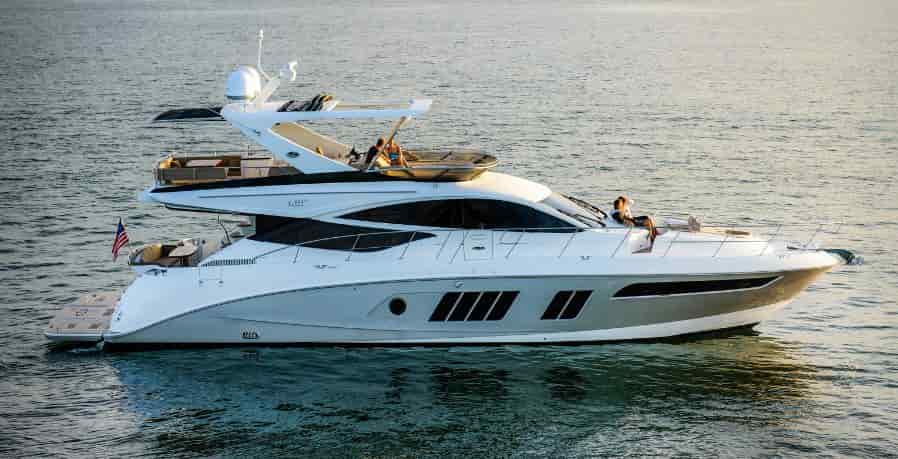
A flybridge is an area on top of a boat cabin, usually containing a steering system and sometimes a social space. In a cabin cruiser, it is located above the bridge on the cabin roof and usually contains a duplicate set of navigating instruments.
On larger boats, it is usually a raised second bridge placed on top of the superstructure, which has a steering wheel and other navigational instruments and can also be used as a seat and storage area.
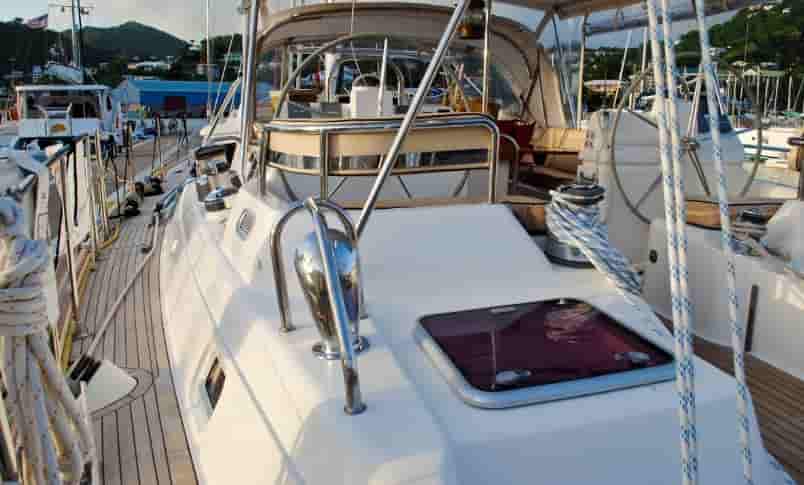
A hatch is a cover or portal through which storage, cargo, or additional living space within a boat can be accessed on deck. Also, it is an opening in the deck or cabin of a boat that serves as a window or door.
The primary purpose of hatch covers is to prevent water from entering cargo holds and to protect the cargo from getting wet and damaged. A well-constructed hatch should be waterproof, supporting the weight of people and objects placed on it.
Read Also: Types of Metals: Explained with Their Properties and Uses
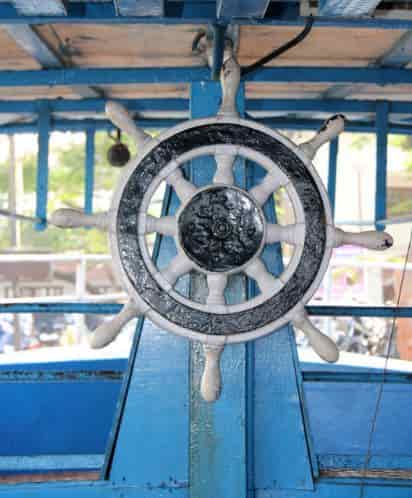
A helm is a mechanism that keeps the boat moving. A helm is a steering station consisting of engine controls and a wheel or joystick. It is usually located on a raised structure on the deck of a boat.
#22 Livewell
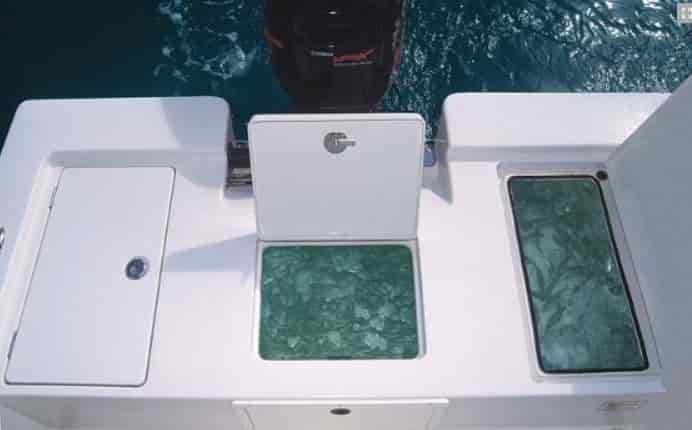
A Livewell is a type of storage tank designed to keep live fish or bait caught while fishing. This device serves to keep the water aerated and pump fresh water from nearby bodies of water into the tank.
The method for determining the required size of a Livewell is that each one-inch-long fish requires one gallon (3.8 liters) of water. In addition, they are two other important factors in Livewell functionality maintaining proper temperature and removing metabolic waste.
#23 Rigging
Rigging consists of a system of ropes, cables, and chains that support the masts of a boat. Ragging is further divided into two categories, standing and running. The standing rigging supports the mast, and the running rigging controls the orientation of the sails and their degree of reefing.
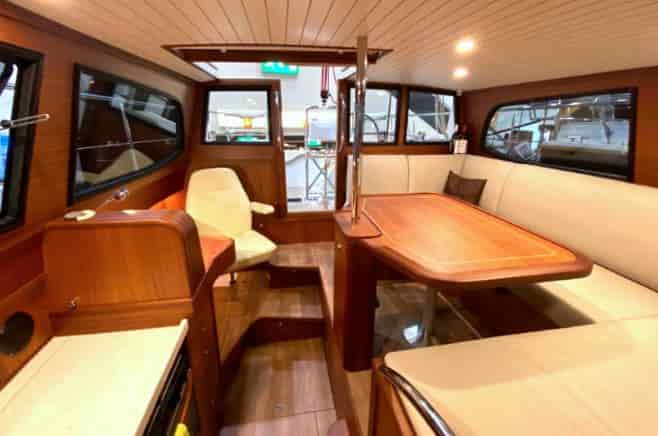
A saloon is a room built into a boat that is an internal social space used as a living room in a house. In addition, it is also known for a yacht cabin area dedicated to seating relaxation, often combined with a dining table.
It is a composite structure designed to hold a roof to protect the boatman from the sun. A T-top is a metal frame mounted on the center console of the deck with a canvas or hard top.
By installing this part, fishers will have access to the standing-height shade while remaining unobstructed to move and cast. In general, T-tops are manufactured from high-quality marine aluminum extrusions , anodized for a longer lifespan.
Read Also: Basic Parts of Car Wheel Assembly and Its Function
#26 Transom
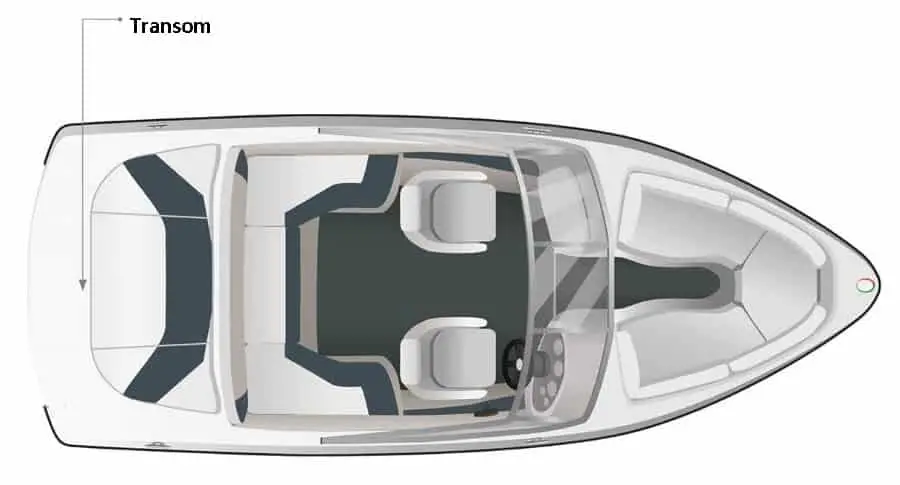
The transom is found at the rear of the boat, comes up from the bottom of the hull, and connects the two hull sides together. This is the area of the boat where the motor is attached.
In pontoon boats, the transom is typically metal and is located at the stern. This is essential because the transom extends the life of the boat’s rear material while maintaining the stern to support the added weight.
#27 V-Berth
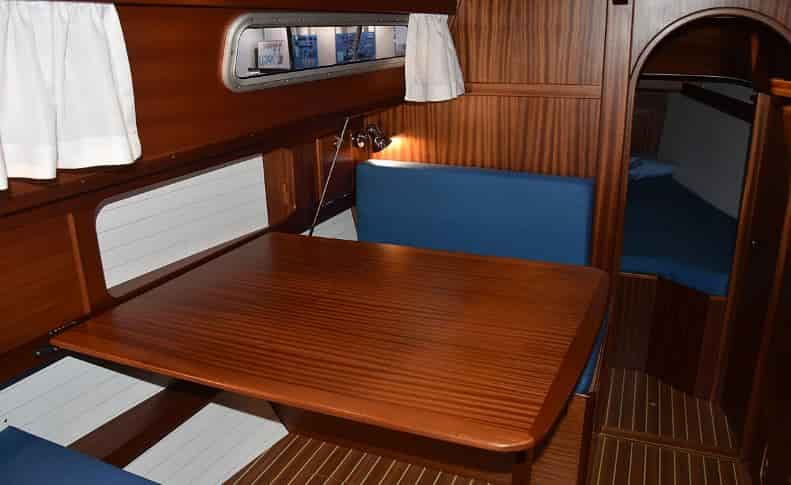
Often boats have a bed in the extreme forward end of the hull. In general, these beds are triangular due to the shape of the hull, although most have a triangular notch cut out of the middle of the aft end, making them more like a V-shape.
This notch can usually be filled with a detachable board and cushions, forming a double bed. In the United Kingdom, it is not very common to use the term “V-berth.” Instead, the entire cabin (forepeak) is more commonly referred to.
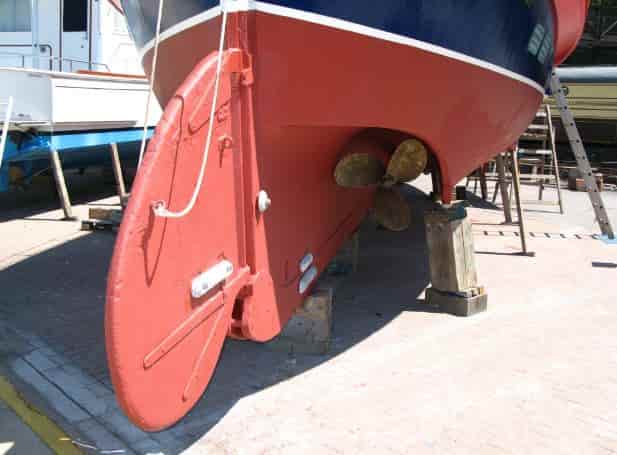
The rudder is the part of a boat steering mechanism that is mounted outside the hull, usually at the stern. A rudder works by redirecting the fluid past the hull, thus giving the craft a yawing or turning motion.
Basically, a rudder is a flat plane or sheet of material that rests after the stern, tail, or end of the craft. A rudder can also be used in a large ship, boat, submarine, hovercraft, aircraft, or other vehicles .
#29 Swim Platform
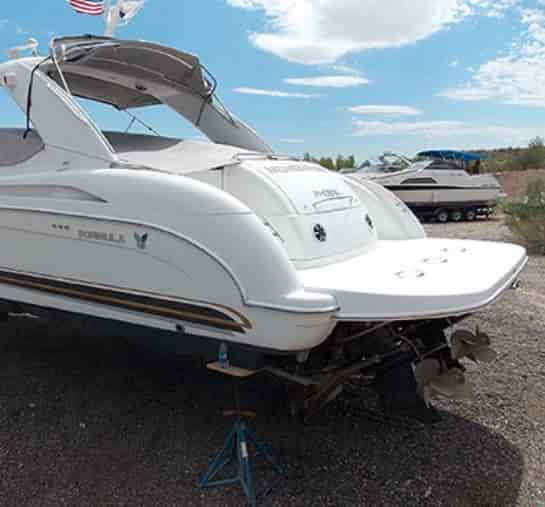
Swim platforms are fixed to the transom or aft portion of the boat to facilitate entry and exit from the water. It provides a place to board a boat when tethered to the side or stern. Water sports such as swimming, wakeboarding, and skiing can be enjoyed from a floating dock along this stretch.
#30 Console
It is an elevated structure that usually holds the steering station and may include a toilet or stowage space. The boat console also houses the ignition , trim controls, radio, and other electronic equipment, switches, etc.
In addition, it allows easy access to the bow, stern, and sides of the boat. In larger center console boats, smaller berths may also be located inside the console and below the deck. A center console is usually powered by an outboard motor and may have one or two, or even five, in the case of a very large model.
Read Also: 20 Car Interior Parts: Explained with Name & Functions
#31 All-round Light
An all-around light is a white light installed on a boat that shines continuously on the horizon in an arc of 360 degrees. These lights allow you to determine which direction the boat is headed. In addition, this light acts as an anchor light when the edge light is wasted.
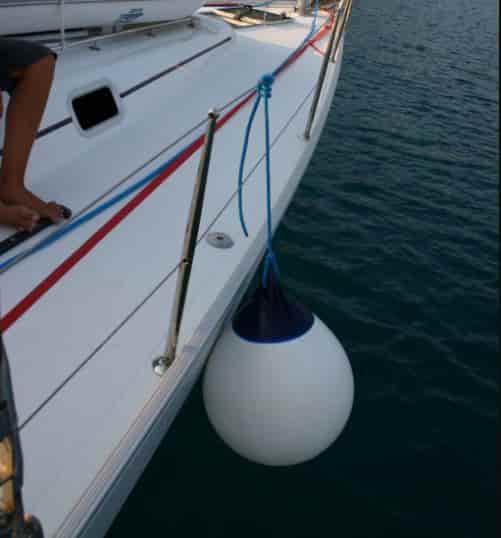
In boating, a fender is a bumper used against a jetty, wharf wall, or other vessels to absorb the kinetic energy of a boat. As it protects ships and berthing structures from damage, it is used on all types of ships, from cargo ships to cruise ships, ferries, and personal yachts.
Read Also: Types of Turbochargers are Best? Pros & Cons
Wrapping It Up
That’s it. Thanks for reading. I hope I have covered everything about this topic . If I missed something, or if you have any doubts, let me know in the comments. If you liked this article, please share it with your friends.
Want free PDFs direct to your inbox? Then subscribe to our newsletter.
Type your email…
Download PDF of this article:
You might like to read more in our blog:
- Essential Parts of Bicycles & Their Functions [Pictures]
- 30 Basic Parts of Motorcycle & Their Functions [Explained]
- A Complete List of Car Body Parts [Names & Functions]
- important List of Car Engine Parts: Their Function (Pictures)
About Yousef
He is a mechanical engineering student, he likes to write about engineering stuff and he is really interested in learning about new technology in machines.
4 thoughts on “32 Parts of Boat & Their Function [Names & Terminology]”
Thank u I will follow and share your post!!
Thank you so much.
Please notify me about aerodynamic, renewable energy conversion and process control and experiment designs for engineer, I need short note from which best explanation of other your engineering post,which very good and more understandable.
Thanks for your response. I will definitely write on this topic in the future.
Leave a Comment Cancel reply
Notify me of follow-up comments by email.
Notify me of new posts by email.
This site uses Akismet to reduce spam. Learn how your comment data is processed .

2 people are rescued from a disabled yacht off the Australian coast
The Associated Press
September 2, 2024, 11:53 PM
- Share This:
- share on facebook
- share on threads
- share on linkedin
- share on email
SYDNEY (AP) — Two people were rescued unharmed Tuesday after spending a night aboard a disabled yacht in heavy seas off the Australian coast.
The 60-year-old man and a 48-year-old woman were rescued at 7:30 a.m. from their 19-meter (62-foot) yacht, which was abandoned 300 kilometers (185 miles) east of the New South Wales state coast, Police Chief Inspector Anthony Brazzill said. The pair were expected to reach Sydney aboard a police boat Tuesday night.
The pair had activated their emergency beacon around 1 p.m. Monday, about 185 kilometers (115 miles) east of the New South Wales coastal town of Nowra, police said.
The yacht, “Spirit of Mateship,” had experienced a mechanical failure, lost a rudder, was taking water and was drifting east away from the shore, Brazzill said. With an ocean swell of 5 to 6 meters (16 to 20 feet) and winds of up 110 kilometers (70 miles) per hour, he said, conditions were considered too dangerous to attempt a recue in the dark.
An air force C-130 Hercules transport plane flew to the yacht and made radio contact with the two people onboard. A police boat and an Australian navy warship reached the yacht early Tuesday.
Brazzill said a winching rescue by military helicopter was considered, but ruled out as too dangerous because of the sea conditions.
The pair were rescued in a small craft launched from the police boat, he said.
Copyright © 2024 The Associated Press. All rights reserved. This material may not be published, broadcast, written or redistributed.
Related News

Almodóvar returns to Venice with ‘The Room Next Door’ and gets a nearly 20 minute ovation

At least 10 dead or injured after a bus crashes into a group of students in eastern China, official media say

Venezuelan judge issues arrest warrant for opposition’s former presidential candidate
Recommended.
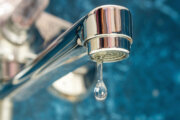
40,000 households in this part of Md. urged to conserve water during emergency repairs

A Gaithersburg artist wants you to 'pull up a chair' and talk about mental health

Legislation, trash pickups and a cookbook: Montgomery Co. students work 'toward a greener future'
Related categories:.

NZ replacing part of yacht’s hull after it…
Share this:.
- Click to share on Facebook (Opens in new window)
- Click to share on X (Opens in new window)
Daily e-Edition
Evening e-Edition
- Top Workplaces
- Things to Do
- Advertising
- Classifieds
Breaking News
Man in critical but stable condition following shooting at ct social club; suspect arrested, uncategorized, nz replacing part of yacht’s hull after it was dropped by crane on first day of america’s cup.

Emirates Team New Zealand inspects the team’s America’s Cup boat after it was damaged when a crane failed while moving it from the water to its cradle after the opening day of racing on Thursday Aug. 29, 2024 in Barcelona, Spain. (AP Photo/Joseph Wilson)

Emirates Team New Zealand head Grant Dalton inspects the foil tip of his team’s America’s Cup boat after it was damaged when a crane failed while moving it from the water to its cradle after the opening day of racing on Thursday Aug. 29, 2024 in Barcelona, Spain. (AP Photo/Joseph Wilson)

Emirates Team New Zealand’s boat is shown after it was damaged when the crane failed while removing it from the water after racing on the opening day of the 37th America’s Cup in Barcelona, Spain. (AP Photo/Joseph Wilson)
BARCELONA, Spain (AP) — Emirates Team New Zealand worked on Friday to replace a piece of the hull of its yacht that was damaged in a crane incident after its first warmup race at the America’s Cup .
The mishap happened late on Thursday when the 75-foot yacht named “Taihoro” was being removed from the water after racing.
Team leader Grant Dalton said the multimillion-dollar boat fell some six meters (20 feet) onto the support cradle at their team base inside Barcelona’s old port. Dalton said the impact sounded “like a bomb went off.” The boat was eventually lifted to get the tips of its critically important hydrofoils off the concrete ground.
On Thursday, Dalton believed the repair job could keep his defending champion team sidelined throughout the double round-robin phase that lasts through next week.
But less than 24 hours later, Dalton said enough work was done overnight to give him hope they could be back on the water sooner than he expected.
“It’s possible that we could be back out by tomorrow,” the CEO of the team and race said.
“We’re pretty lucky. If it had fallen 200 millimeters to either side it could have been a whole bunch worse, but it fell into the cradle, perfectly into the cradle,” he said. “The guys have literally cut out a hole, it looks like the Titanic.”
Missing any racing time is a setback, but it should be manageable as long as the boat can be refitted in the coming days or even weeks since as defending champions the Kiwis are guaranteed a spot in the finals in October.
The incident means New Zealand didn’t participate in the two warmup races it was scheduled for on Friday. That won’t impact the standings since its races don’t count; they are essentially only for practice to keep the team sharp for the final.
One of those races was against INEOS Britannia, which according to the rules had to start the race even though its rival couldn’t.
“We were obviously very worried that someone had gotten hurt initially, so we are very happy that everyone was safe,” INEOS helmsman Dylan Fletcher told The Associated Press about how he saw the Kiwis’ crane incident.
“You don’t really wish anyone to have bad luck or anything like that to go wrong because you just want to beat them because you’re better.”
American Magic got its first point and handed Switzerland’s Alinghi Red Bull Racing a second straight defeat after a race where both teams struggled to find wind and spent long periods of time becalmed. The race control shortened the race from six to four legs to keep it from dragging on. It still lasted 31 minutes.
“It wasn’t pretty at all. It’s just tough conditions,” American Magic helmsman Tom Slingsby said. “I would have loved to foil across the line, but we just did what we had to do to get the win.”
The light winds forced the postponement of the Americans’ scheduled race against Italy’s Luna Rossa Prada Pirelli later Friday.
One of the five challengers will be eliminated after the opening phase before the final four go to semifinals.
AP sports: https://apnews.com/sports
More in Uncategorized

Kamala Harris in Detroit on Labor Day: ‘Thank a union member’

Strikes and protests roil a divided Israel amid funerals for hostages, including California native
![By HOWARD FENDRICH NEW YORK (AP) — This is pretty much all anyone needs to know about defending champion Coco Gauff’s 6-3, 4-6, 6-3 loss to Emma Navarro in the U.S. Open’s fourth round on Sunday: Gauff wound up with more double-faults, 19, than winners, 14. It was the latest in a series of early-for-her […] By HOWARD FENDRICH NEW YORK (AP) — This is pretty much all anyone needs to know about defending champion Coco Gauff’s 6-3, 4-6, 6-3 loss to Emma Navarro in the U.S. Open’s fourth round on Sunday: Gauff wound up with more double-faults, 19, than winners, 14. It was the latest in a series of early-for-her […]](https://www.courant.com/wp-content/uploads/2024/09/2169794781_1083343715.jpg?w=525)
More losers than winners as Coco Gauff takes earlier-than-expected U.S. Open exit

Family found dead after upstate New York house fire were not killed by the flames, police say

IMAGES
VIDEO
COMMENTS
Bow - The bow is the front or forward part of the vessel. Bilge - The bilge is the lowest internal part of a boat's hull. Bulkhead - A bulkhead is a wall that divides compartments on a boat. Cabin - A cabin is an interior part of a boat that can be enclosed and is often used as a place to sleep while onboard a vessel.
Helm: The steering mechanism of a yacht is the helm. Hull: The hull is the part of a yacht or boat that floats in the water. A hull has framework inside it and a hard outer shell that you can see. Keel: The keel is the part of the hull that runs down the middle from the bow to the stern. The keel is considered the foundation or backbone of a boat.
The part of the yacht that floats in the water is referred to as the hull. Most traditional yachts have one hull, however catamarans are typically 'multi-hull' having two points of contact with the sea. Mischief superyacht was designed with an iconic French navy hull and white boot stipe.
Above: The basic anatomy of a boat is an important thing to understand as a boat owner and yacht captain. Knowing the names and terms of the different parts and sections of a boat, including certain areas, rooms and major components of all onboard systems is vital to operating and maintaining a vessel properly. Basic Boat Anatomy Hull
Parts of a boat explained. Bow: the front of a boat. Stern: the rear of a boat. Port: left side of a boat. Starboard: right side of a boat. Helm: the driver's seat. Gunwale: the top of the boat's side (upper edge). If water comes higher than the gunwale, it enters the boat. Transom: The cross-section of the rear of the boat (stern). Pilothouse: Enclosed cabin for driver and passengers.
A portion of it is submerged. The flat surface on top of the hull. This is where you walk to get around the boat. The back of a boat. It connects the two sides of the hull. The outermost top edge of a boat hull. This is where the deck and hull come together on most boats. The area of the hull that sits on the water.
Short answer parts of a yacht: The main parts of a yacht typically include the hull, deck, mast, boom, rigging, sails, keel or centerboard, rudder, and various onboard systems such as engine and plumbing. These components are essential for sailing and maneuvering a yacht on water. A Comprehensive Guide to Understanding the Different Parts of
Short answer parts of aboat: A boat typically consists of several key parts. These include the hull, deck, cabin or cockpit, keel, rudder, and various mechanical components such as the engine, propeller, and steering system. Additional features may include masts, sails, winches, and navigation instruments. 1) Understanding the Basics: An Introduction to the Parts of
18. Hatch - An opening in the deck or cabin of a boat that serves as a window or door. 19. Helm - The steering station, which includes engine controls and a wheel or joystick. 20. Hull - The body or shell of the vessel. 21. Livewell - A tank designed to keep caught fish or bait alive during fishing. 22.
Bow: The bow of a boat is the front portion of the hull. As the boat moves ahead, this is the forward portion of the boat. When standing facing the bow, the left side is called the port bow and the right side is called the starboard bow. Cabin: The cabin is the part of the boat below deck where people can sleep or spend time.
Being able to identify different parts of a boat is a basic skill that every boater should master. Understanding the anatomy of a boat will help you understa...
Bow and Stern. The bow refers to the front end of a boat, while the stern is the rear end. Each serves a functional purpose in the boat's overall design. The bow is designed to cut through the water efficiently, reducing resistance when moving forward. The stern's design and shape influence the vessel's handling, stability, and performance.
20. Saloon: ( Parts of Boat ) A saloon is a room built or incorporated into a boat that is an inner social space utilized as a living room in a house. Likewise, it is additionally known for a yacht cabin area that is dedicated to seating relaxation, frequently combined with a dining table. 21. V-Berth: ( Parts of Boat ) V-Berth is a bed in the ...
Let's begin with the directional parts of the boat: up, down, left, right, front, and back. Bow - front part of the boat. Stern - back part of the boat. Port - left side of the boat. Starboard - right side of the boat. You can tell which side is port and which side is starboard by looking at the lights. The portlight is red and the ...
About Author Rafael Gomez. Rafael Gomez is the CEO of YachtAid Marine, a leading yacht manufacturer and contractor based in Miami, Florida. With over 30 years of experience in the boat parts industry, Rafael has established himself as an expert, holding various specialized certifications, including Marine Generators and Controls Certification by Kohler and training from Global Ocean Security ...
Each component of a boat plays a role in its overall operation and experience. For instance, I've realized the importance of the hull, the main body of the boat, in keeping us afloat, and the significance of the helm, where I take control as the driver. Sailing vessels and powerboats may differ in their anatomy, with sails, masts, and rigging ...
The four basic parts of a boat are the hull, deck, engine, and sails (in sailboats). The hull is the main body of the boat, providing buoyancy and protection from water. The deck is the flat surface that covers the hull and supports the occupants and any equipment. The engine propels the boat, and the sails are used for harnessing wind energy ...
Above: Anatomy of a yacht: room names, boat parts, spaces and terms. Photo: YachtWorld/Azimut. Stepping onto a boat or yacht opens the door to unparalleled adventures on the water. With advancements like joystick controls and self-docking technology, navigating larger vessels has become accessible even to those with minimal boating experience ...
Short answer parts of the boat: The main parts of a boat include the hull (the bottom part that touches water), deck (top surface), bow (front end), stern (back end), and keel (the centerline running beneath). Other essential components are the rudder, propellers, mast or sail, and various navigation equipment. Understanding the Different Parts of
Supplementary Boat Parts. Knowing about the extra parts that make it even better is important to enjoy a smooth and safe boating experience. We'll explore components that keep your boat dry and make recreation more fun. Bilge and Bulkheads: Keeping Water at Bay. The bilge is the lowest part of the boat, where water can collect.
Parts of a Yacht. When it comes to the parts of a yacht, the hull, deck, keel, cabin, cockpit, and rigging are the main components. The hull is the main body of the yacht and provides the structure. It is usually made of fiberglass, steel, or aluminum and is designed to be streamlined and watertight. The deck is the flat, horizontal surface ...
Sometimes abbreviated "LOA." "The boat had a length overall of 21 feet, five inches, from its swim platform to the bow sprit.". Waterline Length: The length of the hull where it intersects the water, from bow to stern. Sometimes shortened to "LWL." "The superyacht has a waterline length of 102 feet.".
A rudder works by redirecting the fluid past the hull, thus giving the craft a yawing or turning motion. Basically, a rudder is a flat plane or sheet of material that rests after the stern, tail, or end of the craft. A rudder can also be used in a large ship, boat, submarine, hovercraft, aircraft, or other vehicles.
The yacht, "Spirit of Mateship," had experienced a mechanical failure, lost a rudder, was taking water and was drifting east away from the shore, Brazzill said. With an ocean swell of 5 to 6 ...
Wisconsin has over 15,000 lakes, and spending summer days on the water is a well-honored tradition. One form of outdoor recreation though, wake boating, is a source of contention in the state. These boats are specifically designed to create large waves, with ballasts, which are like tanks, that fill ...
In Wisconsin, this fight against wake boats doesn't mean an outright ban, but rather stricter limits on where wake boats can be used. Lakes at Stake, which is at the forefront of wake boat ...
The mishap happened late on Thursday when the 75-foot yacht named "Taihoro" was being removed from the water after racing. Team leader Grant Dalton said the multimillion-dollar boat fell some six meters (20 feet) onto the support cradle at their team base inside Barcelona's old port. Dalton said the impact sounded "like a bomb went off."
Emirates Team New Zealand inspects the team's America's Cup boat after it was damaged when a crane failed while moving it from the water to its cradle after the opening day of racing on ...
"We get back to the hotel at midnight or 1 a.m., slick the boat out, load everything up, and get it ready for the next crew, and that boat runs the next day," said Tewes.